Notes on tokamak equilibrium |
|
|
 . This article has
been written using GNU TeXmacs [13].
. This article has
been written using GNU TeXmacs [13].
Abstract
This document discusses the free boundary equilibrium fitting problem, fixed-boundary equilibrium problem, and magnetic coordinates.
Due to the divergence-free condition, i.e.,  , magnetic field can be expressed as the curl of a
vector field:
, magnetic field can be expressed as the curl of a
vector field:
 |
(1.1) |
where  is called the vector potential of
is called the vector potential of  . (The usefullness of this
representation is that, once
. (The usefullness of this
representation is that, once  is in this form, we
do not need to worry about the divergence-free constraint.) In
cylindrical coordinates
is in this form, we
do not need to worry about the divergence-free constraint.) In
cylindrical coordinates  , the
above expression is written
, the
above expression is written
 |
(1.2) |
We consider axisymmetric magnetic field, which means that, when
expressed in the cylindrical coordinate system  , the components of
, the components of  ,
namely
,
namely  ,
,  , and
, and  ,
are all independent of
,
are all independent of  . For
this case, it can be proved that an axisymmetric vector potential
. For
this case, it can be proved that an axisymmetric vector potential  suffices for expressing the magnetic field, i.e., all
the components of the vector potential
suffices for expressing the magnetic field, i.e., all
the components of the vector potential  can also
be taken independent of
can also
be taken independent of  .
Using this, Eq. (1.2) is written
.
Using this, Eq. (1.2) is written
 |
(1.3) |
In tokamak literature,  direction is called the
toroidal direction, and
direction is called the
toroidal direction, and  planes (i.e.,
planes (i.e.,  planes) are called poloidal planes.
planes) are called poloidal planes.
Equation (1.3) indicates that the two poloidal components
of  , namely
, namely  and
and  , are determined by a
single component of
, are determined by a
single component of  , namely
, namely
 . This motivates us to define
a function
. This motivates us to define
a function  :
:
 |
(1.4) |
Then Eq. (1.3) implies the poloidal components,  and
and  , can be
written as
, can be
written as
 |
(1.5) |
 |
(1.6) |
(Note that it is the property of being axisymmetric and divergence-free
that enables us to express the two components of  , namely
, namely  and
and  , in terms of a single function
, in terms of a single function  .) Furthermore, it is ready to prove that
.) Furthermore, it is ready to prove that  is constant along a magnetic field line, i.e.
is constant along a magnetic field line, i.e.  . [Proof:
. [Proof:
 |
 |
 |
|
 |
 |
||
 |
 |
]
(We note that  is related to poloidal magnetic
flux, as we will discuss in Sec. 1.7.)
is related to poloidal magnetic
flux, as we will discuss in Sec. 1.7.)
Using Eqs. (1.5) and (1.6), the poloidal
magnetic field  is written as
is written as
Next, let's examine the toroidal component  .
Equation (1.3) indicates that
.
Equation (1.3) indicates that  involves both
involves both  and
and  .
This indicates that using the potential form does not enable useful
simplification for
.
This indicates that using the potential form does not enable useful
simplification for  . Therfore
we will directly use
. Therfore
we will directly use  . Define
. Define
 (the reason that we define this quantity will
become clear when we discuss the forece balance), then the toroidal
magnetic field is written as
(the reason that we define this quantity will
become clear when we discuss the forece balance), then the toroidal
magnetic field is written as
 |
(1.9) |
Combining Eqs. (1.8) and (1.9), we obtain
which is a general expression of axisymmetric magnetic field. Expression (1.10) is a famous formula in tokamak physics.

Let us discuss the gauge freedom of  in the
axisymmetric case. Magnetic field remains the same under the following
gauge transformation of the vector potential:
in the
axisymmetric case. Magnetic field remains the same under the following
gauge transformation of the vector potential:
 |
(1.11) |
where  is an arbitrary scalar field. Here we
require that
is an arbitrary scalar field. Here we
require that  be axisymmetric because, as
mentioned above, an axisymmetric vector potential suffices for
describing an axisymmetric magnetic field. In cylindrical coordinates,
be axisymmetric because, as
mentioned above, an axisymmetric vector potential suffices for
describing an axisymmetric magnetic field. In cylindrical coordinates,
 is given by
is given by
 |
(1.12) |
Since  is axisymmetric, it follows that all the
three components of
is axisymmetric, it follows that all the
three components of  are independent of
are independent of  , i.e.,
, i.e.,  ,
,  , and
, and
 , which implies that
, which implies that  is independent of
is independent of  ,
,
 , and
, and  , i.e.,
, i.e.,  is actually a
spatial constant. Denote this constant by
is actually a
spatial constant. Denote this constant by  .
Then
.
Then  component of the gauge transformation (1.11) is written
component of the gauge transformation (1.11) is written
(We see that the requirement of being axial symmetry greatly reduces
gauge freedom of  .)
Multiplying Eq. (1.13) with
.)
Multiplying Eq. (1.13) with  ,
we obtain the corresponding gauge transformation for
,
we obtain the corresponding gauge transformation for  ,
,
 |
(1.14) |
which indicates  is similar to that of
electrostatic potential, i.e., adding a constant to it does not make
difference. Note that the definition
is similar to that of
electrostatic potential, i.e., adding a constant to it does not make
difference. Note that the definition  does not
imply
does not
imply  because
because  can adopt
can adopt
 dependence under the gauge transformation (1.13). If
dependence under the gauge transformation (1.13). If  is finite at
is finite at  , then
, then  is zero there.
This is the case we encounter in the equilibrium reconstruction problem.
is zero there.
This is the case we encounter in the equilibrium reconstruction problem.
 in the poloidal plane
in the poloidal plane
Because  is constant along a magnetic field line
and
is constant along a magnetic field line
and  is independent of
is independent of  , the projection of a magnetic field line onto
, the projection of a magnetic field line onto  plane is a contour of
plane is a contour of  .
Inversely, a contour of
.
Inversely, a contour of  is also projections of a
magnetic field line onto the plane. [Proof. A contour of
is also projections of a
magnetic field line onto the plane. [Proof. A contour of  on
on  plane satisfies
plane satisfies
 |
(1.15) |
i.e.,
 |
(1.16) |
 |
(1.17) |
Using Eqs. (1.5) and (1.6), the above equation is written
 |
(1.18) |
i.e.,
 |
(1.19) |
which is the equation of the projection of a magnetic field line in  plane. This proves that contours of
plane. This proves that contours of  are projections of magnetic field lines in
are projections of magnetic field lines in  plane.]
plane.]
Figure 1.1 shows typical contours of  in a tokamak (CFETR tokamak as an example).
in a tokamak (CFETR tokamak as an example).
Points where the poloidal field is zero (i.e.,  =0) are called magnetic null points. There are two
types of null points : O-points and X-points, which can be visually
identified by viewing contours of
=0) are called magnetic null points. There are two
types of null points : O-points and X-points, which can be visually
identified by viewing contours of  .
Mathematically, O-points and X-points are distinguished by the sign of
.
Mathematically, O-points and X-points are distinguished by the sign of
 defined by
defined by
 |
(1.20) |
where  corresponds to O-points and
corresponds to O-points and  corresponds to X-points.
corresponds to X-points.
Surfaces of revolution generated by rotating  contours around the axis of symmetry (
contours around the axis of symmetry ( axis) are
called magnetic surfaces or flux surfaces. No field line intersects
these surfaces. We are only interested in flux surfaces within the
machine wall. Some
axis) are
called magnetic surfaces or flux surfaces. No field line intersects
these surfaces. We are only interested in flux surfaces within the
machine wall. Some  contours intersect the wall
before they can form closed curves. These flux surfaces are called
“open”. Otherwsie, they are called closed flux surfaces.
contours intersect the wall
before they can form closed curves. These flux surfaces are called
“open”. Otherwsie, they are called closed flux surfaces.
The value of  is constant on a magnetic surface.
Meanwhile, the values of
is constant on a magnetic surface.
Meanwhile, the values of  on different magnetic
surfaces are usually different. These two properties enable
on different magnetic
surfaces are usually different. These two properties enable  to be used as labels of magnetic surfaces. [In
cases that there are multiple magnetic surfaces of the same value of
to be used as labels of magnetic surfaces. [In
cases that there are multiple magnetic surfaces of the same value of
 , the ambiguity can be
resolved by specifying which region the flux surfaces lie in, e.g.,
within or outside the last-closed-flux surface region, near the
high-field side or low-field side, in the Scrape-Off Layer or the
private flux region (the area between the X-point and the material
divertor., i.e, the region between divertor legs that is unconnected to
the plasma).]
, the ambiguity can be
resolved by specifying which region the flux surfaces lie in, e.g.,
within or outside the last-closed-flux surface region, near the
high-field side or low-field side, in the Scrape-Off Layer or the
private flux region (the area between the X-point and the material
divertor., i.e, the region between divertor legs that is unconnected to
the plasma).]
In most part of a tokamak plasma, contours of  in
in
 plane are closed before they touch the machine
wall. Figure 1.2 shows some examples of closed flux
surfaces.
plane are closed before they touch the machine
wall. Figure 1.2 shows some examples of closed flux
surfaces.
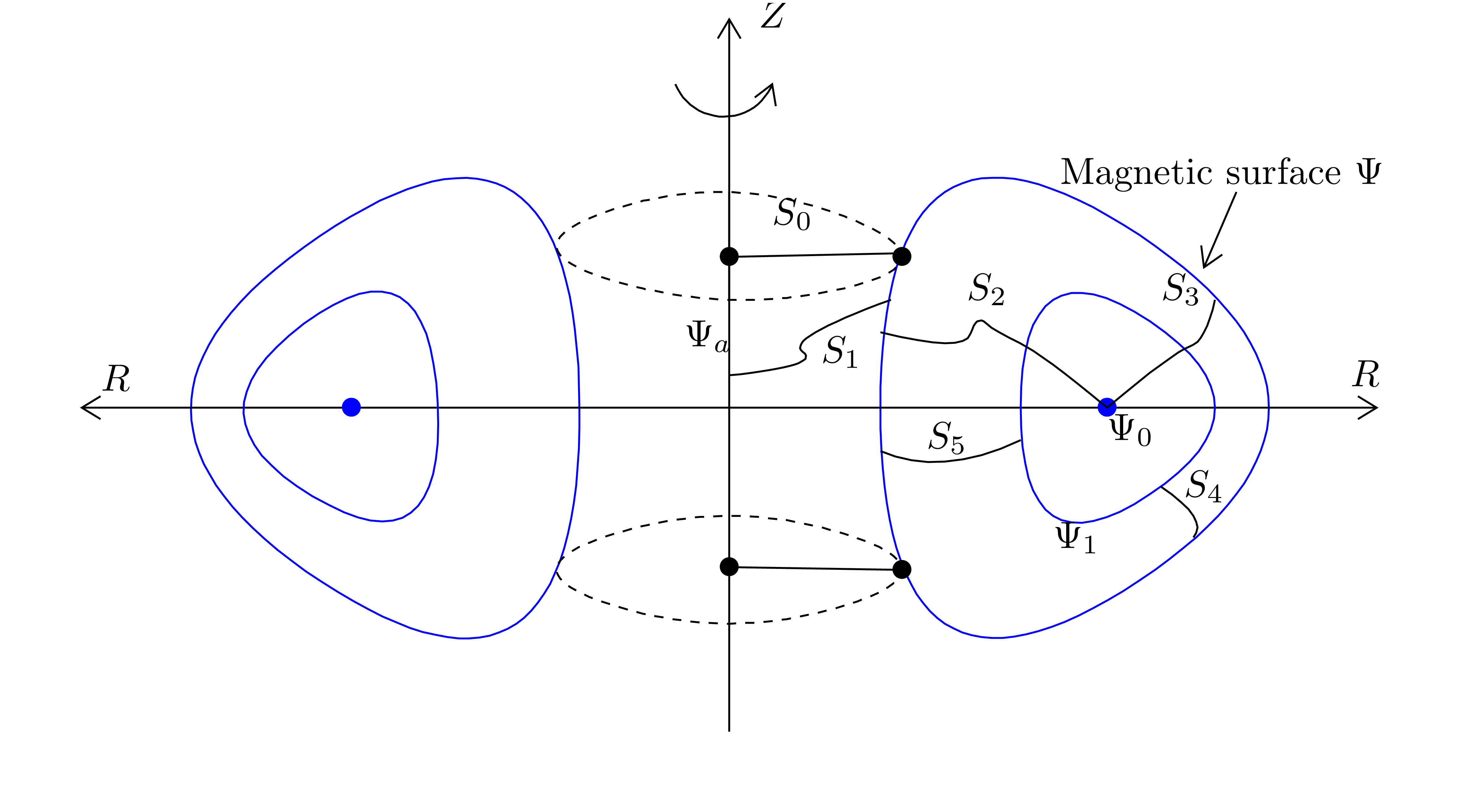 |
Figure 1.2. Closed magnetic
surfaces (blue) and various toroidal ribbons used to define the
poloidal magnetic flux discussed in Sec. 1.7. The
magnetic flux through the toroidal ribbons |
The innermost magnetic surface reduces to a curve, which is called
magnetic axis (in Fig. 1.2,  labels
the magnetic axis).
labels
the magnetic axis).  is zero at the magnetic axis
since
is zero at the magnetic axis
since  reach maximum/minimum there. As a result,
the poloidal magnetic field is zero there (refer to Eq. (1.8)).
For closed flux surfaces, since
reach maximum/minimum there. As a result,
the poloidal magnetic field is zero there (refer to Eq. (1.8)).
For closed flux surfaces, since  ,
the condition
,
the condition  means
means  points in the anticlockwise direction (viewed along
points in the anticlockwise direction (viewed along  direction), and
direction), and  means
means  points in the clockwise direction.
points in the clockwise direction.
 with the poloidal magnetic flux
with the poloidal magnetic flux
Note that  is defined by
is defined by  , which is just a component of the vector potential
, which is just a component of the vector potential
 , thereby having no obvious
physical meaning. Next, we show that
, thereby having no obvious
physical meaning. Next, we show that  has a
simple relation with the poloidal magnetic flux that can be be measured
in experiments.
has a
simple relation with the poloidal magnetic flux that can be be measured
in experiments.
 |
In Fig. 1.3, there are two magnetic surfaces labeled,
respectively, by  and
and  . The poloidal magnetic flux through any toroidal
ribbons between the two magnetic surfaces is equal to each other (due to
the magnetic Gauss theorem). Denote this poloidal magnetic flux by
. The poloidal magnetic flux through any toroidal
ribbons between the two magnetic surfaces is equal to each other (due to
the magnetic Gauss theorem). Denote this poloidal magnetic flux by  . Next, we calculate this flux. To
make the calculation easy, we select a plane perpendicular to the
. Next, we calculate this flux. To
make the calculation easy, we select a plane perpendicular to the  axis, as is shown by the dash line in Fig. (1.3).
In this case, only
axis, as is shown by the dash line in Fig. (1.3).
In this case, only  contribute to the poloidal
magnetic flux: (the positive direction of the plane is chosen to be
contribute to the poloidal
magnetic flux: (the positive direction of the plane is chosen to be
 )
)
Equation (1.21) indicates that the difference of  between two magnetic surfaces is equal to the poloidal
flux divided by
between two magnetic surfaces is equal to the poloidal
flux divided by  .
.
In experiments, we measure the poloidal magnetic flux through toroidal
loops around the central symmetric axis (discussed in Sec. 1.8).
Consider one of the loops that located at point  , then, using (1.21), the flux through
the loop can be written as
, then, using (1.21), the flux through
the loop can be written as
 |
(1.22) |
The central symmetric axis  is a field line. If
is a field line. If
 is finite at
is finite at  ,
then
,
then  is zero there. This is the case we
encounter in the equilibrium reconstruction problem. Then this flux is
written as
is zero there. This is the case we
encounter in the equilibrium reconstruction problem. Then this flux is
written as
 |
(1.23) |
Due to this relation,  is often called the
poloidal magnetic flux per radian (SI unit: web/rad), or simply
“the poloidal flux”. This relation allows the poloidal flux
measurements to be used to constrain the GS equation in the equilibrium
reconstrunction (discussed in Sec. 5). Note that the
positive normal direction of the surface (where the magnetic flux
is often called the
poloidal magnetic flux per radian (SI unit: web/rad), or simply
“the poloidal flux”. This relation allows the poloidal flux
measurements to be used to constrain the GS equation in the equilibrium
reconstrunction (discussed in Sec. 5). Note that the
positive normal direction of the surface (where the magnetic flux  is defined) is chosen in the
is defined) is chosen in the  direction. This sign choice along with the
direction. This sign choice along with the  factor appearing in Eq. (1.23) are often confusing people
when they try to relate the experimentally measured flux with the
factor appearing in Eq. (1.23) are often confusing people
when they try to relate the experimentally measured flux with the  appearing in the GS equation. The
appearing in the GS equation. The  factor also appears when we relate the Green function of
factor also appears when we relate the Green function of  to the mutual inductance, i.e.,
to the mutual inductance, i.e.,  (discussed later).
(discussed later).
A further compliction is that when one talks about “the poloidal
magnetic flux of a magnetic surface”, there are two possibilities
of the defintion. One of them is defined relative to the  (as is discussed above), and another is relative to the
magnetic axis. The first definition is the flux through the central hole
of the magnetic surface, i.e., the poloidal flux through
(as is discussed above), and another is relative to the
magnetic axis. The first definition is the flux through the central hole
of the magnetic surface, i.e., the poloidal flux through  in Fig. 1.2. In this case, as is discussed
above, the poloidal magnetic flux is related to
in Fig. 1.2. In this case, as is discussed
above, the poloidal magnetic flux is related to  by
by
 |
(1.24) |
where the postive direction is  .
The is the more often used defintion, and we will stick to this in the
equilibrium reconstruction problem.
.
The is the more often used defintion, and we will stick to this in the
equilibrium reconstruction problem.
The second definition is the flux enclosed by the closed flux surface,
i.e., the flux through the toroidal ribbon  .
Denote this flux by
.
Denote this flux by  , then
, then
 |
(1.25) |
where  is the value of
is the value of  at
the magnetic axis, the
at
the magnetic axis, the  orientation is in the
clockwise direction when an observer looks along the direction of
orientation is in the
clockwise direction when an observer looks along the direction of  .
.
By measuring the voltage around a toroidal wire loop, we can obtain the time derivative of the poloidal flux and, after integrating over time, the flux itself.
Suppose that there is a toroidal wire loop located at  and denote the magnetic flux through the loop by
and denote the magnetic flux through the loop by  (only the poloidal magnetic field contribute to this flux, hence this
flux is called the poloidal flux). Then Faraday's law
(only the poloidal magnetic field contribute to this flux, hence this
flux is called the poloidal flux). Then Faraday's law
 |
(1.26) |
where the direction of the loop integration and the direction of  is related by the right-hand rule, is written as
is related by the right-hand rule, is written as
 |
(1.27) |
where  is often called electromotive force (emf).
If the loop is a coil with
is often called electromotive force (emf).
If the loop is a coil with  turns, the induced
voltage
turns, the induced
voltage  in the coil is
in the coil is  times the emf, i.e.,
times the emf, i.e.,  . Then
Eq. (1.27) is written as
. Then
Eq. (1.27) is written as
 |
(1.28) |
Integrating the above equation over time, we obtain
 |
(1.29) |
The starting time  can be chosen as when
can be chosen as when  is easy to know (e.g., when there is no plasma).
Equation (1.29) tells us how to calcualte
is easy to know (e.g., when there is no plasma).
Equation (1.29) tells us how to calcualte  from the measured loop voltage
from the measured loop voltage  .
Then
.
Then  is obtained by
is obtained by  .
.
There are usually many flux loops (e.g. 35 on EAST[32]) at different locations in the poloidal plane (see Fig. 1.4). They are outside of the plasma region and thus are “external magnetic measurements”. The measured poloidal flux, along with the poloidal field measurement by magnetic probes, can be used as constraints in reconstructing the magnetic field within the plasma region. This is discussed in Sec. 5.
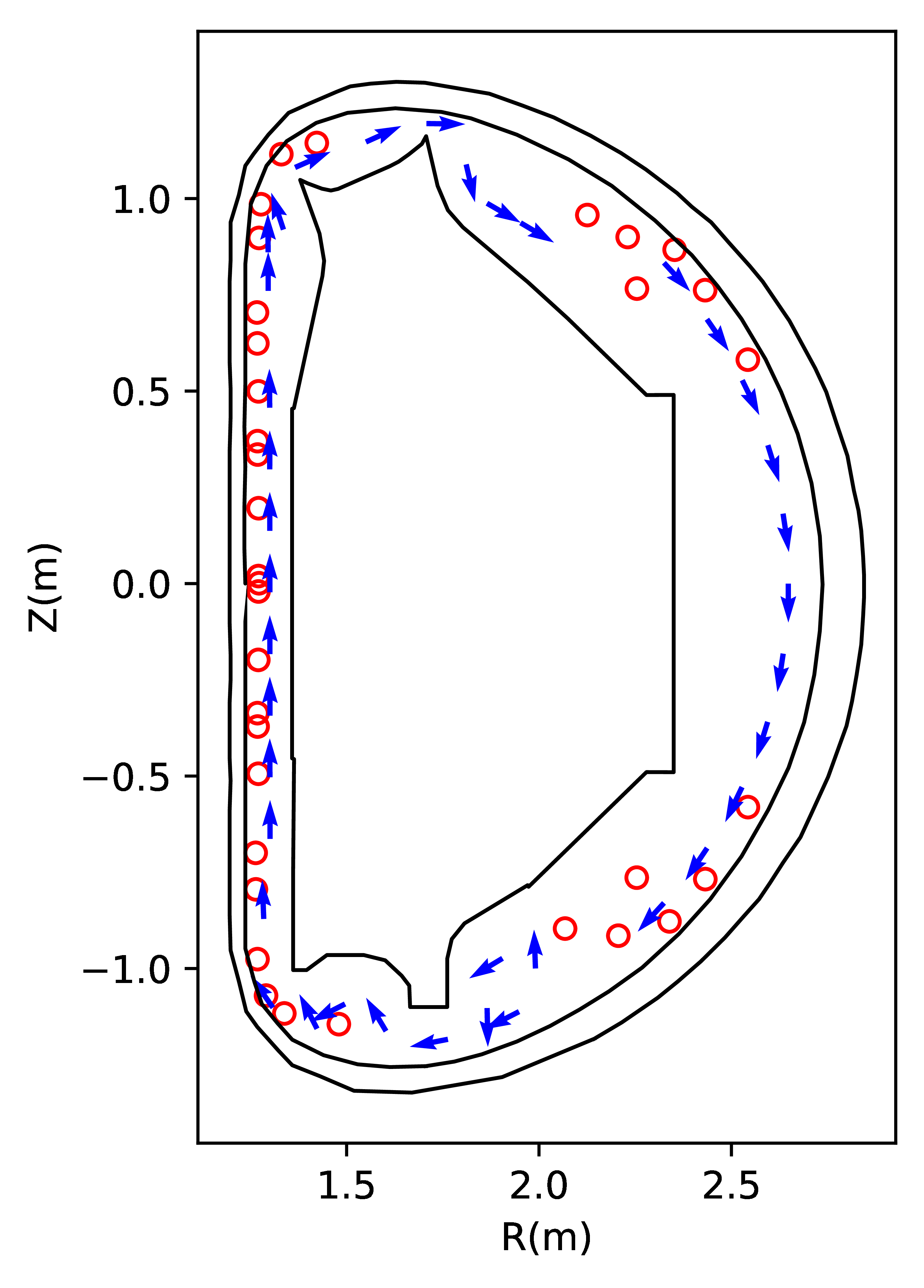 |
A magnetic field line on a closed magnetic surface travel a closed curve
in the poloidal plane. For these field lines, we can define the safety
factor  : the number of
toroidal loops a magnetic field line travels when it makes one poloidal
loop, i.e.
: the number of
toroidal loops a magnetic field line travels when it makes one poloidal
loop, i.e.
 |
(1.30) |
where  as the change of the toroidal angle when a
magnetic field line travels a full poloidal loop.
as the change of the toroidal angle when a
magnetic field line travels a full poloidal loop.
For open field line region (where a field line touches the wall before its poloidal projection can close itself), the “connection length” is often used to characterize the magnetic field.
The equation of magnetic field lines is given by
 |
(1.31) |
where  is the line element along the direction of
is the line element along the direction of
 on the poloidal plane. Equation (1.31)
can be arranged in the form
on the poloidal plane. Equation (1.31)
can be arranged in the form
 |
(1.32) |
which can be integrated over  to give
to give
 |
(1.33) |
where the line integration is along the poloidal magnetic field (the
contour of  on the poloidal plane). Using this,
Eq. (1.30) is written
on the poloidal plane). Using this,
Eq. (1.30) is written
 |
(1.34) |
The safety factor given by Eq. (1.34) is expressed in terms
of the components of the magnetic field. The safety factor can also be
expressed in terms of the magnetic flux. Define  as the poloidal magnetic flux enclosed by two neighboring magnetic
surface, then
as the poloidal magnetic flux enclosed by two neighboring magnetic
surface, then  is given by
is given by
 |
(1.35) |
where  is the length of a line segment in the
poloidal plane between the two magnetic surfaces, which is perpendicular
to the first magnetic surface (so perpendicular to the
is the length of a line segment in the
poloidal plane between the two magnetic surfaces, which is perpendicular
to the first magnetic surface (so perpendicular to the  ). Note that
). Note that  ,
as well as
,
as well as  and
and  ,
generally depends on the poloidal location whereas
,
generally depends on the poloidal location whereas  is independent of the poloidal location.
is independent of the poloidal location.
Using Eq. (1.35), the poloidal magnetic field is written as
 |
(1.36) |
Substituting Eq. (1.36) into Eq. (1.34), we obtain
 |
(1.37) |
We know  is a constant independent of the
poloidal location, so
is a constant independent of the
poloidal location, so  can be taken outside the
integration to give
can be taken outside the
integration to give
 |
(1.38) |
It is ready to realise that the integral appearing in Eq. (1.38)
is the toroidal magnetic flux enclosed by the two magnetic surfaces,
 . Using this, Eq. (1.38)
is written as
. Using this, Eq. (1.38)
is written as
 |
(1.39) |
Equation (1.39) indicates that the safety factor of a magnetic surface is equal to the differential of the toroidal magnetic flux with respect to the poloidal magnetic flux enclosed by the magnetic surface.
If the safety factor of a magnetic surface is a rational number, i.e.,
 , where
, where  and
and  are integers, then this magnetic surface is
called a rational surface, otherwise an irrational surface. A field line
on a rational surface with
are integers, then this magnetic surface is
called a rational surface, otherwise an irrational surface. A field line
on a rational surface with  closes itself after
it travels
closes itself after
it travels  poloidal loops. An example of a field
line on a rational surface is shown in Fig. 1.5.
poloidal loops. An example of a field
line on a rational surface is shown in Fig. 1.5.
In the above, the magnetic field is assumed to be axisymmetric. With
this assumption, the poloidal magnetic field (having two components) can
be expressed in terms of a single component of the vector potential
 ,
,  (specifically via
(specifically via  ). This
kind of simplification is not achievable if the axisymmetricity
assumption is dropped, because other components of the vector potential
(namely
). This
kind of simplification is not achievable if the axisymmetricity
assumption is dropped, because other components of the vector potential
(namely  and
and  )
will appear in the expression of the poloidal magnetic field. Let us
re-examine Eq. (1.2) for a general magnetic perturbation:
)
will appear in the expression of the poloidal magnetic field. Let us
re-examine Eq. (1.2) for a general magnetic perturbation:
When studying tearing modes and electromagnetic turbulence, most authors
narrow the possible perturbations by setting  , i.e.,
, i.e.,
 |
(2.2) |
 |
(2.3) |
 |
(2.4) |
where  . Therefore this kind
of magnetic perturbation can still be written in the same form as the
equilibrium poloidal magnetic field:
. Therefore this kind
of magnetic perturbation can still be written in the same form as the
equilibrium poloidal magnetic field:
 |
(2.5) |
The above approximation is widely used in practice, e.g., in turbulence
simulation, where  is replaced by
is replaced by  . (Do we miss some magnetic perturbations that
is important for plasma transport when using the above specific form?)
. (Do we miss some magnetic perturbations that
is important for plasma transport when using the above specific form?)
The total magnetic field is then written as
 |
(2.6) |
**check**Can the projection of the total magnetic field line in the
poloidal plane can be traced by tracing the contour of  ? No. The contours of
? No. The contours of  will not show island structures in the poloidal plane. To show the
expected island structures, we need to subtract non-reconnecting
poloidal magnetic field from the total poloidal field? **check** The
contours of the so-called helical flux will give the expected island
structures near the resonant surfaces?**check**
will not show island structures in the poloidal plane. To show the
expected island structures, we need to subtract non-reconnecting
poloidal magnetic field from the total poloidal field? **check** The
contours of the so-called helical flux will give the expected island
structures near the resonant surfaces?**check**
Next, we go back to discuss the 2D case (i.e., assuming axisymmetry).
 and
and 
When the displacement current term is neglectable (the case we consider here), the conductive current is just another representation of the magnetic field. Specifically, the current density is proportional to the curl of the magnetic field (Ampère's law):
where  is vacuum magnetic permeability.
is vacuum magnetic permeability.
Use Eq. (3.1) and the definition  , the poloidal components of the current density,
, the poloidal components of the current density,
 and
and  ,
can be written as
,
can be written as
 |
(3.2) |
and
 |
(3.3) |
respectively.
Ampere's law (3.1) indicates the toroidal current density
 is given by
is given by
Define  by
by
 |
(3.5) |
then Eq. (3.4) is written as
 |
(3.6) |
(Many authors incorrectly refer to Eq. (3.6) as the
Grad-Shafranov (GS) equation. Eq. (3.6) is just Ampere's
law, which has nothing to do with the force-balance. Only after we
express  in terms of the plasma pressure, can Eq.
(3.6) be called the GS equation, as is discussed Sec. 4.3.)
in terms of the plasma pressure, can Eq.
(3.6) be called the GS equation, as is discussed Sec. 4.3.)
The operator  is different from the Laplacian
operator
is different from the Laplacian
operator  . In terms of the
nabla operator
. In terms of the
nabla operator  , the operator
, the operator
 is writen as
is writen as
 |
(3.7) |
Let us consider what constraint the force balance imposes on the axisymmetric magnetic field discussed above. The MHD momentum equation is given by
 |
(4.1) |
where  ,
,  ,
,  ,
,
 ,
,  , and
, and  are mass density,
charge density, thermal pressure tensor, current density, electric
field, and magnetic field, respectively. The electric field force
are mass density,
charge density, thermal pressure tensor, current density, electric
field, and magnetic field, respectively. The electric field force  is usually ignored due to either
is usually ignored due to either  or
or  . Further assume that
there is no plasma flow (
. Further assume that
there is no plasma flow ( ,
the flow effect is discussed in A.13) and the plasma
pressure is isotropic, then the steady state momentum equation (force
balance equation) is written as
,
the flow effect is discussed in A.13) and the plasma
pressure is isotropic, then the steady state momentum equation (force
balance equation) is written as
 |
(4.2) |
where  is the scalar plasma pressure.
is the scalar plasma pressure.
Is the force balance (4.2) always satisfied in a real
toakamak discharge? To answer this question, we need to go back to the
original momentum equation (4.1). The imbalance between
 and
and  will give rise to
the compressional Alfven waves, the time-scale of which,
will give rise to
the compressional Alfven waves, the time-scale of which,  , is much shorter than the time-scale
, is much shorter than the time-scale  we are interested in. Therefore, on the time scale
we are interested in. Therefore, on the time scale  (and for slow flow with
(and for slow flow with  ,
where
,
where  is the the sound speed), the leading order
of the momentum equation is the force balance (4.2).[26]. I.e. the inertial effect can be neglected (plasma mass is
approximately zero).
is the the sound speed), the leading order
of the momentum equation is the force balance (4.2).[26]. I.e. the inertial effect can be neglected (plasma mass is
approximately zero).
Consider the force balance in the direction of  . Dotting the equilibrium equation (4.2)
by
. Dotting the equilibrium equation (4.2)
by  , we obtain
, we obtain
 |
(4.3) |
which implies that  is constant along a magnetic
field line. Since
is constant along a magnetic
field line. Since  is also constant along a
magnetic field line,
is also constant along a
magnetic field line,  can be expressed in terms
of only
can be expressed in terms
of only  on a single magnetic line. Note that
this does not necessarily mean
on a single magnetic line. Note that
this does not necessarily mean  is a
single-valued function of
is a
single-valued function of  ,
(i.e.
,
(i.e.  ). This is because
). This is because  still has the freedom of taking different values on
different magnetic field lines with the same value of
still has the freedom of taking different values on
different magnetic field lines with the same value of  while still satisfying
while still satisfying  . This
situation can appear when there are saddle points (X points) in
. This
situation can appear when there are saddle points (X points) in  contours (refer to Sec. A.22) and
contours (refer to Sec. A.22) and  takes different functions of
takes different functions of  in islands of
in islands of  sepearated by a X point. For
pressure within a single island of
sepearated by a X point. For
pressure within a single island of  ,
,
 can be safely assumed.
can be safely assumed.
On the other hand, if  , then
we obtain
, then
we obtain

i.e., Eq. (4.3) is satisfied, indicating  is a sufficient condition for the force balance in the parallel (to the
magnetic field) direction.
is a sufficient condition for the force balance in the parallel (to the
magnetic field) direction.
Consider the force balance in the toroidal direction. The  component of Eq. (4.2) is written
component of Eq. (4.2) is written
 |
(4.4) |
Since  , which implies
, which implies  , equation (4.4)
reduces to
, equation (4.4)
reduces to
 |
(4.5) |
Using the expressions of the poloidal current density (3.2) and (3.3) in the force balance equation (4.5) yields
 |
(4.6) |
which can be further written
 |
(4.7) |
According to the same reasoning for the pressure, we conclude that  is a sufficient condition for the toroidal force
balance. (The function
is a sufficient condition for the toroidal force
balance. (The function  defined here is usually
called the “poloidal current function” in tokamak
literature. The reason for this name is discussed in Sec. A.11.)
defined here is usually
called the “poloidal current function” in tokamak
literature. The reason for this name is discussed in Sec. A.11.)
Consider the force balance in  direction. The
direction. The
 component of Eq. (4.2) is written
component of Eq. (4.2) is written
 |
(4.8) |
Using the expressions of the current density and magnetic field [Eqs. (1.6) and (3.3)], equation (4.8) is written
 |
(4.9) |
Assuming the sufficient condition discussed above, i.e.,  and
and  are a function of only
are a function of only  , i.e.,
, i.e.,  and
and
 , Eq. (4.9) is
written
, Eq. (4.9) is
written
 |
(4.10) |
which can be simplified to
 |
(4.11) |
which is the requirement of force-balance along the major radius. On the
other hand, we know  can be expressed in
can be expressed in  via Eq. (3.6). Combining this with Eq.
(4.11) yields
via Eq. (3.6). Combining this with Eq.
(4.11) yields
 |
(4.12) |
i.e.,
 |
(4.13) |
Equation (4.13) is known as Grad-Shafranov (GS) equation.
[Note that the  component of the force balance
equation is written
component of the force balance
equation is written

which turns out to be identical with the Grad-Shafranov equation. This
is not a coincidence. The reason is that the force balance equation has
been satisfied in three different directions (namely,  ,
,  ,
and
,
and  direction) and thus it must be satisfied in
all the directions.]
direction) and thus it must be satisfied in
all the directions.]
A general axisymmetric magnetic field (which does not necessarily satisfy the force balance), is given by Eq. (1.10), i.e.,
 |
(4.14) |
For the above axisymmetric magnetic field to be consistent with the
force balance equation (4.2), there are additional
requirements for  and
and  . Specifically,
. Specifically,  is
restricted by the GS equation and
is
restricted by the GS equation and  should be a
function of only
should be a
function of only  . Therefore
an axisymmetric equilibrium magnetic field is fully determined by two
functions,
. Therefore
an axisymmetric equilibrium magnetic field is fully determined by two
functions,  and
and  .
The
.
The  is determined by solving the GS equation
with specified RHS source terms and boundary conditions.
is determined by solving the GS equation
with specified RHS source terms and boundary conditions.
The RHS source terms in the GS equation (4.13) are  and
and  , both
of which must be specified before the GS equation can be solved. For
most cases, the source terms are nonlinear about
, both
of which must be specified before the GS equation can be solved. For
most cases, the source terms are nonlinear about  and thus the GS equation is a two-dimensional (in
and thus the GS equation is a two-dimensional (in  and
and  ) nonlinear partial
differential equation for
) nonlinear partial
differential equation for  .
.
For most choices of  and
and  , the GS equation (4.13) has to be
solved numerically. For some particular choices of
, the GS equation (4.13) has to be
solved numerically. For some particular choices of  and
and  profiles, analytical solutions are
available, one of which is the Solovév equilibrium and is
discussed in Appendix A.12.
profiles, analytical solutions are
available, one of which is the Solovév equilibrium and is
discussed in Appendix A.12.
Note that we solve the GS equation in order to obtain the poloidal
magnetic flux  and thus the poloidal magnetic
field. The toroidal magnetic field must be specified in some way before
we can solve the GS equation. There are several ways of specifying the
toroidal magnetic field: (1) given
and thus the poloidal magnetic
field. The toroidal magnetic field must be specified in some way before
we can solve the GS equation. There are several ways of specifying the
toroidal magnetic field: (1) given  ,
(2) given
,
(2) given  , (3) given the
safety factor
, (3) given the
safety factor  . There are
simple relations between
. There are
simple relations between  ,
,
 , and
, and  , which allows translation form one to another
(discussed later). In transport simulations,
, which allows translation form one to another
(discussed later). In transport simulations,  is
obtained from current drive models and neoclassical bootstrap current
models. Note that the specification of the source terms (
is
obtained from current drive models and neoclassical bootstrap current
models. Note that the specification of the source terms ( ,
,  ,
,
 , and
, and  ) usually involve the unknown
) usually involve the unknown  (via not only the explicit presence of
(via not only the explicit presence of  ,
but also the flux-surface averaging which implicitly involves
,
but also the flux-surface averaging which implicitly involves  ). This indicates that iterations
are needed when numerically solving the GS equation.
). This indicates that iterations
are needed when numerically solving the GS equation.
A routine in tokamak operation is to reconstruct magnetic field under the constraints of MHD force balance and expermental measurements. This kind of task can be done by various codes, e.g., EFIT. I developed a similar code, heq (github.com/youjunhu/heq). I will discuss details on this code.
Ampere's law in Eq. (3.6) can be generalized to include discrete toroidal currents:
 |
where  is the plasma toroidal current density,
is the plasma toroidal current density,
 is a toroidal curent filament located at
is a toroidal curent filament located at  ,
,  is
Dirac's delta function. The solution to the above equation is given by
is
Dirac's delta function. The solution to the above equation is given by
 |
(5.2) |
where  is the fundamental solution given by
is the fundamental solution given by
which is often called Green's function in this context (which is obtained by using a formula similar to the Biot-Savart Law, see B.14).
If all the toroidal currents (plasma current + coil/vessel curents) are
known, then  can be calculated by using Eq. (5.2). Unfortunately,
can be calculated by using Eq. (5.2). Unfortunately,  is usually
unknown. Meanwhile the force-balance indicates that
is usually
unknown. Meanwhile the force-balance indicates that  can be expressed in terms of
can be expressed in terms of  via Eq. (4.11),
i.e.,
via Eq. (4.11),
i.e.,
 |
(5.4) |
Substituting this into Eq. (5.2) gives an implicit formula
for  , which can be iterated
(with an initial guess of
, which can be iterated
(with an initial guess of  ,
and assuming the function forms,
,
and assuming the function forms,  and
and  , as well as the coil currents
, as well as the coil currents
 , are known ). We can see
that this is a Picard iteration. Will the iteration converge? We do not
know for sure. Numerical experiments indicate it does in some cases. Let
us discuss some specific cases. We assume that the 1D functions,
, are known ). We can see
that this is a Picard iteration. Will the iteration converge? We do not
know for sure. Numerical experiments indicate it does in some cases. Let
us discuss some specific cases. We assume that the 1D functions,  and
and  , can
be modeled as (EFIT's model[17]):
, can
be modeled as (EFIT's model[17]):
 |
(5.5) |
 |
(5.6) |
where
 |
(5.7) |
 and
and  are values of
are values of  at the magnetic axis and LCFS, the coefficients
at the magnetic axis and LCFS, the coefficients  and
and  are to be determined,
are to be determined,
 and
and  are integers chosen
by users. Expressions (5.5) and (5.6)
guarantee that
are integers chosen
by users. Expressions (5.5) and (5.6)
guarantee that  and
and  are
zero at and outside the LCFS, and thus no plasma current there. Note
that expressions (5.5) and (5.6) are nonlinear
functions of
are
zero at and outside the LCFS, and thus no plasma current there. Note
that expressions (5.5) and (5.6) are nonlinear
functions of  even for
even for  . This is because the unknowns,
. This is because the unknowns,  and
and  , appear in the
denominator of expression (5.7). Another nonlinearity is
related to the fact that the unkonw
, appear in the
denominator of expression (5.7). Another nonlinearity is
related to the fact that the unkonw  determines
where the LCFS is and thus determines the region where the current
desnsity is set to zero. This also gives rise to the name
“free-boundary” for this kind of problems.
determines
where the LCFS is and thus determines the region where the current
desnsity is set to zero. This also gives rise to the name
“free-boundary” for this kind of problems.
Choosing an initial guess of  on gridpoints, we
can get the values of
on gridpoints, we
can get the values of  ,
,  , and
, and  by
solving a least square problem that minimises the difference between
quantities computed and the corresponding quantities measured in actual
experiments. (Details are given in Sec. 5.1.)
by
solving a least square problem that minimises the difference between
quantities computed and the corresponding quantities measured in actual
experiments. (Details are given in Sec. 5.1.)
After the coefficients  and
and  are obtained,
are obtained,  can be updated by using Eqs. (5.4)-(5.6). Then, we use the latest
can be updated by using Eqs. (5.4)-(5.6). Then, we use the latest  and
and  in Eq. (5.2) to
re-compute the values of
in Eq. (5.2) to
re-compute the values of  on gridpoints by using
Eq. (5.2). The procedure is repeted until convergecne in
on gridpoints by using
Eq. (5.2). The procedure is repeted until convergecne in
 . This is called Picard
iteration. (Alternatively, the values of
. This is called Picard
iteration. (Alternatively, the values of  on the
inner gridpoints can be updated by inverting the Laplace operator
on the
inner gridpoints can be updated by inverting the Laplace operator  , see Sec. 5.4. The
values of
, see Sec. 5.4. The
values of  on the bounary still have to be
obtained by using Eq. (5.2).)
on the bounary still have to be
obtained by using Eq. (5.2).)
I implemented the above method in a Python code (HEQ https://github.com/youjunhu/heq). The following subsections discuss details of the code: Sec. 5.1 discusses the least square problem. Sec. 5.3 discusses the vertical displacement instability stabilizer. Without the stabilizer, the Picard iteration diverges for many elongated configurations, due to the vertical displacement instability.
For  , plugging expressions
(5.5) and (5.6) into (5.4), we
obtain
, plugging expressions
(5.5) and (5.6) into (5.4), we
obtain
For notation ease, define the following basis functions:
 |
(5.9) |
and the corresponding expansion coefficients
 |
(5.10) |
then Eq. (5.8) is written as
 |
(5.11) |
where  . Plugging expression
(5.11) into Eq. (5.2), we obtain
. Plugging expression
(5.11) into Eq. (5.2), we obtain
Collect all the free parameters as a column vector:  . Denote the size of vector
. Denote the size of vector  by
by  , which is the number of
free parameters, i.e.,
, which is the number of
free parameters, i.e.,  , then
the rhs of Eq. (5.12) can be written as matrix-vector
product,
, then
the rhs of Eq. (5.12) can be written as matrix-vector
product,  . Denote the total
number of measurements of the poloidal flux by
. Denote the total
number of measurements of the poloidal flux by  . Then matrix elements of
. Then matrix elements of  for
for  are given by:
are given by:
 |
(5.13) |
for  , and
, and
 |
(5.14) |
for  . Here
. Here  is the location where the
is the location where the  flux measurement is
made.
flux measurement is
made.
The matrix  , which is of shape
, which is of shape  , is called “response matrix”. (In
least square problems, this matrix is called “design matrix'.) The
value of
, is called “response matrix”. (In
least square problems, this matrix is called “design matrix'.) The
value of  is equal to number of
measurements/constraints included (measurements/constraints are merged
to
is equal to number of
measurements/constraints included (measurements/constraints are merged
to  by row stacking). We will include
by row stacking). We will include  measurements of the poloidal flux,
measurements of the poloidal flux,  measurements of the poloidal magnetic field, 1 measurement of plasma
current, a constraint for the on-axis safety factor. Then
measurements of the poloidal magnetic field, 1 measurement of plasma
current, a constraint for the on-axis safety factor. Then  . (For EAST,
. (For EAST,  .)
.)
Next, we consider the poloidal field measurement:
 |
(5.15) |
where  is the location of the No. i probe,
is the location of the No. i probe,  is a unit vector denoting the positive normal
direction of the No.
is a unit vector denoting the positive normal
direction of the No.  magnetic probe,
magnetic probe,  ,
,  .
.
 can be inferred from
can be inferred from  via
via
where
 |
(5.17) |
and  and
and  is given by Eq.
(B.18) and (B.19). The rhs of Eq. (5.16)
indicates that the matrix elements of
is given by Eq.
(B.18) and (B.19). The rhs of Eq. (5.16)
indicates that the matrix elements of  are given
by:
are given
by:
 |
(5.18) |
for ( ), and
), and
 |
(5.19) |
for ( ). I place the
magnetic field equations after the flux equations, i.,e the row number
). I place the
magnetic field equations after the flux equations, i.,e the row number
 is in the range
is in the range  .
.
Next, we consider the constraint of plasma current. The plasma current
 can be inferred from
can be inferred from  via
via
 |
(5.20) |
The rhs of Eq. (5.20) indicates that the matrix elements of
 are given by:
are given by:
 |
(5.21) |
for ( ), and zero for (
), and zero for ( ). This equation is placed after
the equations of flux and magnetic field measurement, i.e., its row
number is
). This equation is placed after
the equations of flux and magnetic field measurement, i.e., its row
number is  .
.
Let us consider the constraint of the on-axis safety factor  . A formula for computing
. A formula for computing  is given by:
is given by:
 |
(5.22) |
where
 |
(5.23) |
is the ellipticity (elongation) at the magnetic axis. Organizing Eq. (5.22) as
 |
(5.24) |
and using
 |
(5.25) |
equation (5.24) is written as
 |
(5.26) |
This provides one linear equation for  ,
with the matrix elements given by
,
with the matrix elements given by
 |
(5.27) |
for ( ), and zero for (
), and zero for ( ).
).
In HEQ, the ellipticity  is calculated
by computing the elongation of the innermost magnetic surface found by
the contour program.
is calculated
by computing the elongation of the innermost magnetic surface found by
the contour program.
Step 0. Initial guess of  :
:
 with
with  .
.
Step 1. Search for the magnetic axis and LCFS of  so that we get the values of
so that we get the values of  at those locations.
These values are needed in computing
at those locations.
These values are needed in computing  .
The location of the LCFS are also needed because we need to set the
plasma current to zero outside the LCFS.
.
The location of the LCFS are also needed because we need to set the
plasma current to zero outside the LCFS.
Step 2. Compute elements of response matrix  using
using  .
.
Step 3. Solve linear least-square problem to get  .
.
Step 4. Update  using the latest plasma and coil
currents:
using the latest plasma and coil
currents:

or in its discrete form:

Step 5:  and goto Step 1.
and goto Step 1.
To stabilize the vertical displacement instability in the Picard
iteration, we add two virtual coils that carry oppositive currents
(denoted by  and
and  ),
and are up-down symmetric, located at
),
and are up-down symmetric, located at  and
and  , respectively. And set the current
, respectively. And set the current
 by
by

where  is the location of plasma current center
defined by
is the location of plasma current center
defined by


 is the
is the  generated by all
the real PF coils,
generated by all
the real PF coils,  is a positive constant chosen
by users. Note that
is a positive constant chosen
by users. Note that  corresponds to that the
corresponds to that the  generated by the virtual coils exactly cancles the
generated by the virtual coils exactly cancles the
 generted by all the real coils. Usually we need
value larger than 2, i.e., over compensation. The virtual coils
locatons,
generted by all the real coils. Usually we need
value larger than 2, i.e., over compensation. The virtual coils
locatons,  and
and  ,
are usually chosen near the center of the top/bottom boundary of the
computational box.
,
are usually chosen near the center of the top/bottom boundary of the
computational box.
If we want to invert the finite-difference version of the Laplace
operator  to solve the GS equation for
to solve the GS equation for  , we encounter two issues: (1) the
RHS of the GS equation involves 2 unknown functions
, we encounter two issues: (1) the
RHS of the GS equation involves 2 unknown functions  and
and  , in addition to the main
unknown function
, in addition to the main
unknown function  ; (2) the
boundary condition needs to be given: i.e., the values of
; (2) the
boundary condition needs to be given: i.e., the values of  on a rectangular computational boundry need to be
provided.
on a rectangular computational boundry need to be
provided.
To address issue (1): function forms of  and
and
 are chosen by users, often as polymials in
are chosen by users, often as polymials in  with coefficients that are assumed known (which are
later obtained in the least-square method to make the resulting solution
approximately match some measurements, as is discussed in the previous
section).
with coefficients that are assumed known (which are
later obtained in the least-square method to make the resulting solution
approximately match some measurements, as is discussed in the previous
section).
To address issue (2): The value of  on the
rectangular boundary is updated using the Green's function method
(assume that external coil currents are given), as is discussed in the
previous section.
on the
rectangular boundary is updated using the Green's function method
(assume that external coil currents are given), as is discussed in the
previous section.
Guess values of  on both the inner gridpoints and
boundary points. After this, we can invert
on both the inner gridpoints and
boundary points. After this, we can invert  to
update
to
update  within the computational box, and use the
Green's function method to update values of
within the computational box, and use the
Green's function method to update values of  on
the boundary. Then iterate to converge.
on
the boundary. Then iterate to converge.
Two iterations: one for  values on the inner
gridpoints, one over
values on the inner
gridpoints, one over  values on the computational
boundary.
values on the computational
boundary.
External PF coil currents enter the problem via the boundary condition:
specifically via its contribution to  on the
boundary.
on the
boundary.
The above procedure is just a minor modification from the pure Green's function algorithm discussed in Sec. 5.2, i.e., replacing the Green's function method for the inner gridpoints with the finte-difference Laplace operator inverting.
For reference easy, the finite-difference schemes for the Laplace operator is listed below.
 |
(5.28) |
Method 1: discretize Eq. (5.29) as
 |
|||
 |
 |
which can be further discretized as
 |
|||
 |
 |
which can be organized as

where  ,
,  ,
,  ,
,
 . Method 2: discetize Eq. (5.30)
. Method 2: discetize Eq. (5.30)

which can be organized as

where 
 ,
,
 ,
, 
My numerical experiments indicate this scheme is more stable than than the first one (for the same grid size, and without the VDE stabilizer, the first scheme blow up while the latter scheme works well).
Semi-free boundary equilibrium problems refer to the problems where the
LCFS shape and the value of  on it are given, and
one is asked to solve the currents in the PF coils. This is similar to
the fitting problem discussed above: we consider the control points on
the LCFS as virtual flux loops that measure the poloidal flux. This mode
can be used to set the feedforward PF coil currents when a target plasma
state time evolution is given.
on it are given, and
one is asked to solve the currents in the PF coils. This is similar to
the fitting problem discussed above: we consider the control points on
the LCFS as virtual flux loops that measure the poloidal flux. This mode
can be used to set the feedforward PF coil currents when a target plasma
state time evolution is given.
Using magnetic measurements as input, a realtime equilibrium
reconstruction code (e.g., rtefit) can infer the inner
structure of  (observer). On the other hand, PF
coil currents can provide actions on
(observer). On the other hand, PF
coil currents can provide actions on  (actuactor). With the observer and actuator, we can feedback controll
the magnetic configuration (flux map).
(actuactor). With the observer and actuator, we can feedback controll
the magnetic configuration (flux map).
For example, consider controlling the shape of LCFS (often called
iso-flux control). We choose a target surface. To make sure that the
target surface is a magnetic surface, the value of  on it should be made a spatial constant. Dentoe this constant by
on it should be made a spatial constant. Dentoe this constant by  . To make sure that
there is no closed flux surface outside the target surface, we select
the target surface as a surface that is tangential to the first wall
(for limiter configuration) or there is a X-point on it (for divertor
configuration). Then discretize the target surface by a series of
discrete coordinates
. To make sure that
there is no closed flux surface outside the target surface, we select
the target surface as a surface that is tangential to the first wall
(for limiter configuration) or there is a X-point on it (for divertor
configuration). Then discretize the target surface by a series of
discrete coordinates  with
with  . The actions (coil current changes) are chosen to
minimise the following residual:
. The actions (coil current changes) are chosen to
minimise the following residual:
 |
(6.1) |
where
 |
(6.2) |
 |
(6.3) |
the superscritp (old) indicates values before the control actions,  is obtained by a real-time equilibrium reconstruction
code. This assumes that the plasma current density remains the same when
the actions are imposed (i.e., no plasma response is included), so that
only the coil current changes contribute to the
is obtained by a real-time equilibrium reconstruction
code. This assumes that the plasma current density remains the same when
the actions are imposed (i.e., no plasma response is included), so that
only the coil current changes contribute to the  change.
change.
If we need to feedback control  points to desired
positions, then the above sum can be extended to include the following:
points to desired
positions, then the above sum can be extended to include the following:
 |
|||
 |
 |
where  are desired poistions of X points.
are desired poistions of X points.
Faraday's law
 |
(7.1) |
can be written in the integral form:
 |
(7.2) |
(The direction of the loop integration is related to the surface orientation by the right-hand rule.) I.e.,
 |
(7.3) |
where  is the flux linked with the loop.
is the flux linked with the loop.
For the No.  coil, the time derivative of the
flux through it can be expressed as
coil, the time derivative of the
flux through it can be expressed as
 |
(7.4) |
where  is the mutual indctance between the No.
is the mutual indctance between the No.
 coil and No.
coil and No.  coil,
coil,  is the mutual inductance between the No.
is the mutual inductance between the No.  coil and a plasma filament located at
coil and a plasma filament located at  , and
, and  is the current
carried by the filament. The integration is over a fixed region (time
independent) that is large enough to include all the plasma and small
enough to not include any coil.
is the current
carried by the filament. The integration is over a fixed region (time
independent) that is large enough to include all the plasma and small
enough to not include any coil.
Define the effective mutual inductance between the plasma and the No.
 coil by
coil by
 |
(7.5) |
where  is the plasma current, then expression (7.4) is written as
is the plasma current, then expression (7.4) is written as
 |
 |
 |
|
 |
 |
where the term proportional to the time derivative of  is ignored (is this a good approximation?). Including the above emf in
the circuit equation, we get
is ignored (is this a good approximation?). Including the above emf in
the circuit equation, we get
 |
(7.7) |
where  is the resistence of the coil,
is the resistence of the coil,  is the current in the present coil,
is the current in the present coil,  is the voltage imposed on the coil by the power supply. (Here the
positive direction of
is the voltage imposed on the coil by the power supply. (Here the
positive direction of  and
and  must be chosen consistent with the loop integration discussed above
i.e., anti-clockwise in top view.)
must be chosen consistent with the loop integration discussed above
i.e., anti-clockwise in top view.)
The VDE controlling coils are made of two coils (one upper and one
lower, with updown symmetry), which are anti-conneted in series and
powered by one voltage source. For the upper  coil, the circuit equation is
coil, the circuit equation is
 |
(7.8) |
Similarly, for the lower ( )
coil, the circuit equation is
)
coil, the circuit equation is
 |
(7.9) |
The anti-series connection implies that
 |
(7.10) |
and
 |
(7.11) |
where  is the source voltage (assuming the
voltage source positive terminal is connected to the upper coil that
goes anti-clockwise in top view). Combining these equations, we obtain
is the source voltage (assuming the
voltage source positive terminal is connected to the upper coil that
goes anti-clockwise in top view). Combining these equations, we obtain
 |
(7.12) |
This is used as an equation for the upper VDE coil current. Eq. (7.10) is used as an equation for the lower VDE coil current.
Because the mutual inductance between two objects is symmetric (i.e.,
 ), the mutual inductance
), the mutual inductance  given by expression (7.5) can also be
used to calculate the effective emf induced in the plasma by the coils:
given by expression (7.5) can also be
used to calculate the effective emf induced in the plasma by the coils:

(Here  can be understood as
can be understood as  weighted average of
weighted average of  . Why to
use
. Why to
use  weighted, rather than just equal-weighted
spatial average? This is to ensure energy conservation: the power is
weighted, rather than just equal-weighted
spatial average? This is to ensure energy conservation: the power is
 , so the current density
should serve as a weight.)
, so the current density
should serve as a weight.)
Similarly, the effective emf self-induced in the plasma is given by
 |
(7.13) |
where  is the mutual inductance between
is the mutual inductance between  filament and
filament and  filament; both the 2D
integrations are over a fixed region that includes the plasma but does
not include any coil; one of the two 2D integrations can be regarded as
filament; both the 2D
integrations are over a fixed region that includes the plasma but does
not include any coil; one of the two 2D integrations can be regarded as
 weighted average and the other is the
integration over the source. Expresion (7.13) motivates us
to define the effective self-inductance of plasma by
weighted average and the other is the
integration over the source. Expresion (7.13) motivates us
to define the effective self-inductance of plasma by
 |
(7.14) |
Then the effective emf in expression (7.13) is written as

where the term proportional to the time derivative of  is ignored. Then the circuit equation for the plasma current is written
as
is ignored. Then the circuit equation for the plasma current is written
as
 |
(7.15) |
where  is the effective plasma resistivity.
is the effective plasma resistivity.
Using the Euler implicit scheme, the coil current evolution equation
( ) is written as
) is written as

Moving all the unknown (coil currents  and plasma
current
and plasma
current  ) to the left-hand
side, we get
) to the left-hand
side, we get
 |
 |
||
 |
 |
For each coil, we get a linear equation like the above. For  coils, we get
coils, we get  equations. (Note
that
equations. (Note
that  depends on
depends on  ,
and thus is time dependent. If we use value of
,
and thus is time dependent. If we use value of  at
at  in the above equation, then we need to
iterate because
in the above equation, then we need to
iterate because  is unkown. If we use the value
at
is unkown. If we use the value
at  , then no iteration is
needed, whch is the case used in HEQ).
, then no iteration is
needed, whch is the case used in HEQ).
Similarly, the plasma current evolution equation (7.15) is discretized as
 |
(7.17) |
i.e.,
 |
(7.18) |
Define the plasma state by the position of the magnetic axis  , total plasma current
, total plasma current  , and the shape of the LCFS. Discretize the
LCFS in the cylindrical coordinates by
, and the shape of the LCFS. Discretize the
LCFS in the cylindrical coordinates by  points.
Then the plasma state can be represented by
points.
Then the plasma state can be represented by  real
numbers:
real
numbers:  ,
,  ,
,  ,
and
,
and  for
for  .
.
Inputs to the policy network: the magnetic measurements at the present
time step  (which serves as a proxy to the actual
plasma state), and target plasma states (provided by the designer) at
(which serves as a proxy to the actual
plasma state), and target plasma states (provided by the designer) at
 (where
(where  may be a small
integer, say
may be a small
integer, say  ).
).
Output of the policy network: voltage command to the coils imposed at
 which can hopefully make the plasma follow the
target state in future time steps.
which can hopefully make the plasma follow the
target state in future time steps.
How to train the policy network on a plasma simulator?
In many studies of tokamak plasmas, one need construct a curvilinear
coordinate system based on a given magnetic cofiguration in order to
make the problem amenable to analytical methods or numerical methods.
Specifically, many theories and numerical codes use the curvilinear
coordinate systems that are constructed with one coordinate surface
coinciding with magnetic surfaces. In these coordinate systems, we need
to choose a poloidal coordinate  and a toroidal
coordinate
and a toroidal
coordinate  . A particular
choice for
. A particular
choice for  and
and  is one
that makes the magnetic field lines be straight lines in
is one
that makes the magnetic field lines be straight lines in  plane. These kinds of coordinates are often called
magnetic coordinates. That is, “magnetic coordinates are defined
so they conform to the shape of the magnetic surfaces and trivialize the
equations for the field lines.”
plane. These kinds of coordinates are often called
magnetic coordinates. That is, “magnetic coordinates are defined
so they conform to the shape of the magnetic surfaces and trivialize the
equations for the field lines.”
A further tuned magnetic coordinate system is the so-called field aligned (or filed-line following) coordinate system, in which changing one of the three coordinates with the other two fixed would correspond to following a magnetic field line. The field aligned coordinates are discussed in Sec. 15.
Next, let us discuss some general properties about coordinates transformation[4].
In the Cartesian coordinates, a point is described by its coordinates
 , which, in the vector form,
is written as
, which, in the vector form,
is written as
 |
(8.1) |
where  is the location vector of the point;
is the location vector of the point;  ,
,  ,
and
,
and  are the basis vectors of the Cartesian
coordinates, which are constant, independent of spactial location. The
transformation between the Cartesian coordinates system,
are the basis vectors of the Cartesian
coordinates, which are constant, independent of spactial location. The
transformation between the Cartesian coordinates system,  , and a general coordinates system,
, and a general coordinates system,  , can be expressed as
, can be expressed as
 |
(8.2) |
For example, cylindrical coordinates  can be
considered as a general coordinate systems, which are defined by
can be
considered as a general coordinate systems, which are defined by  .
.
The transformation function in Eq. (8.2) can be written as
 |
(8.3) |
A useful quality characterizing coordinate transformation is the Jacobian determinant (or simply called Jacobian), which, for the transformation in Eq. (8.3), is defined by
 |
(8.4) |
which can also be written as
 |
(8.5) |
It is easy to prove that the Jacobian  in Eq. (8.5) can also be written (the derivation is given in my notes
on Jacobian)
in Eq. (8.5) can also be written (the derivation is given in my notes
on Jacobian)
 |
(8.6) |
Conventionally, the Jacobian of the transformation from the Cartesian
coordinates to a particular coordinate system  is
called the Jacobian of
is
called the Jacobian of  ,
without explitly mentioning that this transformation is with respect to
the Cartesian coordinates.
,
without explitly mentioning that this transformation is with respect to
the Cartesian coordinates.
Using the defintion in Eq. (8.4), the Jacobian  of the Cartesian coordinates can be calculated, yielding
of the Cartesian coordinates can be calculated, yielding
 . Likewise, the Jacobian of
the cylindrical coordinates
. Likewise, the Jacobian of
the cylindrical coordinates  can be calculated as
follows:
can be calculated as
follows:

If the Jacobian of a coordinate system is greater than zero, it is called a right-handed coordinate system. Otherwise it is called a left-handed system.
In a curvilinear coordinate system  ,
there are two kinds of basis vectors:
,
there are two kinds of basis vectors:  and
and  , with
, with  These two kinds of basis vectors satisfy the following orthogonality
relation:
These two kinds of basis vectors satisfy the following orthogonality
relation:
 |
(8.7) |
where  is the Kronical delta function. [Proof:
Working in a Cartesian coordinate system
is the Kronical delta function. [Proof:
Working in a Cartesian coordinate system  with
the corresponding basis vectors denoted by
with
the corresponding basis vectors denoted by  ,
then the left-hand side of Eq. (8.7) can be written as
,
then the left-hand side of Eq. (8.7) can be written as
where the second equality is due to  since
since  are constant vectors independent of spatial location;
the chain rule has been used in obtaining Eq. (8.8)]
are constant vectors independent of spatial location;
the chain rule has been used in obtaining Eq. (8.8)]
[The cylindrical coordinate system  is an example
of general coordinates. As an exercise, we can verify that the
cylindrical coordinates have the property given in Eq. (8.7).
In this case,
is an example
of general coordinates. As an exercise, we can verify that the
cylindrical coordinates have the property given in Eq. (8.7).
In this case,  ,
,  ,
,  ,
where
,
where  ,
,  ,
,  .]
.]
It can be proved that  is a contravariant vector
while
is a contravariant vector
while  is a covariant vector (I do not prove this
and do not bother with the meaning of these names, just using this as a
naming scheme for easy reference).
is a covariant vector (I do not prove this
and do not bother with the meaning of these names, just using this as a
naming scheme for easy reference).
The orthogonality relation in Eq. (8.7) is fundamental to
the theory of general coordinates. The orthogonality relation allows one
to write the covariant basis vectors in terms of contravariant basis
vectors and vice versa. For example, the orthogonality relation tells
that  is orthogonal to
is orthogonal to  and
and  , thus,
, thus,  can be written as
can be written as
 |
(8.9) |
where  is a unknown variable to be determined. To
determine
is a unknown variable to be determined. To
determine  , dotting Eq. (8.9) by
, dotting Eq. (8.9) by  , and using
the orthogonality relation again, we obtain
, and using
the orthogonality relation again, we obtain
 |
(8.10) |
which gives
 |
 |
 |
|
 |
 |
Thus  is written, in terms of
is written, in terms of  ,
,  ,
and
,
and  , as
, as
 |
(8.12) |
Similarly, we obtain
 |
(8.13) |
and
 |
(8.14) |
Equations (8.12)-(8.14) can be generally written
 |
(8.15) |
where  represents the cyclic order in the
variables
represents the cyclic order in the
variables  . Equation (8.15) expresses the covariant basis vectors in terms of the
contravariant basis vectors. On the other hand, from Eq. (8.12)-(8.14), we obtain
. Equation (8.15) expresses the covariant basis vectors in terms of the
contravariant basis vectors. On the other hand, from Eq. (8.12)-(8.14), we obtain
 |
(8.16) |
which expresses the contravariant basis vectors in terms of the covariant basis vectors.
 )
coordinates
)
coordinates
Suppose  is an arbitrary general coordinate
system. Following Einstein's notation, contravariant basis vectors are
denoted with upper indices as
is an arbitrary general coordinate
system. Following Einstein's notation, contravariant basis vectors are
denoted with upper indices as
 |
and the covariant basis vectors are denoted with low indices as
 |
Then the orthogonality relation, Eq. (8.7), is written as
 |
(8.19) |
In term of the contravairant basis vectors,  is
written
is
written
 |
(8.20) |
where the components are easily obtained by taking scalar product with
 , yielding
, yielding  ,
,  ,
and
,
and  . Similarly, in term of
the covariant basis vectors,
. Similarly, in term of
the covariant basis vectors,  is written
is written
 |
(8.21) |
where  ,
,  , and
, and  .
.
Using the above notation, the relation in Eq. (8.15) is written as
 |
(8.22) |
 |
(8.23) |
 |
(8.24) |
where  . Similarly, the
relation in Eq. (8.16) is written as
. Similarly, the
relation in Eq. (8.16) is written as
 |
(8.25) |
 |
(8.26) |
 |
(8.27) |

The gradient of a scalar function  is readily
calculated from the chain rule,
is readily
calculated from the chain rule,
 |
(8.28) |
Note that the gradient of a scalar function is in the covariant representation. The inverse form of this expression is obtained by dotting the above equation respectively by the three contravariant basis vectors, yielding
 |
(8.29) |
 |
(8.30) |
 |
(8.31) |
Using Eq. (8.28), the directional derivative in the
direction of  is written as
is written as
 |
(8.32) |

To calculate the divergence of a vector, it is desired that the vector should be in the contravariant form because we can make use of the fact:
 |
(8.33) |
for any scalar quantities  and
and  . Therefore we write vector
. Therefore we write vector  as
as
 |
(8.34) |
where  ,
,  ,
,  .
Then the divergence of
.
Then the divergence of  is readily calculated as
is readily calculated as
where the second equality is obtained by using Eqs. (8.29), (8.30), and (8.31).

The Laplacian operator is defined by  .
Then
.
Then  is written as (
is written as ( is
an arbitrary function)
is
an arbitrary function)
To proceed, we can use the divergence formula (8.36) to express the divergence in the above expression. However, the vector in the above (blue term) is not in the covariant form desired by the divergence formula (8.36). If we want to directly use the formula (8.36), we need to transform the vector (blue term in expression (8.37)) to the covariant form. This process seems to be a little complicated. Therefore, I choose not to use this method. Instead, I try to simplify expression (8.37) by using basic vector identities:
 |
 |
 |
|
 |
Using the gradient formula, the above expression is further written as
 |
 |
 |
|
 |
|||
 |
|||
 |
and can be simplified as
 |
 |
 |
|
 |
|||
 |
|||
 |
Assume  are field-line following coordinates with
are field-line following coordinates with
 along the field line direction, then neglect all
the parallel derivatives, i.e., derivative over
along the field line direction, then neglect all
the parallel derivatives, i.e., derivative over  , then the above expression is reduced to
, then the above expression is reduced to
 |
 |
 |
|
 |
 |
This approximation reduces the Laplacian operator from being
three-dimensional to being two-dimensional. This approximation is often
called the high- approximation, where
approximation, where  is the toroidal mode number (mode number along
is the toroidal mode number (mode number along  direction).
direction).

To take the curl of a vector, it should be in the covariant
representation since we can make use of the fact that  . Thus the curl of
. Thus the curl of  is
written as
is
written as
Note that taking the curl of a vector in the covariant form leaves the vector in the contravariant form.
Consider a general coordinate system  .
I define the metric tensor as the transformation matrix between the
covariant basis vectors and the contravariant ones. Equations (8.15)
and (8.16) express the relation between the two sets of
basis vectors using cross product. Next, let us express the relation in
matrix from. To obtain the metric matrix, we write the contrariant basis
vectors in terms of the covariant ones, such as
.
I define the metric tensor as the transformation matrix between the
covariant basis vectors and the contravariant ones. Equations (8.15)
and (8.16) express the relation between the two sets of
basis vectors using cross product. Next, let us express the relation in
matrix from. To obtain the metric matrix, we write the contrariant basis
vectors in terms of the covariant ones, such as
 |
(8.43) |
Taking the scalar product respectively with  ,
,  , and
, and
 , Eq. (8.43) is
written as
, Eq. (8.43) is
written as
 |
(8.44) |
 |
(8.45) |
 |
(8.46) |
Similarly, we write
 |
(8.47) |
Taking the scalar product with  ,
,
 , and
, and  , respectively, the above becomes
, respectively, the above becomes
 |
(8.48) |
 |
(8.49) |
 |
(8.50) |
The same situation applies for the  basis vector,
basis vector,
 |
(8.51) |
Taking the scalar product with  ,
,
 , and
, and  , respectively, the above equation becomes
, respectively, the above equation becomes
 |
(8.52) |
 |
(8.53) |
 |
(8.54) |
Summarizing the above results in matrix form, we obtain
 |
(8.55) |
Similarly, to convert contravariant basis vector to covariant one, we write
 |
(8.56) |
Taking the scalar product respectively with  ,
,  , and
, and
 , the above equation becomes
, the above equation becomes
 |
(8.57) |
 |
(8.58) |
 |
(8.59) |
For the second contravariant basis vector
 |
(8.60) |
 |
(8.61) |
 |
(8.62) |
 |
(8.63) |
For the third contravariant basis vector
 |
(8.64) |
 |
(8.65) |
 |
(8.66) |
 |
(8.67) |
Summarizing these results, we obtain
 |
(8.68) |
where

This matrix and the matrix in Eqs. (8.55) should be the inverse of each other. It is ready to prove this by directly calculating the product of the two matrix.
 coordinate system
coordinate system
Suppose that  are arbitrary general coordinates
except that
are arbitrary general coordinates
except that  is the usual toroidal angle in
cylindrical coordinates. Then
is the usual toroidal angle in
cylindrical coordinates. Then  is perpendicular
to both
is perpendicular
to both  and
and  .
Using this, Eq. (8.55) is simplified to
.
Using this, Eq. (8.55) is simplified to
 |
(8.69) |
Similarly, Eq. (8.68) is simplified to
 |
(8.70) |
[Note that the matrix in Eqs. (8.69) and (8.70) should be the inverse of each other. The product of the two matrix,
 |
(8.71) |
can be calculated to give

where

By using the definition of the Jacobian in Eq. (8.6), it is
easy to verify that  , i.e.,
, i.e.,
 |
(8.72) |
]
The axisymmetric equilibrium magnetic field is given by Eq. (4.14), i.e.,
 |
(8.73) |
In a general coordinate system  (not necessarily
flux coordinates), the above expression can be written as
(not necessarily
flux coordinates), the above expression can be written as
 |
(8.74) |
where the subscripts denote the partial derivatives with the corresponding subscripts. Note that Eq. (8.74) is a mixed representation, which involves both covariant and contravariant basis vectors. Equation (8.74) can be converted to the contravariant form by using the metric tensor, giving
 |
(8.75) |
Similarly, Eq. (8.74) can also be transformed to the covariant form, giving
 |
(8.76) |
For the convenience of notation, define
 |
(8.77) |
then Eq. (8.76) is written as
 |
(8.78) |

A coordinate system  , where
, where
 is the usual cylindrical toroidal angle, is
called a magnetic/flux coordinate system if
is the usual cylindrical toroidal angle, is
called a magnetic/flux coordinate system if  is a
function of only
is a
function of only  , i.e.,
, i.e.,  (we also have
(we also have  since we are
considering axially symmetrical case). In terms of
since we are
considering axially symmetrical case). In terms of  coordinates, the contravariant form of the magnetic field, Eq. (8.75),
is written as
coordinates, the contravariant form of the magnetic field, Eq. (8.75),
is written as
 |
(8.79) |
where  . The covariant form of
the magnetic field, Eq. (8.76), is written as
. The covariant form of
the magnetic field, Eq. (8.76), is written as
 |
(8.80) |
The local safety factor  is defined by
is defined by
 |
(8.81) |
which characterizes the local pitch angle of a magnetic field line in
 plane of a magnetic surface. Substituting the
contravariant representation of the magnetic field, Eq. (8.79),
into the above equation, the local safety factor is written
plane of a magnetic surface. Substituting the
contravariant representation of the magnetic field, Eq. (8.79),
into the above equation, the local safety factor is written
 |
(8.82) |
Note that the expression  in Eq. (8.82)
depends on the Jacobian
in Eq. (8.82)
depends on the Jacobian  .
This is because the definition of
.
This is because the definition of  depends on the
definition of
depends on the
definition of  , which in turn
depends on the the Jacobian
, which in turn
depends on the the Jacobian  .
.
In terms of  , the
contravariant form of the magnetic field, Eq. (8.79), is
written
, the
contravariant form of the magnetic field, Eq. (8.79), is
written
 |
(8.83) |
and the parallel differential operator  is
written as
is
written as
 |
(8.84) |
If  happens to be independent of
happens to be independent of  (i.e., field lines are straight in
(i.e., field lines are straight in  plane), then
the above operator becomes a constant coefficient differential oprator
(after divided by
plane), then
the above operator becomes a constant coefficient differential oprator
(after divided by  ). This
simplification is useful because different poloidal harmonics are
decoupled in this case. We will discuss this issue futher in Sec. 14.
). This
simplification is useful because different poloidal harmonics are
decoupled in this case. We will discuss this issue futher in Sec. 14.
The global safety factor defined in Eq. (1.34) is actually the poloidal average of the local safety factor, i.e.,
Note that  and
and  defined
this way can be negative, which depends on the choice of the positive
direction of
defined
this way can be negative, which depends on the choice of the positive
direction of  and
and  coordinates (note that the safety factor given in G-eqdsk file is always
positive, i.e. it is the absolute value of the safety factor defined
here).
coordinates (note that the safety factor given in G-eqdsk file is always
positive, i.e. it is the absolute value of the safety factor defined
here).
Next, let us transform the  integration in
expression (8.86) to a curve integral in the poloidal
plane. Using the relation
integration in
expression (8.86) to a curve integral in the poloidal
plane. Using the relation  and
and  [Eq. (8.94)], expression (8.86) is further
written
[Eq. (8.94)], expression (8.86) is further
written
Expression (8.87) is used in the GTAW code to numerically
calculate the value of  on magnetic surfaces (as
a benchmarking of the
on magnetic surfaces (as
a benchmarking of the  profile specified in the
G-eqdsk file). Expression (8.87) can also be considered as
a relation between
profile specified in the
G-eqdsk file). Expression (8.87) can also be considered as
a relation between  and
and  . In the equilibrium problem where
. In the equilibrium problem where  is given (fixed-q equilibrium), we can use expression (8.87)
to obtain the corresponding
is given (fixed-q equilibrium), we can use expression (8.87)
to obtain the corresponding  (which explicitly
appears in the GS equation):
(which explicitly
appears in the GS equation):
 |
(8.88) |
We note that expression (8.88) involves magnetic surface
averaging, which is unknown before we know  .
Therefore iteration is usually needed in solving the fixed-q equilibrium
(i.e., we guess the unknown
.
Therefore iteration is usually needed in solving the fixed-q equilibrium
(i.e., we guess the unknown  ,
so that the magnetic surface averaging in expression (8.88)
can be performed, yielding the values of
,
so that the magnetic surface averaging in expression (8.88)
can be performed, yielding the values of  .)
.)
Using  and
and  ,
the absolute value of
,
the absolute value of  in expression (8.87)
is written
in expression (8.87)
is written
 |
 |
 |
|
 |
 |
which is the familiar formula we see in textbooks.

Given the definition of a magnetic surface coordinate system  , the Jacobian of this system is
fully determined. On the other hand, given the definition of
, the Jacobian of this system is
fully determined. On the other hand, given the definition of  ,
,  ,
and the Jacobian, the definition of
,
and the Jacobian, the definition of  is fully
determined (can have some trivial shifting freedoms). Next, let us
discuss how to calculate
is fully
determined (can have some trivial shifting freedoms). Next, let us
discuss how to calculate  in this case. In
in this case. In  coordinates, a line element is written
coordinates, a line element is written
 |
(8.91) |
The line element that lies on a magnetic surface (i.e.,  ) and in a poloidal plane (i.e.,
) and in a poloidal plane (i.e.,  ) is then written
) is then written
 |
 |
 |
|
 |
 |
We use the convention that  and
and  take the same sign, i.e.,
take the same sign, i.e.,
 |
(8.93) |
Using the fact that  and
and  are orthogonal and
are orthogonal and  , the
above equation is written as
, the
above equation is written as
 |
(8.94) |
Given  , Eq. (8.94)
can be integrated to determine the
, Eq. (8.94)
can be integrated to determine the  coordinate of
points on a magnetic surface.
coordinate of
points on a magnetic surface.
–—
 |
(8.95) |
Once  is known, the value of
is known, the value of  of a point can be obtained by integrating expression (8.94),
i.e.,
of a point can be obtained by integrating expression (8.94),
i.e.,
 |
(8.96) |
where the curve integration is along the contour  ,
,  is a reference point on
the contour, where value of the poloidal angle is chosen as
is a reference point on
the contour, where value of the poloidal angle is chosen as  . The choice of the positive direction of
. The choice of the positive direction of  is up to users. Depending on the positive direction
chosen, the sign of the Jacobian of the constructed coordinates can have
a sign difference from the
is up to users. Depending on the positive direction
chosen, the sign of the Jacobian of the constructed coordinates can have
a sign difference from the  appearing in Eq. (8.96). Denote the Jacobian of the constructed coordinates by
appearing in Eq. (8.96). Denote the Jacobian of the constructed coordinates by
 , then
, then
 |
(8.97) |
This sign can be determined after the radial coordinate and the positive
direction of the poloidal angle are chosen. In GTAW code, I
choose the positive direction of  to be in
anticlockwise direction when observers look along the direction of
to be in
anticlockwise direction when observers look along the direction of  . To achieve this, the line
integration in Eq. (8.96) should be along the anticlockwise
direction. (I use the determination of the direction matrix, a well
known method in graphic theory, to determine the direction from a given
set of discrete points on a magnetic surface.)
. To achieve this, the line
integration in Eq. (8.96) should be along the anticlockwise
direction. (I use the determination of the direction matrix, a well
known method in graphic theory, to determine the direction from a given
set of discrete points on a magnetic surface.)
The span of  defined by Eq. (8.96)
is usually not
defined by Eq. (8.96)
is usually not  in one poloidal loop. This
poloidal angle can be scaled by
in one poloidal loop. This
poloidal angle can be scaled by  to define a new
poloidal coordinate
to define a new
poloidal coordinate  , whose
span is
, whose
span is  in one poloidal loop, where
in one poloidal loop, where  is a magnetic surface function given by
is a magnetic surface function given by
 |
(8.98) |
Then  is written as
is written as
where  . Sine we have modified
the definition of the poloidal angle, the Jacobian of the new
coordinates
. Sine we have modified
the definition of the poloidal angle, the Jacobian of the new
coordinates  is different from that of
is different from that of  . The Jacobian
. The Jacobian  of the new coordinates
of the new coordinates  is written as
is written as
The Jacobian  can be set to various forms to
achieve various poloidal coordinates, which will be discussed in the
next section. After the Jacobian and the radial coordinate
can be set to various forms to
achieve various poloidal coordinates, which will be discussed in the
next section. After the Jacobian and the radial coordinate  is chosen, all the quantities on the right-hand side of
Eq. (8.99) are known and the integration can be performed
to obtain the value of
is chosen, all the quantities on the right-hand side of
Eq. (8.99) are known and the integration can be performed
to obtain the value of  of each point on each
flux surface.
of each point on each
flux surface.
[The reference points  and the values of poloidal
angle at these points can be chosen by users. One choice of the
reference points
and the values of poloidal
angle at these points can be chosen by users. One choice of the
reference points  are those points on the
horizontal ray in the midplane that starts from the magnetic axis and
points to the low filed side of the device and
are those points on the
horizontal ray in the midplane that starts from the magnetic axis and
points to the low filed side of the device and  at these points is chosen as zero (this is my choice in the
at these points is chosen as zero (this is my choice in the
GTAW code). In the TEK code, the reference
points are chosen at the high-field side of the midplane and  at the reference points.]
at the reference points.]
If the Jacobian  is chosen to be of the following
form
is chosen to be of the following
form
 |
(8.101) |
Then  in Eq. (8.99) is written
in Eq. (8.99) is written
 |
(8.102) |
and the Jacobian of new coordinates  ,
,
 , which is given by Eq. (8.100), now takes the form
, which is given by Eq. (8.100), now takes the form
 |
(8.103) |
Equation (8.102) indicates a set of poloidal points with
equal arc intervals corresponds to a set of uniform  points. Therefore this choice of the Jacobian is called the
equal-arc-length Jacobian. Note that Eq. (8.102) does not
involve the radial coordinate
points. Therefore this choice of the Jacobian is called the
equal-arc-length Jacobian. Note that Eq. (8.102) does not
involve the radial coordinate  .
Therefore the values of
.
Therefore the values of  of points on any
magnetic surface can be determined before the radial coordinate is
chosen.
of points on any
magnetic surface can be determined before the radial coordinate is
chosen.
The volume element in  coordinates is given by
coordinates is given by
 . If we choose a Jacobian
that is independent of
. If we choose a Jacobian
that is independent of  , then
uniform
, then
uniform  grids will correspond to grids with
uniform volume interval. In this case,
grids will correspond to grids with
uniform volume interval. In this case,  is
written as
is
written as
 |
(8.104) |
where  is a function independent of
is a function independent of  . Then
. Then  in Eq. (8.99)
is written
in Eq. (8.99)
is written
 |
(8.105) |
and the Jacobian of the new coordinates  ,
,
 , is given by Eq. (8.100),
which now takes the following form:
, is given by Eq. (8.100),
which now takes the following form:
 |
(8.106) |
Note that both  and
and  are
independent of the function
are
independent of the function  introduced in Eq.
(8.104). (
introduced in Eq.
(8.104). ( is eliminated by the
normalization procedure specified in Sec. 8.15.1 due to the
fact that
is eliminated by the
normalization procedure specified in Sec. 8.15.1 due to the
fact that  is constant on a magnetic surface.)
The equal-volume poloidal angle is also called Hamada poloidal angle.
is constant on a magnetic surface.)
The equal-volume poloidal angle is also called Hamada poloidal angle.
The equal-volume poloidal angle is useful in achieving loading balance
for parallel particle simulations. Assume that markers are loaded
uniform in space and the poloidal angle is domain decomposed and
assigned to different MPI process. Then the equal-volume poloidal angle
can make marker number in each MPI process be equal to each other and
thus work loading to each process be equal. (**check**If the domain
decomposition is also applied to the radial direction, to achieve
loading balance, then the radial coordinate  should be chosen in a way that makes
should be chosen in a way that makes  be
independent of
be
independent of  , so that
, so that  in Eq. (8.106) is constant in space.**)
in Eq. (8.106) is constant in space.**)
If the Jacobian  is chosen to be of the Boozer
form:
is chosen to be of the Boozer
form:
 |
(8.107) |
then the poloidal angle in Eq. (8.99) is written as
 |
(8.108) |
The final Jacobian is given by
 |
(8.109) |
The usefullness of Boozer poloidal angle will be further discussed in Sec. 14.8 after we introduce a gneralized toroidal angle.
If the Jacobian  is chosen to be of the following
form
is chosen to be of the following
form

then Eq. (8.82) implies that the local safety factor,  , is a magnetic surface function,
i.e., the magnetic field lines are straight in
, is a magnetic surface function,
i.e., the magnetic field lines are straight in  plane. Then the poloidal angle in Eq. (8.99) is written
plane. Then the poloidal angle in Eq. (8.99) is written
 |
(8.110) |
The Jacobian  given by Eq. (8.100)
now takes the form
given by Eq. (8.100)
now takes the form
 |
(8.111) |
Let us denote an arbitrary poloidal angle by  and
the above straight-field-line poloidal angle by
and
the above straight-field-line poloidal angle by  , then it is ready to find the following relation
between
, then it is ready to find the following relation
between  and
and  :
:
 |
(8.112) |
where  is the local safety factor corresponding
to the arbitrary poloidal angle
is the local safety factor corresponding
to the arbitrary poloidal angle  ,
i.e.,
,
i.e.,  . [Proof: Using
. [Proof: Using  , the poloidal angle
, the poloidal angle  given in Eq. (8.110) is written as
given in Eq. (8.110) is written as
 |
 |
 |
|
 |
 |
||
 |
 |
Using  , where
, where  is the Jacobian of
is the Jacobian of  coordinates,
then the above
coordinates,
then the above  is reduced to expression (8.112).]
is reduced to expression (8.112).]
Note that Boozer poloidal angle is very close to the poloidal angel disccused here because the two Jacobians are very similar:
 |
(8.114) |
All Jacobians introduced above can be written in a general form:
 |
(8.115) |
The choice of  gives the PEST coordinate,
gives the PEST coordinate,  give the Boozer coordinate,
give the Boozer coordinate,  gives the equal-arc coordinate,
gives the equal-arc coordinate,  gives the
Hammada coordinate.
gives the
Hammada coordinate.
Figure 8.1 compares the equal-arc-poloidal angle and the straight-line poloidal angle, which shows that the resolution of the straight-line poloidal angle is not good near the low-field-side midplane. Since ballooning modes take larger amplitude near the low-field-side midplane, better resolution is desired there. This is one reason that I often avoid using the straight-line poloidal angle in my numerical codes.
After the magnetic coordinates are constructed, we can evaluate the
Jacobian  by using directly the definition of the
Jacobian, i.e.,
by using directly the definition of the
Jacobian, i.e.,
 |
(8.116) |
which can be further written as
 |
(8.117) |
where the partial differential can be evaluated by using numerical
differential schemes. The results obtained by this way should agree with
results obtained from the analytical form of the Jacobian. This
consistency check provide a verification for the correctness of the
theory derivation and numerical implementation. In evaluating the
Jacobian by using the analytical form, we may need to evaluate  , which finally reduces to
evaluating
, which finally reduces to
evaluating  . The value of
. The value of
 is obtained numerically based on the numerical
data of
is obtained numerically based on the numerical
data of  given in cylindrical coordinate grids.
Then the cubic spline interpolating formula is used to obtain the value
of
given in cylindrical coordinate grids.
Then the cubic spline interpolating formula is used to obtain the value
of  at desired points. (
at desired points. ( calculated by the second method (i.e. using analytic form) is used in
the GTAW code; the first methods are also implemented in the code for
the benchmark purpose.) In the following sections, for notation ease,
the Jacobiban of the constructed coordinate system will be denoted by
calculated by the second method (i.e. using analytic form) is used in
the GTAW code; the first methods are also implemented in the code for
the benchmark purpose.) In the following sections, for notation ease,
the Jacobiban of the constructed coordinate system will be denoted by
 , rather than
, rather than  .
.
The radial coordinate  can be chosen to be
various surface function, e.g., volume, poloidal or toroidal magnetic
flux within a magnetic surface. The frequently used radial coordinates
include
can be chosen to be
various surface function, e.g., volume, poloidal or toroidal magnetic
flux within a magnetic surface. The frequently used radial coordinates
include  , and
, and  , where
, where  is defined by
is defined by
 |
(8.118) |
where  and
and  are the values
of
are the values
of  at the magnetic axis and LCFS, respectively.
Other choices of the radial coordinates: the normalized toroidal
magnetic flux and its square root,
at the magnetic axis and LCFS, respectively.
Other choices of the radial coordinates: the normalized toroidal
magnetic flux and its square root,  ,
and
,
and  .
.
The volume between magnetic surfaces can also be used as a radial coordinate. The differential volume element is written as
 |
(8.119) |
Integrating over the toroidal angle, we obtain
 |
(8.120) |
Further integrating over the poloidal angle, we obtain
 |
(8.121) |
i.e.,
 |
(8.122) |
The cylindrical coordinates  is a right-hand
system, with the positive direction of
is a right-hand
system, with the positive direction of  pointing
vertically up. In GTAW code, the positive direction of
pointing
vertically up. In GTAW code, the positive direction of  is chosen in the anticlockwise direction when observers look along the
direction of
is chosen in the anticlockwise direction when observers look along the
direction of  . Then the
definition
. Then the
definition  indicates that (1)
indicates that (1)  is negative if
is negative if  points from the magnetic axis to
LCFS; (2)
points from the magnetic axis to
LCFS; (2)  is positive if
is positive if  points from the LCFS to the magnetic axis. This can be used to determine
the sign of Jacobian after using the analytical formula to obtain the
absolute value of Jacobian.
points from the LCFS to the magnetic axis. This can be used to determine
the sign of Jacobian after using the analytical formula to obtain the
absolute value of Jacobian.
 data
data
Given an axisymmetric tokamak equilibrium in  coordinates (e.g., 2D data
coordinates (e.g., 2D data  on a rectangular
grids
on a rectangular
grids  in G-file), we can construct a magnetic
surface coordinates
in G-file), we can construct a magnetic
surface coordinates  by the following two steps.
(1) Find out a series of magnetic surfaces on
by the following two steps.
(1) Find out a series of magnetic surfaces on  plane and select radial coordinates for each magnetic surface (e.g. the
poloidal flux within each magnetic surface). (2) Specify the Jacobian or
some property that we want the poloidal angle to have. Then calculate
the poloidal angle of each point on each flux surface (on the
plane and select radial coordinates for each magnetic surface (e.g. the
poloidal flux within each magnetic surface). (2) Specify the Jacobian or
some property that we want the poloidal angle to have. Then calculate
the poloidal angle of each point on each flux surface (on the  plane) by using Eq. (8.94) (if the Jacobian
is specified) or some method specified by us to achieve some property we
prefer for the poloidal angle (if a Jacobian is not directly specified).
Then we obtain the magnetic surface coordinates system
plane) by using Eq. (8.94) (if the Jacobian
is specified) or some method specified by us to achieve some property we
prefer for the poloidal angle (if a Jacobian is not directly specified).
Then we obtain the magnetic surface coordinates system  .
.
Two-dimensional data  on a rectangular grids
on a rectangular grids  is read from the G_EQDSK file (G-file) of EFIT code.
Based on the 2D array data, I use 2D cubic spline interpolation to
construct a interpolating function
is read from the G_EQDSK file (G-file) of EFIT code.
Based on the 2D array data, I use 2D cubic spline interpolation to
construct a interpolating function  .
To construct a magnetic surface coordinate system, I need to find the
contours of
.
To construct a magnetic surface coordinate system, I need to find the
contours of  , i.e., magnetic
surfaces. The values of
, i.e., magnetic
surfaces. The values of  on the magnetic axis,
on the magnetic axis,
 , and the value of
, and the value of  on the last closed flux surface (LCFS),
on the last closed flux surface (LCFS),  , are given in G-file. Using these two values,
I construct a 1D array “psival” with value of elements
changing uniform from
, are given in G-file. Using these two values,
I construct a 1D array “psival” with value of elements
changing uniform from  to
to  . Then I try to find the contours of
. Then I try to find the contours of  with contour level value ranging from
with contour level value ranging from  to
to  . This is done in the
following way: construct a series of straight line (in the poloidal
plane) that starts from the location of the magnetic axis and ends at
one of the points on the LCFS. Combine the straight line equation,
. This is done in the
following way: construct a series of straight line (in the poloidal
plane) that starts from the location of the magnetic axis and ends at
one of the points on the LCFS. Combine the straight line equation,  , with the interpolating function
, with the interpolating function
 , we obtain a one variable
function
, we obtain a one variable
function  . Then finding the
location where
. Then finding the
location where  is equal to a specified value
is equal to a specified value
 , is reduced to finding the
root of the equation
, is reduced to finding the
root of the equation  . Since
this is a one variable equation, the root can be easily found by using
simple root finding scheme, such as bisection method (bisection method
is used in GTAW code). After finding the roots for each value in the
array “psival” on each straight lines, the process of
finding the contours of
. Since
this is a one variable equation, the root can be easily found by using
simple root finding scheme, such as bisection method (bisection method
is used in GTAW code). After finding the roots for each value in the
array “psival” on each straight lines, the process of
finding the contours of  is finished. The
contours of
is finished. The
contours of  found this way are plotted in Fig.
9.1.
found this way are plotted in Fig.
9.1.
In the above, we mentioned that the point of magnetic axis and points on
the LCFS are needed to construct the straight lines. In G-file, points
on LCFS are given explicitly in an array. The location of magnetic axis
is also explicitly given in G-file. It is obvious that some of the
straight lines  that pass through the location of
magnetic axis and points on the LCFS will have very large or even
infinite slope. On these lines, finding the accurate root of the
equation
that pass through the location of
magnetic axis and points on the LCFS will have very large or even
infinite slope. On these lines, finding the accurate root of the
equation  is difficult or even impossible. The
way to avoid this situation is obvious: switch to use function
is difficult or even impossible. The
way to avoid this situation is obvious: switch to use function  instead of
instead of  when the slope of
when the slope of  is large (the switch condition I used is
is large (the switch condition I used is  ).
).
In constructing the flux surface coordinate with desired Jacobian, we
will need the absolute value of the gradient of  ,
,  , on
some specified spatial points. To achieve this, we need to construct a
interpolating function for
, on
some specified spatial points. To achieve this, we need to construct a
interpolating function for  .
The
.
The  can be written as
can be written as
 |
(9.1) |
By using the center difference scheme to evaluate the partial
derivatives with respect to  and
and  in the above equation (using one side difference scheme for the points
on the rectangular boundary), we can obtain an 2D array for the value of
in the above equation (using one side difference scheme for the points
on the rectangular boundary), we can obtain an 2D array for the value of
 on the rectangular
on the rectangular  grids. Using this 2D array, we can construct an interpolating function
for
grids. Using this 2D array, we can construct an interpolating function
for  by using the cubic spline interpolation
scheme.
by using the cubic spline interpolation
scheme.
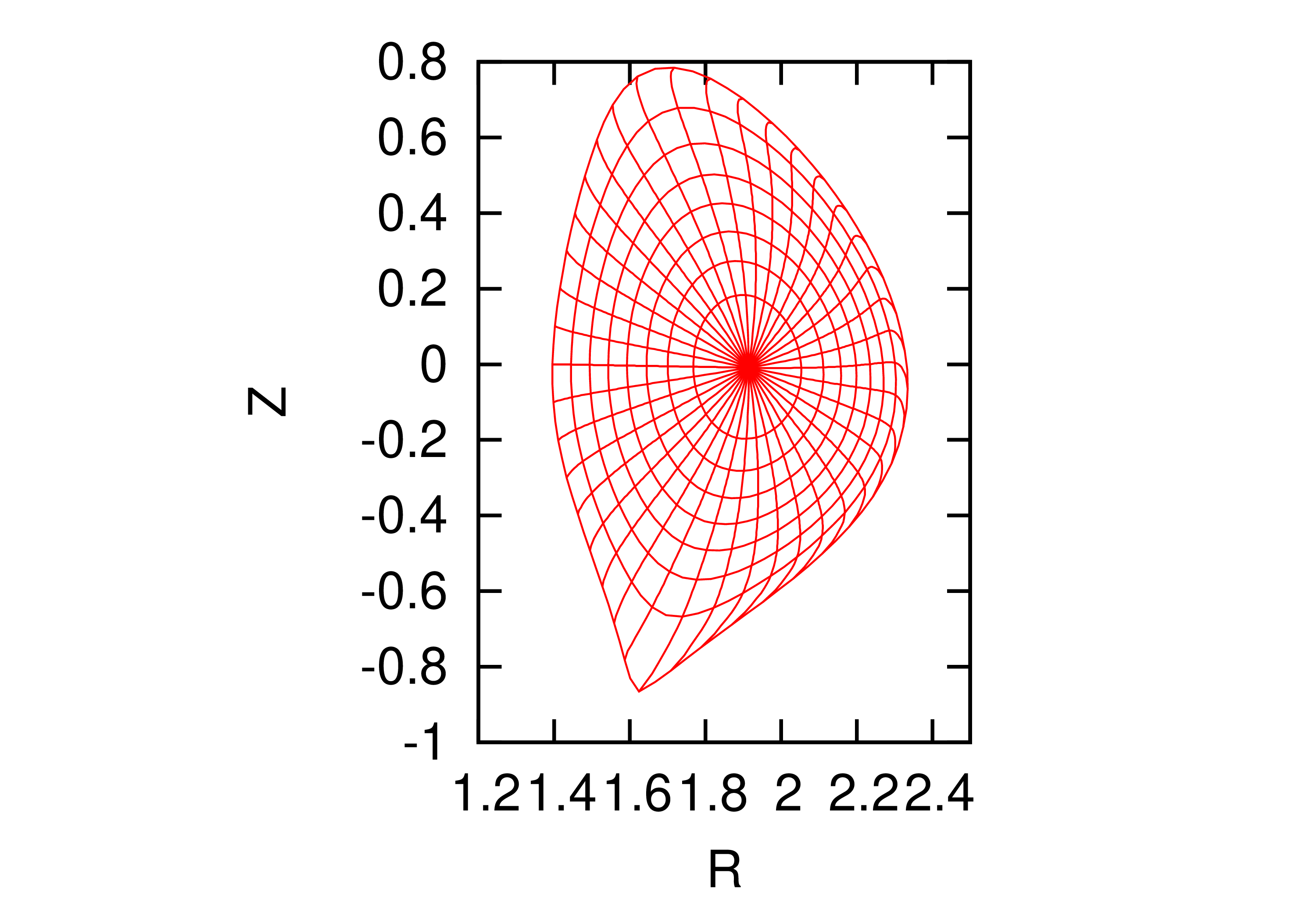 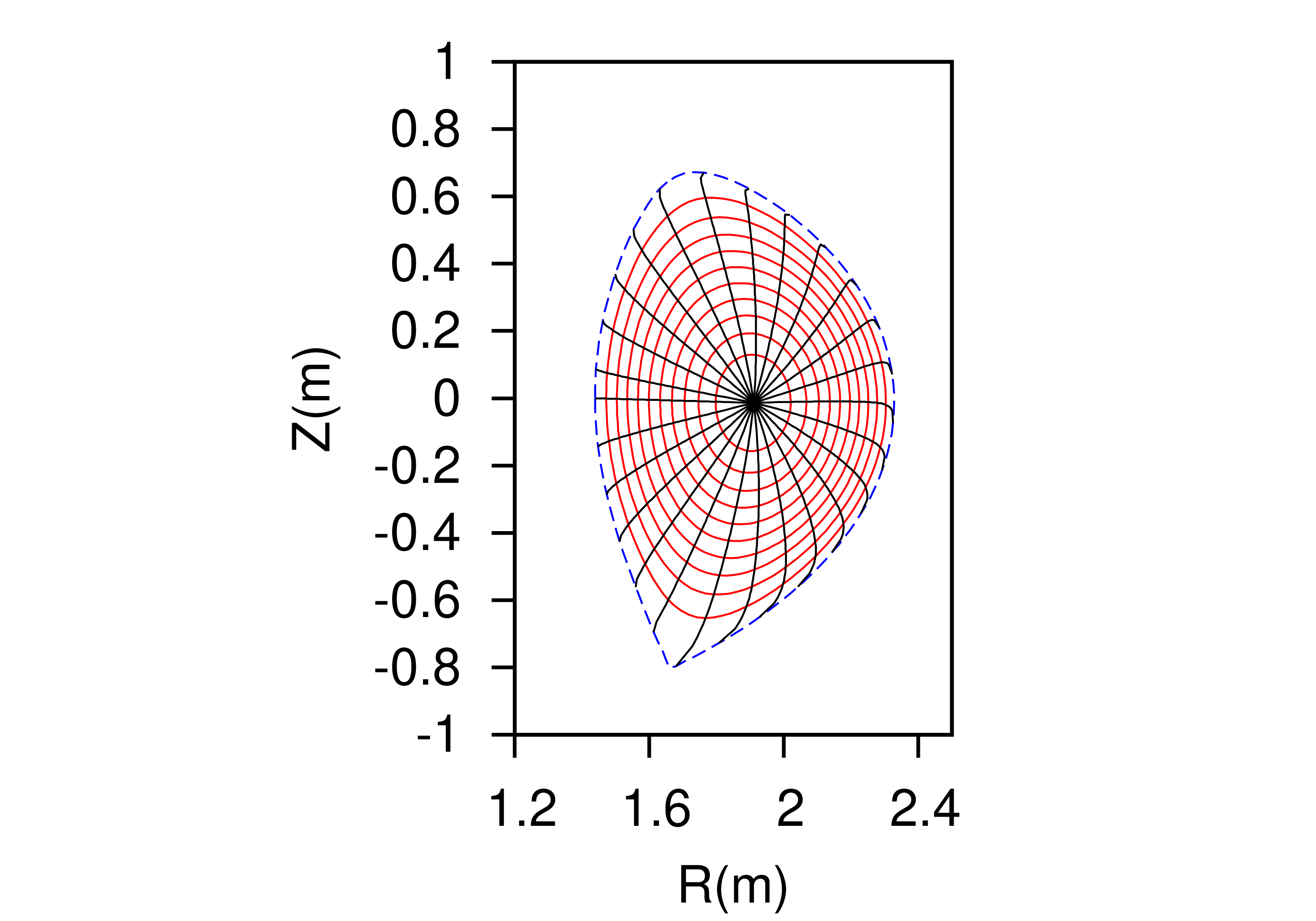 |
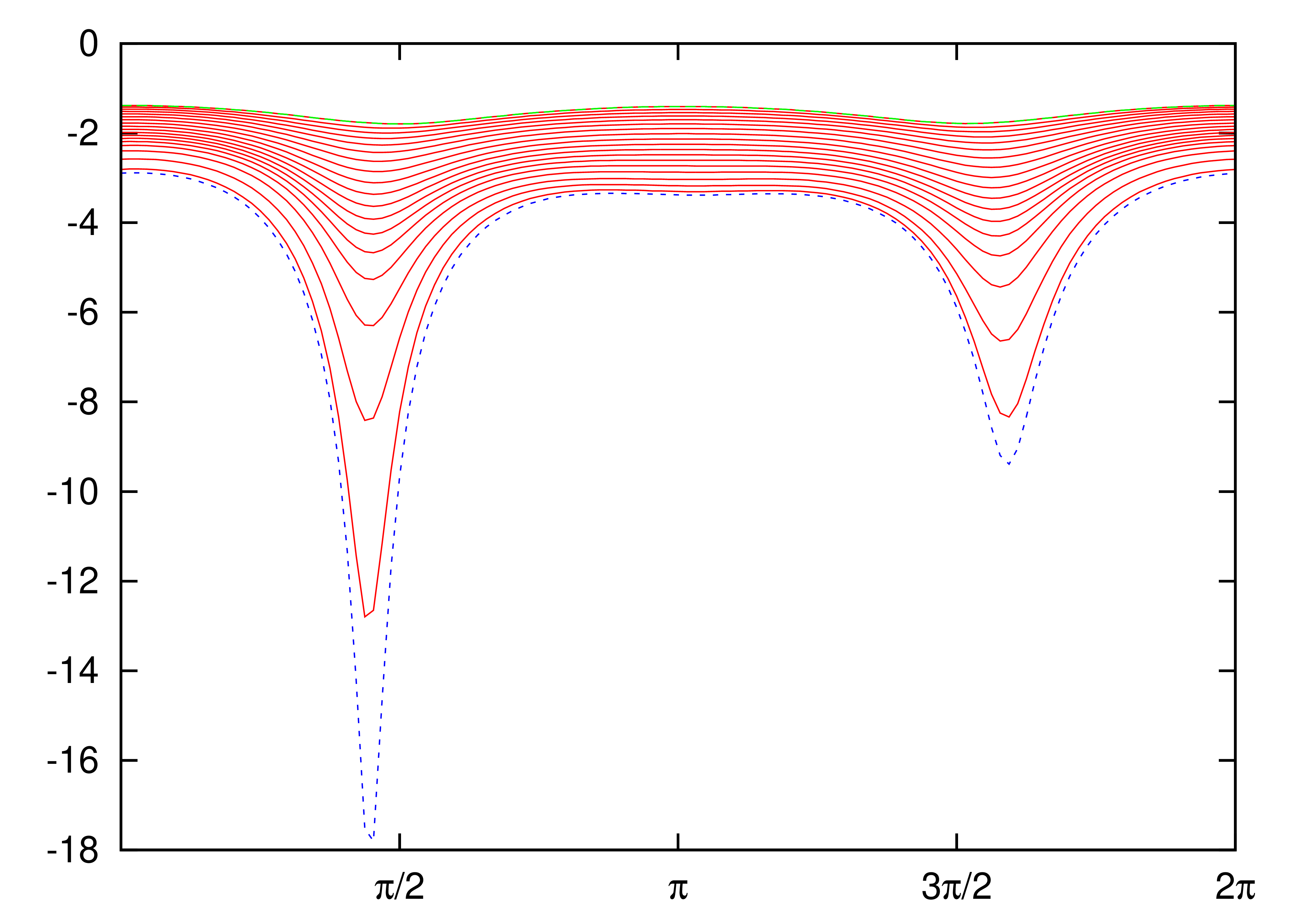 |

Metric elements of the  coordinates, e.g.,
coordinates, e.g.,  , are often needed in practical
calculations. Next, we express these metric elements in terms of the
cylindrical coordinates
, are often needed in practical
calculations. Next, we express these metric elements in terms of the
cylindrical coordinates  and their partial
derivatives with respect to
and their partial
derivatives with respect to  and
and  . Note that, in this case, the coordinate
system is
. Note that, in this case, the coordinate
system is  while
while  and
and  are functions of
are functions of  and
and  , i.e.,
, i.e.,
 |
(9.2) |
 |
(9.3) |
Then  and
and  are written as
are written as
 |
(9.4) |
 |
(9.5) |
wehre  , etc. Equations (9.4) and (9.5) can be solved to give
, etc. Equations (9.4) and (9.5) can be solved to give
 |
(9.6) |
 |
(9.7) |
Using the above expressions, the Jacobian of  coordinates,
coordinates,  , is written as
, is written as
 |
 |
 |
|
 |
 |
||
 |
 |
i.e.,
 |
(9.9) |
Using this, Expressions (9.6) and (9.7) are written as
 |
(9.10) |
and
 |
(9.11) |
Then the elements of the metric matrix are written as
 |
(9.12) |
 |
(9.13) |
and
 |
(9.14) |
Equations (9.12), (9.13), and (9.14)
are the expressions of the metric elements in terms of  ,
,  ,
,
 ,
,  , and
, and  .
[Combining the above results, we obtain
.
[Combining the above results, we obtain
 |
(9.15) |
Equation (9.14) is used in GTAW code. Using the above
results,  are written as
are written as
 |
(9.16) |
 |
(9.17) |
 |
(9.18) |
As a side product of the above results, we can calculate the arc length
in the poloidal plane along a constant  surface,
surface,
 , which is expressed as
, which is expressed as

Note that  since we are considering the arc
length along a constant
since we are considering the arc
length along a constant  surface in
surface in  plane. Then the above expression is reduced to
plane. Then the above expression is reduced to
which agrees with Eq. (8.94).]
In some cases (e.g., turbulence simulation), model tokamak magnetic
field, which is not an exact solution to the GS equation, is often used.
In the model, the safety factor profile  ,
toroidal field function
,
toroidal field function  , and
the magnetic surface shape
, and
the magnetic surface shape  are given. To use
this model in a simulation, we need to calculate its poloidal magnetic
field, which is determined by the poloidal magnetic flux function
are given. To use
this model in a simulation, we need to calculate its poloidal magnetic
field, which is determined by the poloidal magnetic flux function  . To determine
. To determine  , we need to use Eq. (8.86), i.e.,
, we need to use Eq. (8.86), i.e.,
 |
(9.20) |
and re-organize the formula as
 |
(9.21) |
which can be integrated to obtain  and thus the
poloidal magnetic field
and thus the
poloidal magnetic field  ,
where
,
where  . The toroidal magnetic
field can be obtained from
. The toroidal magnetic
field can be obtained from  by
by  . In most papers,
. In most papers,  is
chosen to be a constant.
is
chosen to be a constant.
A typical magnetic surface shape used in simulations is the Miller shape, which is given by
 |
(9.22) |
where  is the radial coordinate,
is the radial coordinate,  ,
,  ,
and
,
and  are the Shafronov shift, triangularity, and
elongation profiles, which can be arbitrarily specified. For the special
case of
are the Shafronov shift, triangularity, and
elongation profiles, which can be arbitrarily specified. For the special
case of  being a constant,
being a constant,  , and
, and  ,
this shape reduces to a concentric-circular magnetic field. An example
of calculating the poloidal field of the model field is given in Sec. 16. This kind of model field can be called theoretical
physicists' tokamak. Computational physicists often use this model for
code benchmarking purpose. The famous DIII-D cyclone base case is an
example, which was extensively used for benchmarking gyrokinetic
simulation of ion temperature driven turbulence.
,
this shape reduces to a concentric-circular magnetic field. An example
of calculating the poloidal field of the model field is given in Sec. 16. This kind of model field can be called theoretical
physicists' tokamak. Computational physicists often use this model for
code benchmarking purpose. The famous DIII-D cyclone base case is an
example, which was extensively used for benchmarking gyrokinetic
simulation of ion temperature driven turbulence.
Magnetic surface average of a physical quantity  is defined by
is defined by
 |
(10.1) |
where the volume integration is over a small volume between two adjacent
flux surfaces with  differing by
differing by  . [This formula (with finite
. [This formula (with finite  ) is used in TEK code to calculate the
radial heat flux.]
) is used in TEK code to calculate the
radial heat flux.]
The above definition can be written as
 |
(10.2) |
where the volume integration is over the volume enclosed by the magnetic
surface labeled by  .
.
The above 3D volume integration can be written as a 2D surface
integration. The differential volume element is given by  , where
, where  is the Jacobian
of
is the Jacobian
of  coordinates. equation (10.1) is
written as
coordinates. equation (10.1) is
written as
which is a 2D averaging over a magnetic surface. Noting that  is independent of
is independent of  ,
expression (10.3) can be written as
,
expression (10.3) can be written as
 |
(10.4) |
where  , which is the
, which is the  harmonic of
harmonic of  ,
where
,
where  is the toroidal mode number. Note that the
surface averaging of any
is the toroidal mode number. Note that the
surface averaging of any  harmonic is zero. I.e.,
only the
harmonic is zero. I.e.,
only the  harmonic can contribute to the magnetic
surface average.
harmonic can contribute to the magnetic
surface average.
In flux coordinates, Eq. (10.2) can be written as
where  . (For the surface
average, in some parts of these notes, I assume that the Jacobian is
postive and thus the absolute value operator is dropped. In most part of
this document, axisymmetry is assumed for
. (For the surface
average, in some parts of these notes, I assume that the Jacobian is
postive and thus the absolute value operator is dropped. In most part of
this document, axisymmetry is assumed for  ,
i.e.,
,
i.e.,  .)
.)
The volume within a magnetic surface is written
 |
(10.6) |
Then the differential of  with respect to
with respect to  is written as
is written as
 |
(10.7) |
Sometimes, we do not want the Jacobian to explicitly appear in the formula. This can be achieved by using Eq. (8.94), i.e.,
 |
(10.8) |
Then expression (10.4) is written as
(Equation (10.9) is used in GTAW code[14].)
The parallel current density appears in the flux diffusion equation. Let
us derive a formula for it in the flux coordinates. Using  , along with magnetic field expression (8.80) and the curl formula (8.42), we obtain
, along with magnetic field expression (8.80) and the curl formula (8.42), we obtain
where  ,
,  . Expression (10.10) is the
contravariant form of
. Expression (10.10) is the
contravariant form of  .
Taking dot product between Eqs. (8.80) and (10.10),
we obtain
.
Taking dot product between Eqs. (8.80) and (10.10),
we obtain
 |
 |
 |
|
 |
|||
 |
 |
||
 |
|||
 |
 |
||
 |
 |
Using the defintion of the magnetic surface average, Eq. (10.5), i.e.,

we obtain
which agrees with Eq. (5) in Ref. [23].
This is an interesting way of defining flux within a magnetic surface using volume integration, instend of surface integration. Examine the meaning of the following volume integral:
 |
(11.1) |
where the volume  is the volume within the
magnetic surface labeled by
is the volume within the
magnetic surface labeled by  .
Using
.
Using  , the quantity
, the quantity  can be further written as
can be further written as
 |
(11.2) |
Note that  is not a single-value function of the
spacial points. In order to evaluate the integration in Eq. (11.2),
we need to select one branch of
is not a single-value function of the
spacial points. In order to evaluate the integration in Eq. (11.2),
we need to select one branch of  ,
which can be chosen to be
,
which can be chosen to be  .
Note that function
.
Note that function  is not continuous at the
branch cut
is not continuous at the
branch cut  . Next, we want to
use the divergence theorem to convert the above volume integration to
surface integration. Noting the discontinuity of the integrand
. Next, we want to
use the divergence theorem to convert the above volume integration to
surface integration. Noting the discontinuity of the integrand  at
at  , the volume
should be cut there, thus, generating two surfaces. Denote these two
surfaces by
, the volume
should be cut there, thus, generating two surfaces. Denote these two
surfaces by  and
and  ,
then equation (11.2) is written as
,
then equation (11.2) is written as

where the orientation of surface  is in the
negative direction of
is in the
negative direction of  , the
orientation of
, the
orientation of  is in the positive direction of
is in the positive direction of
 , and the surface
, and the surface  is the toroidal magnetic surface
is the toroidal magnetic surface  . The surface integration through
. The surface integration through  is obviously zero since
is obviously zero since  lies in this surface.
Therefore, we have
lies in this surface.
Therefore, we have
Eq. (11.3) indicates that  is the
magnetic flux through the
is the
magnetic flux through the  surface. This is the
flux
surface. This is the
flux  defined by Eq. (1.25), i.e.,
defined by Eq. (1.25), i.e.,
 |
(11.4) |
[We can also directly verify  defined by Eq. (11.4) is the poloidal flux, without using the divergence
theorem. Using the expression of the volume element
defined by Eq. (11.4) is the poloidal flux, without using the divergence
theorem. Using the expression of the volume element  ,
,
Note that the sign of the Jacobian appears in Eq. (11.5),
which is due to the positive direction of surface  is determined by the positive direction of
is determined by the positive direction of  ,
which in turn is determined by the sign of the Jacobian (In my code,
however, the positive direction of
,
which in turn is determined by the sign of the Jacobian (In my code,
however, the positive direction of  is chosen by
me and the sign of the Jacobian is determined by the positive direction
of
is chosen by
me and the sign of the Jacobian is determined by the positive direction
of  ). We can verify the sign
of Eq. (11.5) is consistent with that in Eq. (1.25).]
). We can verify the sign
of Eq. (11.5) is consistent with that in Eq. (1.25).]
Similarly, the toroidal flux within a flux surface is written as
 |
 |
 |
|
 |
 |
In flux coordinates,  is written as
is written as
from which, we can also obtain
 |
(11.9) |
and
 |
(11.10) |
Using  , we obtain
, we obtain
 |
(11.11) |
Similarly, the toroidal current within a flux surface is written as
 |
(11.12) |
Let us express  in flux coordinates:
in flux coordinates:
Use Eq. (3.6), i.e.,
 |
(11.15) |
and Eq. (13.4), i.e.,
 |
(11.16) |
then  is written as
is written as

Then the surface average is written as
 |
 |
 |
|
 |
 |
||
 |
 |
||
 |
 |
||
 |
 |
Using this in Eq. (11.14), we obtain
Faraday's law
 |
(12.1) |
can be written in the integral form:
 |
(12.2) |
where  is the flux linked with the loop. Choosing
an axisymmetric loop along
is the flux linked with the loop. Choosing
an axisymmetric loop along  ,
and assuming
,
and assuming  is axisymmetric, Eq. (12.2)
is written as
is axisymmetric, Eq. (12.2)
is written as

i.e.,

Using  , the above equation is
written as
, the above equation is
written as
 |
(12.3) |
Use Ohm's law

(where  stands for all the terms on the rhs of
Ohm's law, typically
stands for all the terms on the rhs of
Ohm's law, typically  , where
, where
 is the total current density and
is the total current density and  is the non-inductive part), to eliminate
is the non-inductive part), to eliminate  , then Eq. (12.3) is written as
, then Eq. (12.3) is written as
 |
(12.4) |
Using  to eliminate
to eliminate  on
the rhs, we obtain
on
the rhs, we obtain
 |
(12.5) |
Noting that  , the above
equation is simplified to
, the above
equation is simplified to
 |
(12.6) |
This is an evolution equation for the poloidal flux function  in the lab frame.
in the lab frame.
Next, let us derive an evolution equation for the toroidal field
function  . The
. The  projection of Faraday's law (12.1) is written
as
projection of Faraday's law (12.1) is written
as
 |
(12.7) |
i.e.,
 |
(12.8) |
Use Ohm's law to eliminate  ,
then Eq. (12.8) is written as
,
then Eq. (12.8) is written as
 |
(12.9) |
i.e.,
 |
(12.10) |
Next, let us write Eqs. (12.6) and (12.10) in
a general magnetic coordinate system  that is
time-dependent (relative to the laboratory static coordinate system).
Why do we need a magnetic coordinate system? Because it makes it easy to
perform the magnetic surface average when we derive 1D transport
equations. Then why do we require the magnetic coordinates to be
time-dependent? Because the magnetic surface shapes are evolving, and
thus a static transform can not remain conform to the evolving shapes.
that is
time-dependent (relative to the laboratory static coordinate system).
Why do we need a magnetic coordinate system? Because it makes it easy to
perform the magnetic surface average when we derive 1D transport
equations. Then why do we require the magnetic coordinates to be
time-dependent? Because the magnetic surface shapes are evolving, and
thus a static transform can not remain conform to the evolving shapes.
For a time-dependent coordinate transform:

where  stands for a laboratory static Cartesian
coordinate system
stands for a laboratory static Cartesian
coordinate system  , it
follows that
, it
follows that
 |
 |
 |
|
 |
 |
where
 |
(12.12) |
is the coordinate velocity. Further define
 |
(12.13) |
which is the fluid velocity observed in  coordinate system.
coordinate system.
Note that the flux evolution equation (12.6) is written in a laboratory static coordinate system, i.e.,
 |
(12.14) |
Then in time-dependent  coordinate system, the
above equation is written as
coordinate system, the
above equation is written as
 |
(12.15) |
Noting  , the above equation
is simplified to
, the above equation
is simplified to
 |
(12.16) |
Now we restrict  to be flux coordinates (i.e.,
contours of
to be flux coordinates (i.e.,
contours of  are contours of
are contours of  ) and remain flux coordinates when both
) and remain flux coordinates when both  and
and  evolve. Then the rhs of
Eq. (12.16) must be chosen to be independent of
evolve. Then the rhs of
Eq. (12.16) must be chosen to be independent of  , i.e.,
, i.e.,
 |
(12.17) |
where  is a function to be determined. For later
use, multiplying the above equation by
is a function to be determined. For later
use, multiplying the above equation by  :
:
 |
(12.18) |
and performing the magnetic surface average on it, we obtain
 |
(12.19) |
Next, consider the evolution equation for  ,
Eq. (12.10), which can be written as
,
Eq. (12.10), which can be written as
 |
(12.20) |
We note that  . Then the above
equation is written as
. Then the above
equation is written as
 |
(12.21) |
To facilitate later use, we multiply the above equation by the Jacobian
J of  coordinates:
coordinates:

i.e.,

Tansforming to time-dependent  coordinate system,
the above equation is written as
coordinate system,
the above equation is written as
For notation ease, the subscripts ( )
of the time derivative is dropped in the following, with the
understanding that the time derivatives are taken with (
)
of the time derivative is dropped in the following, with the
understanding that the time derivatives are taken with ( ) held fixed. Equation (12.22)
simplifies to
) held fixed. Equation (12.22)
simplifies to

Noting that  , the above
equation is written as
, the above
equation is written as

which simplifies to
Use the well known relation (to be proved):
 |
(12.24) |
then Eq. (12.23) simplifies to
 |
(12.25) |
Integrating Eq. (12.25) over  :
:

we obtain
 |
(12.26) |
Using the defintion of the surface average, Eq. (10.5), i.e.,

(where  ,
,  is the volume enclosed by surface
is the volume enclosed by surface  ),
Eq. (12.26) is written as
),
Eq. (12.26) is written as
 |
(12.27) |
Noting the relation (proof is given in Sec. A.1):
 |
(12.28) |
Eq. (12.27) is written as

Noting that  , the above
equation is simplified to
, the above
equation is simplified to
 |
(12.29) |
The toroidal magnetic flux is given by Eq. (11.8), i.e.,

Then the time partial derivative in  coordinates
is written as
coordinates
is written as
Use Eq. (12.29), then Eq. (12.30) is written as
where use has been made of the fact that  at
at
 .
.
If we choose  as the toroidal magnetic flux,
i.e.,
as the toroidal magnetic flux,
i.e.,  (or more general
(or more general  , where
, where  is an arbitrary
time-independent monotonical function), then, by defintion
is an arbitrary
time-independent monotonical function), then, by defintion
 |
(12.32) |
Combining this with Eqs. (12.31), we get
 |
(12.33) |
This is a condition that the coordinate velocity  (and thus
(and thus  ) satisfies when
you choose
) satisfies when
you choose  as
as  .
.
Meanwhile, as is discussed above, the requirement of  being flux coordinates imposes a constraint given by Eq. (12.17).
Next, we combine this constraint with Eq. (12.33) to
uniquely determine
being flux coordinates imposes a constraint given by Eq. (12.17).
Next, we combine this constraint with Eq. (12.33) to
uniquely determine  appearing in Eq. (12.17).
Mutiplying Eq. (12.33) by
appearing in Eq. (12.17).
Mutiplying Eq. (12.33) by  and then
adding it to Eq. (12.19), we obtain
and then
adding it to Eq. (12.19), we obtain

which simplifies to ( terms cancel out)
terms cancel out)

i.e.,
 |
(12.34) |
Then the poloidal magnetic flux diffusion equation is written as
 |
(12.35) |
Note that it is in the moving flux coordinates  that the poloidal magnetic flux diffusion can be written in the form
given by Eq. (12.35). Before I did the above derivation, I
considered Eq. (12.35) (which appears in many papers) as an
approximate equation in static lab frame (approximating the toroidal
component by the parallel component). It turns out that it is an exact
equation in the moving coordinate system.
that the poloidal magnetic flux diffusion can be written in the form
given by Eq. (12.35). Before I did the above derivation, I
considered Eq. (12.35) (which appears in many papers) as an
approximate equation in static lab frame (approximating the toroidal
component by the parallel component). It turns out that it is an exact
equation in the moving coordinate system.
We can switch the role of  and
and  and do similar derivation as the above. I.e., we choose
and do similar derivation as the above. I.e., we choose  and derive an evolution equation for the toroidal flux
and derive an evolution equation for the toroidal flux  . (It would be interesting to do this
derivation. to be done.) But most researchers have chosen
. (It would be interesting to do this
derivation. to be done.) But most researchers have chosen  . Some reasons behind this choice
are as follows. Like the poloidal flux, the toroidal flux is contributed
by two parts: coils and plasma. Different from the poloidal flux, the
toroidal flux is mainly contributed by the coils. This is because the
plasma poloidal current (which contributes to the toroidal flux) is much
smaller than the TF coil currents. Because TF coil currents usually do
not change during one discharge, the toroidal flux
. Some reasons behind this choice
are as follows. Like the poloidal flux, the toroidal flux is contributed
by two parts: coils and plasma. Different from the poloidal flux, the
toroidal flux is mainly contributed by the coils. This is because the
plasma poloidal current (which contributes to the toroidal flux) is much
smaller than the TF coil currents. Because TF coil currents usually do
not change during one discharge, the toroidal flux  remains almost constant in a discharge (small variation is contributed
by the varying plasma poloidal current, which is much smaller than the
TF coil current). We usually prefer to our coordinate not moving
significantly with respect to the lab frame. So we prefer
remains almost constant in a discharge (small variation is contributed
by the varying plasma poloidal current, which is much smaller than the
TF coil current). We usually prefer to our coordinate not moving
significantly with respect to the lab frame. So we prefer  over
over  .
.
A confusion I once had: if you choose  ,
then
,
then  can also be considered as a function of
can also be considered as a function of
 because
because  is a function of
is a function of
 . Then why does it matter
which one is chosen in the above derivation? The reason why we can not
easily switch between
. Then why does it matter
which one is chosen in the above derivation? The reason why we can not
easily switch between  and
and  is that thier relation is time-dependent, i.e.,
is that thier relation is time-dependent, i.e.,  . This time-dependence will show up when we want to
switch from one to another.
. This time-dependence will show up when we want to
switch from one to another.
Assume  , then Eq. (12.35)
is written as
, then Eq. (12.35)
is written as
 |
(12.36) |
Using Eq. (10.12), the above equation is written as
 |
(12.37) |
Define  by
by
 |
(12.38) |
where  is typical value of the toroidal field (a
space-time constant). Since
is typical value of the toroidal field (a
space-time constant). Since  is a
time-independent function of
is a
time-independent function of  ,
so
,
so  can be used as the radial coordinate, i.e.,
can be used as the radial coordinate, i.e.,
 . Then Eq. (12.37)
is written as
. Then Eq. (12.37)
is written as
 |
(12.39) |
which agrees with Eq. (8) in Ref. [23]. The radial derivative of volume is written as
 |
(12.40) |
where use has been made of Eq. (11.10), i.e.,  .
.
 |
(12.41) |
We know that  and
and  at the
magnetic axis. We also know that the safety factor
at the
magnetic axis. We also know that the safety factor  is nonzero at the magnetic axis. Then Eq. (12.41) implies
is nonzero at the magnetic axis. Then Eq. (12.41) implies
 |
(12.42) |
which serves as an inner boundary for the diffusion equation (12.39).
Using Eq. (11.18), the outer boundary condition can be written as
 |
(12.43) |
where

The fixed boundary equilibrium problem (also called the “inverse equilibrium problem” by some authors) refers to the case where the shape of a boundary magnetic surface is given and one is asked to solve the equilibrium within this magnetic surface. To make it convenient to deal with the shape of the boundary, one usually uses a general coordinates system which has one coordinate surface coinciding with the given magnetic surface. This makes it trivial to deal with the irregular boundary. To obtain the equilibrium, one needs to solve the GS equation in the general coordinate system.
Next we derive the form of the toroidal elliptic operator  in a general curvilinear coordinate system. Specifically,
we consider a curvilinear coordinate system
in a general curvilinear coordinate system. Specifically,
we consider a curvilinear coordinate system  , which is an arbitrary coordinate system except
that
, which is an arbitrary coordinate system except
that  is perpendicular to both
is perpendicular to both  and
and  .
.
The toroidal elliptic operator takes the form given by Eq. (3.7), i.e.,
 |
(13.1) |
The gradient of  is written as (note that
is written as (note that  is independent of
is independent of  )
)
 |
(13.2) |
Using this expression and the divergence formula (8.36), the elliptic operator in Eq. (13.1) is written
where the subscripts denotes partial derivatives,  is the Jacobian of the coordinate system
is the Jacobian of the coordinate system  .
.
In a flux coordinate system,  is independent of
is independent of
 , i.e.,
, i.e.,  . Then the toroidal elliptic operator is
written as
. Then the toroidal elliptic operator is
written as
 |
(13.4) |
Using Eq. (13.3), the GS equation (4.13) is written
which is the form of the GS equation in  coordinate system.
coordinate system.
The toroidal elliptic operator in Eq. (13.3) can be written
 |
(13.6) |
where  is defined by Eq. (8.77),
i.e.,
is defined by Eq. (8.77),
i.e.,
 |
(13.7) |
Next, we derive the finite difference form of the toroidal elliptic
operator. The finite difference form of the term  is written
is written
 |
 |
 |
|
 |
 |
where
 |
(13.9) |
The finite difference form of  is written
is written
 |
 |
 |
|
 |
 |
where
 |
(13.11) |
The finite difference form of  is written as
is written as
 |
(13.12) |
Approximating the value of  at the grid centers
by the average of the value of
at the grid centers
by the average of the value of  at the neighbor
grid points, Eq. (13.12) is written as
at the neighbor
grid points, Eq. (13.12) is written as
 |
(13.13) |
where
 |
(13.14) |
Similarly, the finite difference form of  is
written as
is
written as
 |
 |
 |
|
 |
 |
Using the above results, the finite difference form of the operator  is written as
is written as

The coefficients are given by
 |
(13.16) |
 |
(13.17) |
and
 |
(13.18) |
where the Jacobian
 |
(13.19) |
The partial derivatives,  ,
,
 ,
,  , and
, and  ,
appearing in Eqs. (13.16)-(13.19) are
calculated by using the central difference scheme. The values of
,
appearing in Eqs. (13.16)-(13.19) are
calculated by using the central difference scheme. The values of  ,
,  ,
,
 and
and  at the middle points
are approximated by the linear average of their values at the neighbor
grid points.
at the middle points
are approximated by the linear average of their values at the neighbor
grid points.
The function  and
and  in the
GS equation are free functions which must be specified by users before
solving the GS equation. Next, we discuss one way to specify the free
functions. Following Ref. [15], we take
in the
GS equation are free functions which must be specified by users before
solving the GS equation. Next, we discuss one way to specify the free
functions. Following Ref. [15], we take  and
and  to be of the forms
to be of the forms
 |
(13.20) |
 |
(13.21) |
with  and
and  chosen to be of
polynomial form:
chosen to be of
polynomial form:
 |
(13.22) |
 |
(13.23) |
where
 |
(13.24) |
with  the value of
the value of  on the
boundary,
on the
boundary,  the value of
the value of  on the magnetic axis,
on the magnetic axis,  ,
,  ,
,  ,
,
 ,
,  , and
, and  are free parameters.
Using the profiles of
are free parameters.
Using the profiles of  and
and  given by Eqs. (13.20) and (13.21), we obtain
given by Eqs. (13.20) and (13.21), we obtain
 |
(13.25) |
where  , and
, and
 |
(13.26) |
Then the term on the r.h.s (nonlinear source term) of the GS equation is written
 |
(13.27) |
The value of parameters  ,
,
 , and
, and  in Eqs. (13.20) and (13.21), and the value of
in Eqs. (13.20) and (13.21), and the value of
 and
and  in Eqs. (13.22)
and (13.23) can be chosen arbitrarily. The parameter
in Eqs. (13.22)
and (13.23) can be chosen arbitrarily. The parameter  is used to set the value of the total toroidal
current. The toroidal current density is given by Eq. (A.79),
i.e.,
is used to set the value of the total toroidal
current. The toroidal current density is given by Eq. (A.79),
i.e.,
 |
(13.28) |
which can be integrated over the poloidal cross section within the boundary magnetic surface to give the total toroidal current,
Using
 |
(13.30) |
Eq. (13.29) is written as
 |
(13.31) |
from which we solve for  ,
giving
,
giving
 |
(13.32) |
If the total toroidal current  is given, Eq. (13.32) can be used to determine the value of
is given, Eq. (13.32) can be used to determine the value of  .
.
In the fixed boundary equilibrium problem, the shape of the boundary magnetic surface (it is also the boundary of the computational region) is given while the shape of the inner flux surface is to be solved. A simple analytical expression for a D-shaped magnetic surface takes the form
 |
(13.33) |
 |
(13.34) |
with  changing from
changing from  to
to
 . According to the definition
in Eqs. (A.21), (A.22), and (A.24)
we can readily verify that the parameters
. According to the definition
in Eqs. (A.21), (A.22), and (A.24)
we can readily verify that the parameters  ,
,
 ,
,  appearing in Eqs. (13.33) and (13.34) are
indeed the minor radius, major radius, and ellipticity, respectively.
According to the definition of triangularity Eq. (A.23),
the triangularity
appearing in Eqs. (13.33) and (13.34) are
indeed the minor radius, major radius, and ellipticity, respectively.
According to the definition of triangularity Eq. (A.23),
the triangularity  for the magnetic surface
defined by Eqs. (13.33) and (13.34) is written
as
for the magnetic surface
defined by Eqs. (13.33) and (13.34) is written
as
 |
(13.35) |
Another common expression for the shape of a magnetic surface was given by Miller[7, 21], which is written as
 |
(13.36) |
 |
(13.37) |
Note that Miller's formula is only slightly different from the formula
(13.33). For Miller's formula, it is easy to prove that the
triangularity  is equal to
is equal to  (instead of
(instead of  as given in Eq. (13.35)).
as given in Eq. (13.35)).
In the iterative metric method[10] for solving the fixed boundary equilibrium problem, we need to provide an initial guess of the shape of the inner flux surface (this initial guess is used to construct a initial generalized coordinates system). A common guess of the inner flux surfaces is given by
 |
(13.38) |
 |
(13.39) |
where  is a parameter,
is a parameter,  is
a label parameter of flux surface. If the shape of the LCFS is given by
Eqs. (13.33) and (13.34), then Eqs. (13.38)
and (13.39) are written as
is
a label parameter of flux surface. If the shape of the LCFS is given by
Eqs. (13.33) and (13.34), then Eqs. (13.38)
and (13.39) are written as
 |
(13.40) |
 |
(13.41) |
Fig. 13.1 plots the shape given by Eqs. (13.40)
and (13.41) for  0.4,
0.4,
 ,
,  ,
,  , and
, and
 with
with  varying from zero
to one.
varying from zero
to one.
  |
Figure 13.1. Shape of flux surface
given by Eqs. (13.40) and (13.41).
Left figure: points with the same value of |
The tokamak equilibrium problem where the shape of the LCFS is given is called fixed boundary equilibrium problem. I wrote a numerical code that uses the iterative metric method[10] to solve this kind of equilibrium problem. Figure 13.2 describes the steps involved in the iterative metric method.
To benchmark the numerical code, I set the profile of  and
and  according to Eqs. (A.37) and
(A.38) with the parameters
according to Eqs. (A.37) and
(A.38) with the parameters  ,
,
 ,
,  , and
, and  .
The comparison of the analytic and numerical results are shown in Fig.
13.3.
.
The comparison of the analytic and numerical results are shown in Fig.
13.3.
 |
Figure 13.3. Agreement between the
magnetic surfaces (contours of |
Note that the parameter  in the Solovev
equilibrium seems to be not needed in the numerical calculation. In fact
this impression is wrong: the
in the Solovev
equilibrium seems to be not needed in the numerical calculation. In fact
this impression is wrong: the  parameter is
actually needed in determining the boundary magnetic surface of the
numerical equilibrium (in the case considered here
parameter is
actually needed in determining the boundary magnetic surface of the
numerical equilibrium (in the case considered here  is chosen as
is chosen as  ).
).
With the pressure increasing, the magnetic axis usually shifts to the low-field-side of the device, as is shown in Fig. 13.4.
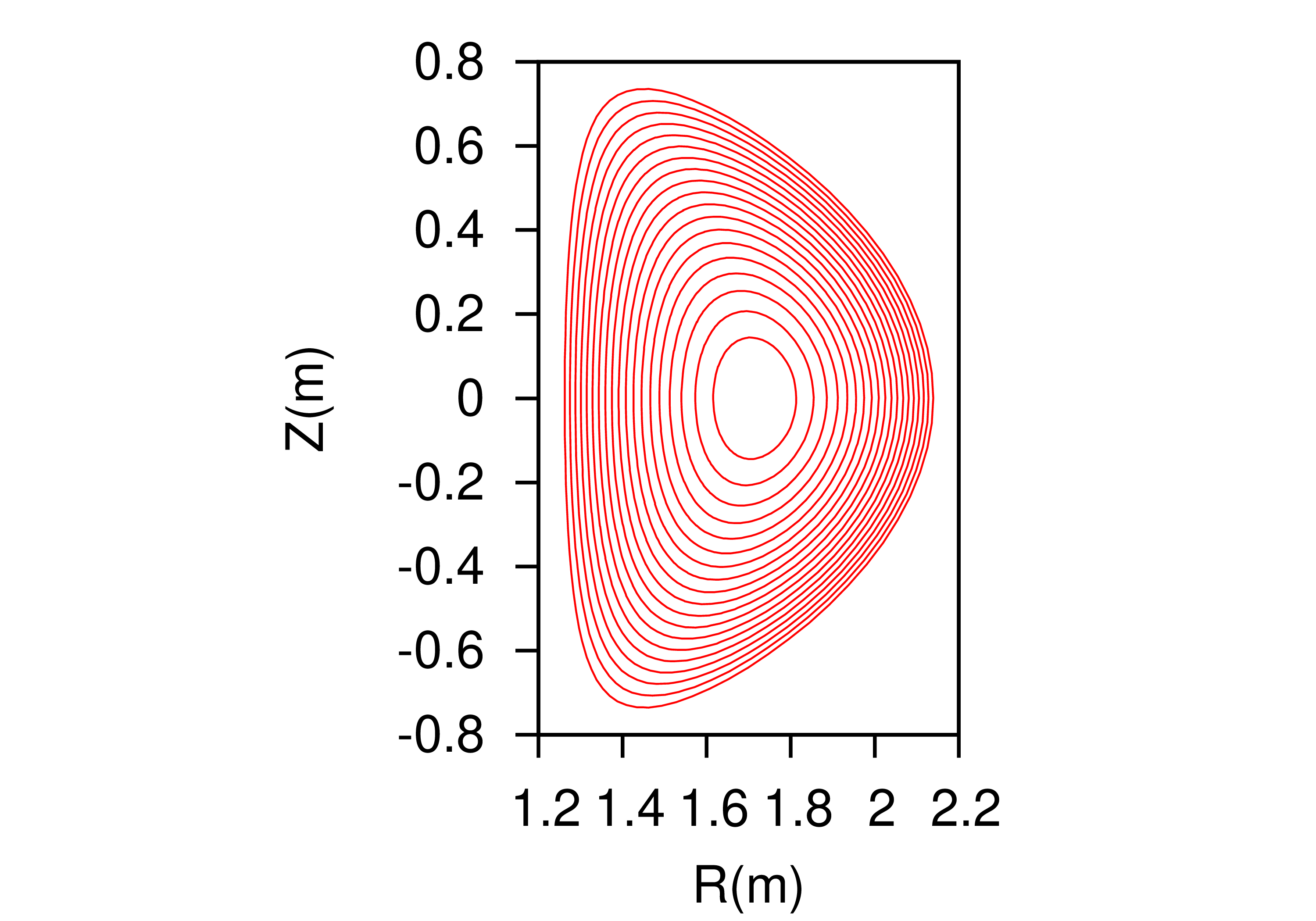 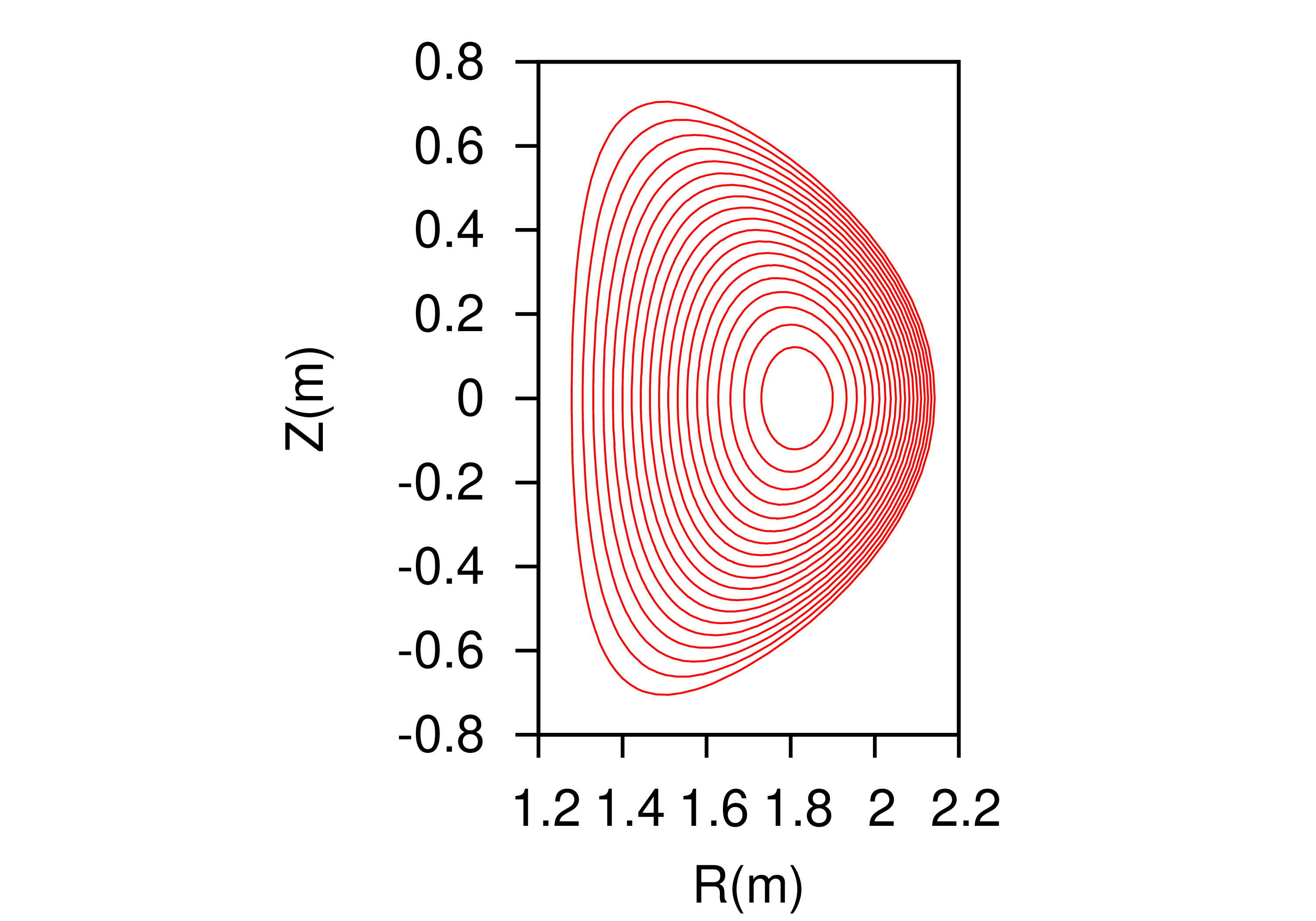 |
In the GS equation,  is one of the two free
functions which can be prescribed by users. In some cases, we want to
specify the safety factor profile
is one of the two free
functions which can be prescribed by users. In some cases, we want to
specify the safety factor profile  ,
instead of
,
instead of  , in solving the
GS equation. Next, we derive the form of the GS equation that contains
, in solving the
GS equation. Next, we derive the form of the GS equation that contains
 , rather than
, rather than  , as a free function. The safety factor defined
in Eq. (8.86) can be written
, as a free function. The safety factor defined
in Eq. (8.86) can be written
Equation (13.44) gives the relation between the safety
factor  and the toroidal field function
and the toroidal field function  . This relation can be used in the
GS equation to eliminate
. This relation can be used in the
GS equation to eliminate  in favor of
in favor of  , which gives
, which gives
 |
(13.45) |
 |
(13.46) |
Note that this expression involves the flux surface average, which
depends on the flux surface shape and the shape is unknown before  is determined.
is determined.
Multiplying Eq. (A.102) by  gives
gives
 |
(13.47) |
Surface-averaging the above equation, we obtain
 |
(13.48) |
 |
(13.49) |
 |
(13.50) |
 |
(13.51) |
 |
(13.52) |
Substitute Eq. (13.46) into the above equation to eliminate
 , we obtain
, we obtain
 |
(13.53) |
Eq. (13.53) agrees with Eq. (5.55) in Ref. [15].
 |
(13.54) |
 |
(13.55) |
where
 |
(13.56) |
The GS equation is
 |
(13.57) |
 |
(13.58) |
 |
(13.59) |
Using Eq. (13.55) to eliminate  in
the above equation, the coefficients before (
in
the above equation, the coefficients before ( ) is written as
) is written as
 |
 |
 |
|
 |
 |
Substituting the expression of  into the above
equation, we obtain
into the above
equation, we obtain
which is equal to the expression (5.58) in Ref. [15]. The
coefficient before  is written as
is written as

Define



 |
(13.62) |
 |
(13.63) |
Using
 |
(13.64) |
Eq. () is written as
 |
(13.65) |
 |
(13.66) |
 |
(13.67) |
 |
(13.68) |
 |
(13.69) |
 |
(13.70) |
 |
(13.71) |
 |
(13.72) |
 |
(13.73) |
 |
(13.74) |
But the expression of  is slightly different from
that given in Ref. [15] [Eq. (5.57)]. Using the above
coefficients, the GS equation with the
is slightly different from
that given in Ref. [15] [Eq. (5.57)]. Using the above
coefficients, the GS equation with the  -profile
held fixed is written as
-profile
held fixed is written as
 |
(13.75) |

In Sec. 8.12, we introduced the local safety factor  . Equation (8.82)
indicates that if the Jacobian is chosen to be of the particular form
. Equation (8.82)
indicates that if the Jacobian is chosen to be of the particular form
 , then the local safety
factor is independent of
, then the local safety
factor is independent of  ,
i.e., magnetic line is straight in
,
i.e., magnetic line is straight in  plane. On the
other hand, if we want to make field line straight in
plane. On the
other hand, if we want to make field line straight in  plane, the Jacobian must be chosen to be of the specific form
plane, the Jacobian must be chosen to be of the specific form  . We note that, as mentioned in
Sec. 8.14, the poloidal angle is fully determined by the
choice of the Jacobian. The specific choice of
. We note that, as mentioned in
Sec. 8.14, the poloidal angle is fully determined by the
choice of the Jacobian. The specific choice of  is usually too restrictive for achieve a desired poloidal resolution
(for example, the equal-arc poloidal angle can not be achieved by this
choice of Jacobian). Is there any way that we can make the field line
straight in a coordinate system at the same time ensure that the
Jacobian can be freely adjusted to obtain desired poloidal angle? The
answer is obvious: Yes, we can achieve this by defining a new toroidal
angle
is usually too restrictive for achieve a desired poloidal resolution
(for example, the equal-arc poloidal angle can not be achieved by this
choice of Jacobian). Is there any way that we can make the field line
straight in a coordinate system at the same time ensure that the
Jacobian can be freely adjusted to obtain desired poloidal angle? The
answer is obvious: Yes, we can achieve this by defining a new toroidal
angle  that generalizes the usual (cylindrical)
toroidal angle
that generalizes the usual (cylindrical)
toroidal angle  . Define a new
toroidal angle
. Define a new
toroidal angle  by[9]
by[9]
 |
(14.1) |
where  is a unknown function to be determined by
the constraint of field line being straight in
is a unknown function to be determined by
the constraint of field line being straight in  plane. Using Eq. (8.83), the new local safety factor in
plane. Using Eq. (8.83), the new local safety factor in
 coordinates is written as
coordinates is written as
To make the new local safety factor be independent of  , the right-hand side of Eq. (14.2)
should be independent of
, the right-hand side of Eq. (14.2)
should be independent of  ,
i.e.,
,
i.e.,
 |
(14.3) |
where  can be an arbitrary function of
can be an arbitrary function of  . A convenient choice for
. A convenient choice for  is
is  , i.e.,
making the new local safety factor be equal to the original global
safety factor, i.e.,
, i.e.,
making the new local safety factor be equal to the original global
safety factor, i.e.,  . In
this case, equation (14.3) is written as
. In
this case, equation (14.3) is written as
 |
(14.4) |
which, on a magnetic surface labed by  ,
can be integrated over
,
can be integrated over  to give
to give
 |
(14.5) |
where  is an starting poloidal angle arbitrarily
chosen for the integration, and
is an starting poloidal angle arbitrarily
chosen for the integration, and  is the constant
of integration. In the following, both
is the constant
of integration. In the following, both  and
and  will be chosen to be zero. Then the above equations
is written
will be chosen to be zero. Then the above equations
is written
 |
(14.6) |
Substituting the above expression into the definition of  (Eq. 14.1), we obtain
(Eq. 14.1), we obtain
 |
(14.7) |
which is the formula for calculating the general toroidal angle. If  is a straight-field line poloidal angle, then
is a straight-field line poloidal angle, then  in Eq. (14.7) reduces to the usual
toroidal angle
in Eq. (14.7) reduces to the usual
toroidal angle  .
.
In summary, magnetic field line is straight in  plane with slope being
plane with slope being  if
if  is defined by Eq. (14.7). In this method, we make the field
line straight by defining a new toroidal angle, instead of requiring the
Jacobian to take particular forms. Thus, the freedom of choosing the
form of the Jacobian is still available to be used later to choose a
good poloidal angle coordinate. Note that the Jacobian of the new
coordinates
is defined by Eq. (14.7). In this method, we make the field
line straight by defining a new toroidal angle, instead of requiring the
Jacobian to take particular forms. Thus, the freedom of choosing the
form of the Jacobian is still available to be used later to choose a
good poloidal angle coordinate. Note that the Jacobian of the new
coordinates  is equal to that of
is equal to that of  . [Proof:
. [Proof:

] Also note that  defined by Eq. (14.6)
is a periodic function of
defined by Eq. (14.6)
is a periodic function of  .
[Proof: Equation (14.6) implies that
.
[Proof: Equation (14.6) implies that
 |
 |
 |
|
 |
 |
||
 |
 |
||
 |
 |
]
[In numerical implementation, the term  appearing
in
appearing
in  is computed by using
is computed by using
 |
 |
 |
|
 |
 |
||
 |
 |
For later use, from Eq. (14.6), we obtain
This formula is used in GTAW code, where the derivative  is calculated numerically by using the central difference scheme.]
is calculated numerically by using the central difference scheme.]
 coordinates
coordinates
Recall that the contravariant form of the magnetic field in  coordinates is given by Eq. (8.83), i.e.,
coordinates is given by Eq. (8.83), i.e.,
 |
(14.11) |
Next, let us derive the corresponding form in  coordinates. Using the definition of
coordinates. Using the definition of  ,
equation (14.11) is written as
,
equation (14.11) is written as
 |
 |
 |
|
 |
 |
||
 |
 |
Using Eq. (14.4), the above equation is simplified as
Equation (14.13) is the contravariant form of the magnetic
field in  coordinates.
coordinates.
The expression of the magnetic field in Eq. (14.13) can be
rewritten in terms of the flux function  and
and  discussed in Sec. (). Equation (14.13)
is
discussed in Sec. (). Equation (14.13)
is
 |
(14.14) |
which, by using Eq. (), i.e.,  ,
is rewritten as
,
is rewritten as
 |
(14.15) |
which, by using Eq. (), i.e.,  ,
is further written as
,
is further written as
 |
(14.16) |
 and
and  coordinates
coordinates
Noting the simple fact that
 |
(14.17) |
where  is a constant, we conclude that
is a constant, we conclude that
 |
(14.18) |
(since  , where the part
, where the part  acts as a constant when we hold
acts as a constant when we hold  and
and  constant), i.e., the symmetry property with
respect to the new toroidal angle
constant), i.e., the symmetry property with
respect to the new toroidal angle  is identical
with the one with respect to the old toroidal angle
is identical
with the one with respect to the old toroidal angle  . On the other hand, generally,
. On the other hand, generally,
 |
(14.19) |
and
 |
(14.20) |
In the special case that  is axisymmetric (i.e.,
is axisymmetric (i.e.,
 is independent of
is independent of  in
in
 coordinates), then two sides of Eqs. (14.19)
and (14.20) are equal to each other. Note that the partial
derivatives
coordinates), then two sides of Eqs. (14.19)
and (14.20) are equal to each other. Note that the partial
derivatives  and
and  in Sec.
14.1 and 14.2 are taken in
in Sec.
14.1 and 14.2 are taken in  coordinates. Because the quantities involved in Sec. 14.1
and 14.2 are axisymmetric, these partial derivatives are
equal to their counterparts in
coordinates. Because the quantities involved in Sec. 14.1
and 14.2 are axisymmetric, these partial derivatives are
equal to their counterparts in  coordinates.
coordinates.
In Sec. 9, we have provided the steps to construct the
magnetic surface coordinate system  .
Only one additional step is needed to construct the straight-line flux
coordinate system
.
Only one additional step is needed to construct the straight-line flux
coordinate system  . The
additional step is to calculate the generalized toroidal angle
. The
additional step is to calculate the generalized toroidal angle  according to Eq. (14.1), where
according to Eq. (14.1), where  is obtained from Eq. (14.6). Also note that
the Jacobian of
is obtained from Eq. (14.6). Also note that
the Jacobian of  coordinates happens to be equal
to that of
coordinates happens to be equal
to that of  coordinates.
coordinates.
 in
in  coordinates
coordinates
The usefulness of the contravariant form [Eq. (14.13] of
the magnetic field lies in that it allows a simple form of  operator in a coordinate system. (The operator
operator in a coordinate system. (The operator  is usually called magnetic differential operator.) In
is usually called magnetic differential operator.) In  coordinate system, by using the contravariant form
Eq. (14.13), the operator is written as
coordinate system, by using the contravariant form
Eq. (14.13), the operator is written as
Next, consider the solution of the following magnetic differential equation:
 |
(14.22) |
where  is some known function. Using Eq. (14.21), the magnetic differential equation is written as
is some known function. Using Eq. (14.21), the magnetic differential equation is written as
 |
(14.23) |
Note that the coefficients before the two partial derivatives of the
above equation are all independent of  and
and  . This indicates that different
Fourier harmonics in
. This indicates that different
Fourier harmonics in  and
and  are decoupled. As a result of this fact, if
are decoupled. As a result of this fact, if  is
Fourier expanded as
is
Fourier expanded as
 |
(14.24) |
(note that, following the convention adopted in tokamak literature[9], the Fourier harmonics are chosen to be  , instead of
, instead of  ),
and the right-hand side is expanded as
),
and the right-hand side is expanded as
 |
(14.25) |
then Eq. (14.23) can be readily solved to give
 |
(14.26) |
The usefulness of the straight line magnetic coordinates  lies in that, as mentioned previously, it makes the
coefficients before the two partial derivatives both independent of
lies in that, as mentioned previously, it makes the
coefficients before the two partial derivatives both independent of  and
and  ,
thus, allowing a simple solution to the magnetic differential equation.
,
thus, allowing a simple solution to the magnetic differential equation.
Equation (14.26) indicates that, for the differential
equation (14.22), there is a resonant response to a
perturbation  on a magnetic surface with
on a magnetic surface with  . Therefore, the magnetic surface
with
. Therefore, the magnetic surface
with  is called the “resonant
surface” for the perturbation
is called the “resonant
surface” for the perturbation  .
.
The phase change of the perturbation  along a
magnetic field is given by
along a
magnetic field is given by  ,
which can be written as
,
which can be written as  .
Since
.
Since  on a resonant surface, this indicates that
there is no phase change along a magnetic field line on a resonant
surface, i.e., the parallel wavenumber
on a resonant surface, this indicates that
there is no phase change along a magnetic field line on a resonant
surface, i.e., the parallel wavenumber  is zero
on a resonant surface.
is zero
on a resonant surface.
Next, we discuss a special poloidal angle, which is useful in
describling a perturnbation of single harmonic  . This poloidal angle is defined by
. This poloidal angle is defined by
 |
(14.27) |
where  are the mode numbers of the perturbation.
The poloidal angle
are the mode numbers of the perturbation.
The poloidal angle  is often called helical angle
and is special in that its definition is associated with a perturbation
(the mode numbers of the perturbation appear in the definition) while
the definition of the poloidal angles discussed previously only involve
the equilibrium quantities.
is often called helical angle
and is special in that its definition is associated with a perturbation
(the mode numbers of the perturbation appear in the definition) while
the definition of the poloidal angles discussed previously only involve
the equilibrium quantities.
The poloidal angle  is designed to make 3D
perturbations of the form
is designed to make 3D
perturbations of the form  reduce to 2D
perturbations, i.e.,
reduce to 2D
perturbations, i.e.,
 |
(14.28) |
It is ready to verify that the Jacobian of coordinates  is equal to that of coordinates
is equal to that of coordinates  [proof:
[proof:  ].
].
The component of  along
along  direction (i.e., the covariant component) is written
direction (i.e., the covariant component) is written
At the resonant surface  ,
equation (14.29) implies
,
equation (14.29) implies  .
The direction
.
The direction  defines the reconnecting component
of the magnetic field?
defines the reconnecting component
of the magnetic field?
On the other hand, the component of  along
along  direction is written
direction is written
Using (14.30) and (14.29), the relation
between  and
and  is written
as
is written
as
 |
(14.31) |
 coordinate system
coordinate system
In the above, we have obtained the covariant form of the magnetic field
in  coordinates (i.e., Eq. (8.80)).
Next, we derive the corresponding form in
coordinates (i.e., Eq. (8.80)).
Next, we derive the corresponding form in  coordinate. In order to do this, we need to express the
coordinate. In order to do this, we need to express the  basis vector in terms of
basis vector in terms of  ,
,
 , and
, and  basis vectors. Using the definition of the generalized toroidal angle,
we obtain
basis vectors. Using the definition of the generalized toroidal angle,
we obtain
Using Eq. (14.32), the covariant form of the magnetic field, Eq. (8.80), is written as
 |
(14.33) |
This expression can be further simplified by using equation (14.4)
to eliminate  , which gives
, which gives
 |
 |
 |
|
 |
 |
Using  , the above equation is
written as
, the above equation is
written as
Equation (14.35) is the covariant form of the magnetic
field in  coordinate system. For the particular
choice of the radial coordinate
coordinate system. For the particular
choice of the radial coordinate  and the Jacobian
and the Jacobian
 (i.e., Boozer's Jacobian, discussed in Sec. 14.9), equation (14.35) reduces to
(i.e., Boozer's Jacobian, discussed in Sec. 14.9), equation (14.35) reduces to
 |
(14.36) |
with  . The magnetic field
expression in Eq. (14.36) frequently appears in tokamak
literature[30]. In this form, the coefficients before both
. The magnetic field
expression in Eq. (14.36) frequently appears in tokamak
literature[30]. In this form, the coefficients before both
 and
and  depends on only the
radial coordinate. In terms of
depends on only the
radial coordinate. In terms of  ,
the Jabobian can also be written as
,
the Jabobian can also be written as
 |
(14.37) |
 in
in  coordinates
coordinates
In solving the MHD eigenmode equations in toroidal geometries, besides
the  operator, we will also encounter another
surface operator
operator, we will also encounter another
surface operator  . Next, we
derive the form of the this operator in
. Next, we
derive the form of the this operator in  coordinate system. Using the covariant form of the equilibrium magnetic
field [Eq. (14.35)], we obtain
coordinate system. Using the covariant form of the equilibrium magnetic
field [Eq. (14.35)], we obtain
 |
(14.38) |
Using this, the  operator is written as
operator is written as
which is the form of the operator in  coordinate
system.
coordinate
system.
Examining Eq. (14.40), we find that the coefficients before
the two partial derivatives will be independent of  and
and  if the Jacobian
if the Jacobian  is
chosen to be of the form
is
chosen to be of the form  ,
where
,
where  is some magnetic surface function. It is
obvious that the independence of the coefficients on
is some magnetic surface function. It is
obvious that the independence of the coefficients on  and
and  will be advantageous to some applications.
The coordinate system
will be advantageous to some applications.
The coordinate system  with the particular choice
of
with the particular choice
of  is called the Boozer coordinates. The
usefulness of the new toroidal angle
is called the Boozer coordinates. The
usefulness of the new toroidal angle  is
highlighted in Boozer's choice of the Jacobian, which makes both
is
highlighted in Boozer's choice of the Jacobian, which makes both  and
and  be a constant-coefficient
differential operator. For other choices of the Jacobian, only the
be a constant-coefficient
differential operator. For other choices of the Jacobian, only the  operator is a constant-coefficient differential
operator.
operator is a constant-coefficient differential
operator.
In solving the MHD eigenmode equations in toroidal geometry, we also
need the radial differential operator  .
Next, we derive the form of the operator in
.
Next, we derive the form of the operator in  coordinates. Using
coordinates. Using

the radial differential operator is written as
where  and
and  are given
respectively by Eqs. (14.10) and (14.4). Using
the above formula,
are given
respectively by Eqs. (14.10) and (14.4). Using
the above formula,  is written as
is written as
 |
(14.42) |
This formula is used in GTAW code.
In  coordinates, a magnetic field line is
straight in
coordinates, a magnetic field line is
straight in  plane with the slope being
plane with the slope being  . So the equation for magnetic
field lines is given by
. So the equation for magnetic
field lines is given by  ,
where
,
where  is a constant in
is a constant in  plane. Note that
plane. Note that  can be used to label different
magnetic field lines on a magnetic surface. This motivates us to use
can be used to label different
magnetic field lines on a magnetic surface. This motivates us to use
 , i.e.,
, i.e.,
 |
(15.1) |
to as a new coordinate to replace  .
Then we obtain a new set of coordinate:
.
Then we obtain a new set of coordinate:  ,
which are called field-line-following coordinates. Using Eqs. (15.1)
and (14.7),
,
which are called field-line-following coordinates. Using Eqs. (15.1)
and (14.7),  can be written as
can be written as
where  is the local safety factor. (If we choose
the straight-field-line
is the local safety factor. (If we choose
the straight-field-line  ,
then
,
then  is written as
is written as  .)
Define
.)
Define  , which is called
tor_shift in TEK code, then
, which is called
tor_shift in TEK code, then  .
.
In TEK, I choose  with
with  corresponding to the high-field-side midplane, and
corresponding to the high-field-side midplane, and  is increasing along the counter-clockwise direction wehn viewed along
is increasing along the counter-clockwise direction wehn viewed along
 . There are two reasons why
. There are two reasons why
 is chosen this way: 1. The toroidal shift
is chosen this way: 1. The toroidal shift  remain small near the low-field-side
remain small near the low-field-side  . This may be good for spatial resolution in
this important region where ballooning modes often have larger
amplitude. 2. The
. This may be good for spatial resolution in
this important region where ballooning modes often have larger
amplitude. 2. The  cut, i.e.,
cut, i.e.,  , is far away from the important
low-field-side. The gyrokinetic field equations are not solved at
, is far away from the important
low-field-side. The gyrokinetic field equations are not solved at  . Perturbations there need to
obtained by using interpolations at the
. Perturbations there need to
obtained by using interpolations at the  cut,
i.e., infer values of perturbations on
cut,
i.e., infer values of perturbations on  gridpoints at
gridpoints at  from the corresponding values at
from the corresponding values at
 . Numerical errors more
likely appear there. So we prefer that the
. Numerical errors more
likely appear there. So we prefer that the  cut
is located in less important area (area where mode amplitude is small).
cut
is located in less important area (area where mode amplitude is small).
In  coordinates, the magnetic field in Eq. (14.13) is written as
coordinates, the magnetic field in Eq. (14.13) is written as
 |
(15.3) |
which is called the Clebsch form. The direction
 |
(15.4) |
is parallel (or anti-parallel) to the magnetic field direction. Due to
this fact,  coordinates are usually called
“field-line-following coordinates” or “field-aligned
coordinates” [2, 5].
coordinates are usually called
“field-line-following coordinates” or “field-aligned
coordinates” [2, 5].
Equation (15.3) implies that
 |
(15.5) |
and
 |
(15.6) |
i.e., both  and
and  are
constant along a magnetic field line. Taking scalar product of Eq. (15.3) with
are
constant along a magnetic field line. Taking scalar product of Eq. (15.3) with  , we
obtain
, we
obtain
 |
(15.7) |
which is nonzero, i.e., only  among
among  is changing along a magnetic field line. (Here
is changing along a magnetic field line. (Here  is the Jacobian of the coordinate system
is the Jacobian of the coordinate system  , which happens to be equal to the Jacobian of
, which happens to be equal to the Jacobian of
 coordinates.)
coordinates.)
Using Eq. (15.3), the magnetic differential operator  in the new coordinate system
in the new coordinate system  is written
is written
 |
(15.8) |
which is just a partial derivative over  ,
as is expected, since only
,
as is expected, since only  is changing along a
magnetic field line.
is changing along a
magnetic field line.
By the way, note that  , i.e.,
the magnetic field lines are straight with zero slope on
, i.e.,
the magnetic field lines are straight with zero slope on  plane.
plane.
The fact  implies that
implies that  is
constant along a magnetic field line. At first glance, a magnetic line
on an irrational surface seems to sample all the points on the surface.
This seems to indicate that
is
constant along a magnetic field line. At first glance, a magnetic line
on an irrational surface seems to sample all the points on the surface.
This seems to indicate that  is a constant on
irrational surfaces. However,
is a constant on
irrational surfaces. However,  must be varying so
that it can provide a suitable toroidal coordinate. I had once been
confused by this conflict for a long time. The key point to resolve this
confusion is to realize that it is wrong to say there is only one
magnetic line on an irrational surface, i.e. it is wrong to say a
magnetic line on an irrational surface samples all the points on the
surface. There are still infinite number of magnetic field lines that
can not be connected with each other on an irrational surface. Then the
fact
must be varying so
that it can provide a suitable toroidal coordinate. I had once been
confused by this conflict for a long time. The key point to resolve this
confusion is to realize that it is wrong to say there is only one
magnetic line on an irrational surface, i.e. it is wrong to say a
magnetic line on an irrational surface samples all the points on the
surface. There are still infinite number of magnetic field lines that
can not be connected with each other on an irrational surface. Then the
fact  does not imply that
does not imply that  must be the same on these different magnetic field lines. In fact,
although
must be the same on these different magnetic field lines. In fact,
although  , the gradient of
, the gradient of
 on a flux-surface along the perpendicular
direction is nonzero, i.e.,
on a flux-surface along the perpendicular
direction is nonzero, i.e.,  .
[Proof:
.
[Proof:
which is obviously nonzero.] This indicates that  is not constant on a flux-surface. Equation (15.10) also
indicates that the perpendicular gradient becomes infinity at points
where
is not constant on a flux-surface. Equation (15.10) also
indicates that the perpendicular gradient becomes infinity at points
where  (i.e., X-points).
(i.e., X-points).
In  coordinates,
coordinates,  is
perpendicular to
is
perpendicular to  . However,
in field-line-following coordinates
. However,
in field-line-following coordinates  ,
,
 is not perpendicular to
is not perpendicular to  . Therefore
. Therefore  is not along the
binormal direction
is not along the
binormal direction  .
.
It is widely believed that turbulence responsible for energy transport
in tokamak plasmas usually has  ,
where
,
where  and
and  are the
parallel and perpendicular wavenumbers, respectively. Due to this
elongated structure along the parallel direction, less grids can be used
in the parallel direction than that in the perpendicular direction in
turbulence simulation. In this case, the field-aligned coordinates
are the
parallel and perpendicular wavenumbers, respectively. Due to this
elongated structure along the parallel direction, less grids can be used
in the parallel direction than that in the perpendicular direction in
turbulence simulation. In this case, the field-aligned coordinates  provide suitable coordinates to be used, where less
gridpoints can be used for
provide suitable coordinates to be used, where less
gridpoints can be used for  coordinate in
simulations and even some
coordinate in
simulations and even some  derivatives can be
neglected (high-n approximation), which simplifies the equations that
need to be solved. There is another reason why almost all gyrokinetic
codes use field-aligned coordinates: the stability of numerical
algorthims is improved when we use coarse grids in the parallel
direction because the parallel Courant condition (for explicit schemes)
derivatives can be
neglected (high-n approximation), which simplifies the equations that
need to be solved. There is another reason why almost all gyrokinetic
codes use field-aligned coordinates: the stability of numerical
algorthims is improved when we use coarse grids in the parallel
direction because the parallel Courant condition (for explicit schemes)
 can be more easily satisfied (especially for the
cases with kinetic electrons), where
can be more easily satisfied (especially for the
cases with kinetic electrons), where  is the
parallel grid spacing, which is larger when coarse grids are used in the
parallel direction. This is also mentioned in Ref. [22] and
it seems right from my experiences of testing several algorithms. This
can also be understood in the following way: the coarse parallel grid
automatically filters out physically irrelevant but numerically
problematic high-
is the
parallel grid spacing, which is larger when coarse grids are used in the
parallel direction. This is also mentioned in Ref. [22] and
it seems right from my experiences of testing several algorithms. This
can also be understood in the following way: the coarse parallel grid
automatically filters out physically irrelevant but numerically
problematic high- modes, permitting much longer
time steps for explicit time stepping, in both particle and fluid
codes[11].
modes, permitting much longer
time steps for explicit time stepping, in both particle and fluid
codes[11].
 ,
,  , and
, and

The generalized toroidal angle  is defined by Eq.
(15.2), i.e.,
is defined by Eq.
(15.2), i.e.,  ,
where
,
where  . The gradient of
. The gradient of  is then written as
is then written as
Then
 |
(15.12) |
 |
(15.13) |
Another method of computing the above quantities: Using Eqs. (9.10) and (9.11), expression (15.11) is written as
 |
 |
 |
|
 |
 |
(Note that  is discontinuous across the
is discontinuous across the  cut.) Then
cut.) Then
 |
 |
 |
|
 |
 |
 |
 |
 |
|
 |
 |
The figures below plot the spatial variation of some quantities.
|
|
In GEM[6] and GENE[12] codes, the
field-aligned coordinates  are defined by
are defined by
 |
(15.17) |
 |
(15.18) |
 |
(15.19) |
where  is an arbitrary flux surface label with
length dimension, which is often chosen in
is an arbitrary flux surface label with
length dimension, which is often chosen in GEM to be the
minor radius of a magnetic surface in the midplane. Here  and
and  are constant quantities of
length dimension,
are constant quantities of
length dimension,  is the minor radius of a
reference magnetic surface (usually corresponding to the center of the
radial simulation box),
is the minor radius of a
reference magnetic surface (usually corresponding to the center of the
radial simulation box),  is the major radius of
the magnetic axis,
is the major radius of
the magnetic axis,  is the safety factor value on
the
is the safety factor value on
the  surface. The constant length
surface. The constant length  introduced in the definition of
introduced in the definition of  is
to make
is
to make  approximately correspond to the length
along the field line in the large-aspect ratio limit. The constant
length
approximately correspond to the length
along the field line in the large-aspect ratio limit. The constant
length  introduced in the definition of
introduced in the definition of  is to make
is to make  corresponds to the
arc-length in the poloidal plane traced by a field line when its usual
toroidal angle increment
corresponds to the
arc-length in the poloidal plane traced by a field line when its usual
toroidal angle increment  is
is  . This explanation makes
. This explanation makes  look like a poloidal coordinate whereas
look like a poloidal coordinate whereas  is
actually a toroidal coordinate.
is
actually a toroidal coordinate.
Next, let us calculate the wave number along the  direction,
direction,  , for a mode with
toroidal wave number
, for a mode with
toroidal wave number  . The
wavelength along the
. The
wavelength along the  direction,
direction,  , is given by
, is given by
 |
(15.20) |
Then the wavenumber  is written as
is written as
 |
(15.21) |
On the other hand, the poloidal wavenumber  is
given by
is
given by
 |
(15.22) |
where  is the poloidal mode number of the mode in
is the poloidal mode number of the mode in
 coordinates. If the mode has the property
coordinates. If the mode has the property  , i.e.,
, i.e.,  , then
, then  is equal to the
is equal to the  . The motivation of introducing the
constant length
. The motivation of introducing the
constant length  in the definition of
in the definition of  is to make
is to make  for a mode with
for a mode with  .
.
Some authors call  or
or  by
the name “binormal wavenumber”, which is not an appropriate
name in my opinion. Some authors call
by
the name “binormal wavenumber”, which is not an appropriate
name in my opinion. Some authors call  the
binormal direction, which is also an inappropriate name since neither
the
binormal direction, which is also an inappropriate name since neither
 nor
nor  is along the
binormal direction
is along the
binormal direction  .
.
In this section, I try to visualize gridpoints in the field aligned
coordinates. The directions of the covariant basis vectors of  coordinates are as follows:
coordinates are as follows:
 |
(15.23) |
 |
(15.24) |
 |
(15.25) |
Here  is a combination of the usual radial and
toroidal direction, which needs some clarification. Note that,
is a combination of the usual radial and
toroidal direction, which needs some clarification. Note that,  is related to
is related to  by Eq. (15.2),
i.e.,
by Eq. (15.2),
i.e.,
 |
(15.26) |
(where the second equality becomes exact if  is
the straight-field-line poloidal angle defined in Sec. 8.15.5.),
which indicates that, for
is
the straight-field-line poloidal angle defined in Sec. 8.15.5.),
which indicates that, for  and
and  , the usual toroidal angle
, the usual toroidal angle  is changing when changing
is changing when changing  and holding
and holding  and
and  fixed. Figure 15.4b
shows how the usual toroidal angle
fixed. Figure 15.4b
shows how the usual toroidal angle  changes when
we change
changes when
we change  and hold
and hold  and
and
 fixed.
fixed.
The relation  given by Eq. (15.26)
indicates that the toroidal shift along
given by Eq. (15.26)
indicates that the toroidal shift along  for a
radial change form
for a
radial change form  to
to  is
given by
is
given by  , which is larger on
, which is larger on
 isosurface with larger value of
isosurface with larger value of  . An example for this is shown in Fig. 15.5
for
. An example for this is shown in Fig. 15.5
for  , where
, where  has larger toroidal shift than that in Fig. 15.4 for
has larger toroidal shift than that in Fig. 15.4 for  .
.
|
The  curves can be understood from another
perspective. Examine a family of magnetic field lines that start from
curves can be understood from another
perspective. Examine a family of magnetic field lines that start from
 and
and  but different radial
coordinates. These starting points all have the same value of
but different radial
coordinates. These starting points all have the same value of  , which is equal to
, which is equal to  . When following these field lines to another
isosurfce of
. When following these field lines to another
isosurfce of  , the
intersecting points of these field lines with the
, the
intersecting points of these field lines with the  isosurface will trace out a
isosurface will trace out a  line with
line with  . Examine another family of
magnetic field lines similar to the above but with the starting toroidal
angle
. Examine another family of
magnetic field lines similar to the above but with the starting toroidal
angle  . They will trace out
another
. They will trace out
another  line (with
line (with  )
on the
)
on the  isosurface. Continue the process, we
finally get those curves in Fig. 15.4b and Fig. 15.5b.
isosurface. Continue the process, we
finally get those curves in Fig. 15.4b and Fig. 15.5b.

For a harmonic in  coordinates given by
coordinates given by  , the radial wave number is
, the radial wave number is  . Let us calculate the
corresponding radial wavenumber
. Let us calculate the
corresponding radial wavenumber  in the new
coordinates
in the new
coordinates  , which is
defined by
, which is
defined by
 |
(15.27) |
where the phase is given by  .
Then the above expression is written as
.
Then the above expression is written as
 |
 |
 |
|
 |
 |
Using Using  , the above
expression is written as
, the above
expression is written as
 |
where  . This result indicates
that, compared with the radial wavenumber in coordinate system
. This result indicates
that, compared with the radial wavenumber in coordinate system  , the radial wavenumber in the new
coordinate system
, the radial wavenumber in the new
coordinate system  has an increment
has an increment  . For nonzero magnetic shear (
. For nonzero magnetic shear ( ) and nonzero poloidal location (
) and nonzero poloidal location ( ), the increment
), the increment  can be
large for modes with toroidal mode number
can be
large for modes with toroidal mode number  .
Then we need to use more radial grid number (compared what is needed in
.
Then we need to use more radial grid number (compared what is needed in
 coordinates) to resolve the radial variation.
This is one of disadvantage of using field-aligned coordinates. If the
saving associated with using less parallel grid number out-weights the
cost associated with using more radial grid number, we obtain a net
saving in using the field-aligned coordinates.
coordinates) to resolve the radial variation.
This is one of disadvantage of using field-aligned coordinates. If the
saving associated with using less parallel grid number out-weights the
cost associated with using more radial grid number, we obtain a net
saving in using the field-aligned coordinates.
Let us examine how many  grid points are needed
to resolve the
grid points are needed
to resolve the  dependence in
dependence in  coordinates on the high-field side (
coordinates on the high-field side ( ).
Assume
).
Assume  , then
, then  at
at  is given by
is given by  . The corresponding wave-length is given by
. The corresponding wave-length is given by
 . The grid spacing
. The grid spacing  should be less than half of this wave-length (sampling
theorem). Then the grid number should satisfy that
should be less than half of this wave-length (sampling
theorem). Then the grid number should satisfy that
 |
(15.30) |
where  is the radial width of the computational
domain.
is the radial width of the computational
domain.
The number of Fourier harmonics that need to be included is given by
 |
(15.31) |
For DIII-D cyclone base case, choose the radial coordinate  as
as  . At the
radial location
. At the
radial location  ,
,  ,
,  ,
then
,
then  . Then
. Then  for the radial width
for the radial width  .
.
Figure 15.6 plots  lines on the
lines on the  isosurfaces, which are chosen to be on the
low-field-side midplane. On
isosurfaces, which are chosen to be on the
low-field-side midplane. On  surface,
surface,  lines are identical to
lines are identical to  lines. On
lines. On
 surface, each
surface, each  line has
large
line has
large  shift. In old version of my code,
shift. In old version of my code,  surfaces are chosen as the
surfaces are chosen as the  cuts (in the new version
cuts (in the new version  ). A
connection condition for the perturbations is needed between these two
surfaces. This connection condition is discussed in Sec. 15.6.2.
). A
connection condition for the perturbations is needed between these two
surfaces. This connection condition is discussed in Sec. 15.6.2.
 and
and  in field-line-following coordinates
in field-line-following coordinates 
Since  and
and  correspond to
the same spatial point, a real space continuous quantity
correspond to
the same spatial point, a real space continuous quantity  expressed in terms of coordinates
expressed in terms of coordinates  , i.e.,
, i.e.,  ,
must satisfy the following periodic conditions along
,
must satisfy the following periodic conditions along  :
:
 |
(15.32) |
Since  and
and  correspond to
the same spatial point,
correspond to
the same spatial point,  must satisfy the
following periodic conditions along
must satisfy the
following periodic conditions along  :
:
 |
(15.33) |
Since  and
and  correspond to
the same spatial point, a real space continuous quantity
correspond to
the same spatial point, a real space continuous quantity  expressed in terms of field-line-following coordinates
expressed in terms of field-line-following coordinates
 , i.e.,
, i.e.,  , must satisfy the following periodic condition
along
, must satisfy the following periodic condition
along  :
:
 |
(15.34) |
However, generally there is no periodic condition along  ,
,
 |
(15.35) |
because  and
and  are
generally not the same spatial point. In fact, equation (15.2)
implies, for point
are
generally not the same spatial point. In fact, equation (15.2)
implies, for point  , its
toroidal angle
, its
toroidal angle  is given by
is given by
 |
(15.36) |
while for point  , its
toroidal angle
, its
toroidal angle  is given by
is given by
 |
(15.37) |
i.e.,  and
and  are different
by
are different
by  . From this, we know that
. From this, we know that
 and
and  correspond to the
same spatial point. Therefore we have the following periodic condition:
correspond to the
same spatial point. Therefore we have the following periodic condition:
 |
(15.38) |
or equivalently
 |
(15.39) |
For the fully kinetic ion module of GEM code that I am developing,  is chosen in the range
is chosen in the range  .
The condition (15.39) imposes the following boundary
condition:
.
The condition (15.39) imposes the following boundary
condition:
 |
(15.40) |
If  is on a grid,
is on a grid,  is
usually not on a grid. Therefore, to get the value of
is
usually not on a grid. Therefore, to get the value of  , an interpolation of the discrete date over
the generalized toroidal angle
, an interpolation of the discrete date over
the generalized toroidal angle  (or equivalently
(or equivalently
 ) is needed, as is shown in
Fig. 15.7.
) is needed, as is shown in
Fig. 15.7.
 contours on a
magnetic surface
contours on a
magnetic surface
Figure 15.8 compares a small number of  contours and
contours and  contours on a magnetic surface.
contours on a magnetic surface.
As is shown in the left panel of Fig. 15.8, with  fixed, an
fixed, an  curve reaches its
starting point when
curve reaches its
starting point when  changes from zero to
changes from zero to  . However, as shown in the right
panel of Fig. 15.8, with
. However, as shown in the right
panel of Fig. 15.8, with  fixed, an
fixed, an
 curve (i.e. a magnetic field line) does not
necessarily reach its starting point when
curve (i.e. a magnetic field line) does not
necessarily reach its starting point when  changes from zero to
changes from zero to  . There
is a toroidal shift,
. There
is a toroidal shift,  ,
between the starting point and ending point. Therefore there is
generally no periodic condition along
,
between the starting point and ending point. Therefore there is
generally no periodic condition along  since
since  is not always an integer. A mixed periodic condition
involves both
is not always an integer. A mixed periodic condition
involves both  and
and  is
given in (15.38).
is
given in (15.38).
In field-line-following coordinates  ,
a toroidal harmonic of a physical perturbation can be written as
,
a toroidal harmonic of a physical perturbation can be written as
 |
(15.41) |
where  is the toroidal mode number,
is the toroidal mode number,  , which is not necessary an integer, is
introduced to describe the variation along a field line. The periodic
condition given by Eq. (15.38) requires that
, which is not necessary an integer, is
introduced to describe the variation along a field line. The periodic
condition given by Eq. (15.38) requires that
 |
(15.42) |
To satisfy the above condition, we can choose
 |
(15.43) |
where  is an arbitrary integer, i.e.,
is an arbitrary integer, i.e.,
 |
(15.44) |
We are interested in perturbation with a slow variation along the field
line direction (i.e., along  )
and thus we want the value of
)
and thus we want the value of  to be small. One
of the possible small values given by expression (15.44) is
to choose
to be small. One
of the possible small values given by expression (15.44) is
to choose  , so that
, so that  is given by
is given by
 |
(15.45) |
where N is a function that return the nearest
integer of its argument,
is a function that return the nearest
integer of its argument,  and
and  is the maximal and minimal value of the safety factor in the radial
region in which we are interested. [In the past, I choose
is the maximal and minimal value of the safety factor in the radial
region in which we are interested. [In the past, I choose  . However,
. However,  in this case
is not a continuous function of
in this case
is not a continuous function of  and thus is not
physical.] This form is used to set the initial density perturbation in
the fully kinetic code I am developing. Note that
and thus is not
physical.] This form is used to set the initial density perturbation in
the fully kinetic code I am developing. Note that  in Eq. (15.45) depends on the radial coordinate
in Eq. (15.45) depends on the radial coordinate  through
through  . Also
note that
. Also
note that  here is different from the poloidal
mode number
here is different from the poloidal
mode number  in
in  coordinate system. It is ready to show that the perturbation given by
Eq. (15.41) with
coordinate system. It is ready to show that the perturbation given by
Eq. (15.41) with  and
and  has large poloidal mode number
has large poloidal mode number  when expressed in
when expressed in  coordinates. [Proof:
Expression (15.41) can be written as
coordinates. [Proof:
Expression (15.41) can be written as
 |
(15.46) |
Assume that  is the straight-field-line poloidal
angle in
is the straight-field-line poloidal
angle in  coordinate system, then
coordinate system, then  and the above equation is written as
and the above equation is written as
 |
(15.47) |
which indicates the poloidal mode number  in
in  coordinates is given by
coordinates is given by  .
For the case with
.
For the case with  and
and  ,
,  is much larger than one.]
is much larger than one.]
Since  contours on a magnetic surface are
magnetic field lines, they span out the 3D shape of magnetic surface
when there are many
contours on a magnetic surface are
magnetic field lines, they span out the 3D shape of magnetic surface
when there are many  contours on a magnetic
surface, as is shown by the right-panel of Fig. 15.9.
contours on a magnetic
surface, as is shown by the right-panel of Fig. 15.9.
 contours in a
toroidal annulus
contours in a
toroidal annulus
Figure 15.10 compares the  coordinate surface of
coordinate surface of  coordinates with the
coordinates with the  coordinate surface of
coordinate surface of  coordinates.
coordinates.
 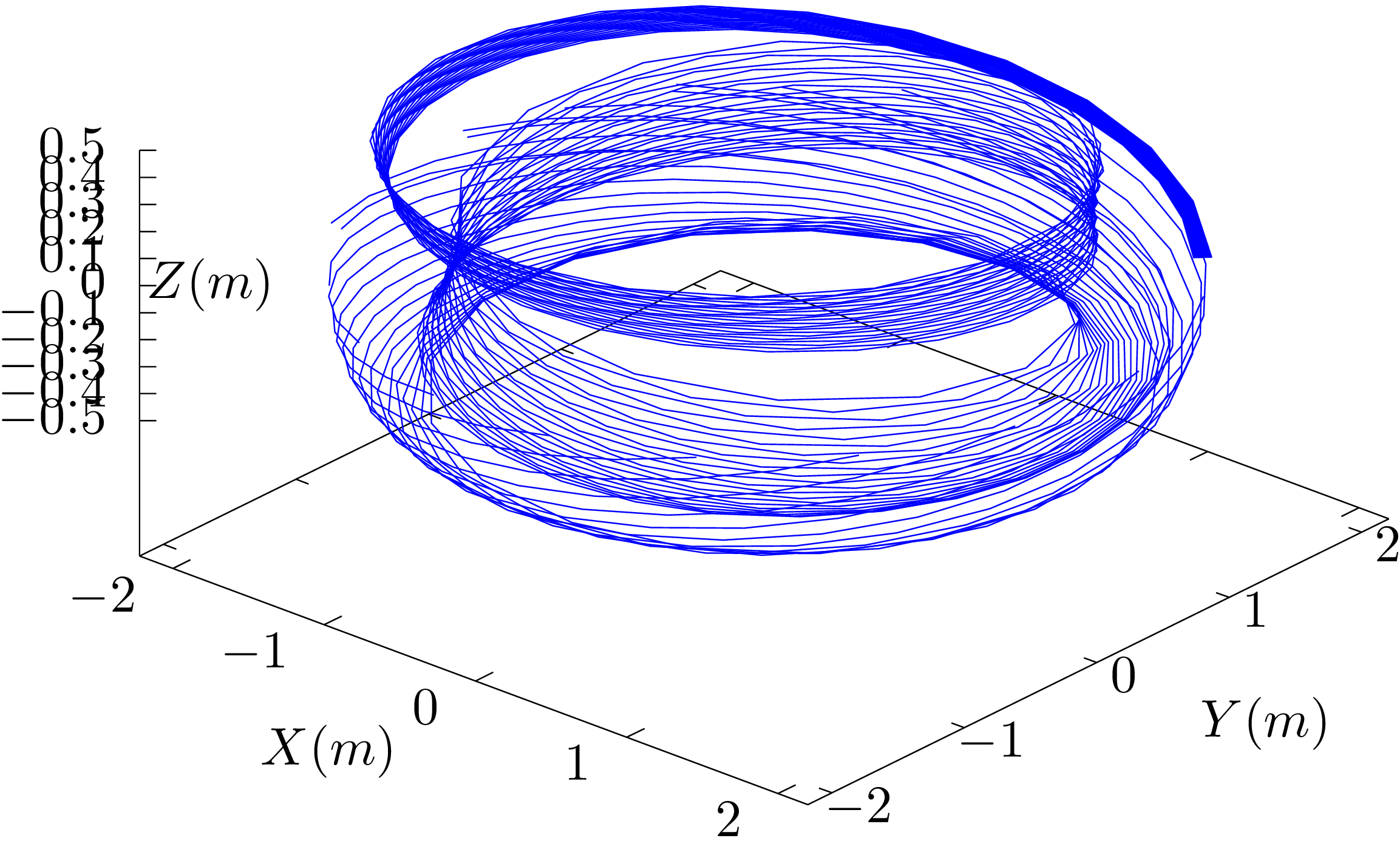 |
Figure 15.11. The same plot as in Fig. 15.10 but with a larger radial range. |
|
|
The above grid is often called “flux-tube”, since it is created by following field lines, and it looks like a tube if the field lines are very near to each other (e.g., when we choose a very narrow radial and toroidal region to start from). Since no magnetic field line passes through the sides of the tube, the flux through any cross section of the tube is equal. The term “flux tube” is often used in astrophysics.
Most gyrokinetic simulation codes use field-line-following coordinates in constructing spatial mesh. The mesh is conceptually generated by the following three steps: (1) selecting some initial points; (2) tracing out magnetic-field-lines passing through these points; (3) choose the intersecting points of these field-lines with a series of chosen surfaces as the final grid-points. The initial points and the chosen surfaces differ among various codes and thus the resulting grid differs. Next, let us discuss some examples.
Given the definition of  coordinates, first
choose
coordinates, first
choose  points at
points at  with
with
 . (The
. (The  plane is chosen to be near the low-field-side midplane.) Then trace out
the magnetic-field-lines passing through these points for one poloidal
circuit (poloidal angle range:
plane is chosen to be near the low-field-side midplane.) Then trace out
the magnetic-field-lines passing through these points for one poloidal
circuit (poloidal angle range:  )
and record the intersection points of these field-lines with various
)
and record the intersection points of these field-lines with various
 planes. This gives a 2D grid [
planes. This gives a 2D grid [ surface for a fixed value of
surface for a fixed value of  ].
After this, we rotate the 2D grid toroidally to get the 3D grid.
Ususally we consider a toroidal wedge rather than a full torus (to
reduce computational cost). So the 2D grid is rotated toroidally by
].
After this, we rotate the 2D grid toroidally to get the 3D grid.
Ususally we consider a toroidal wedge rather than a full torus (to
reduce computational cost). So the 2D grid is rotated toroidally by
 , where
, where  .
.
Note that the gridpoints on  surface usually do
not coincide those on
surface usually do
not coincide those on  surface due to the
toroidal shift along the field line arising when the safety factor is
irrational. Interpolation can be used to map physical variables defined
on gridpoints in
surface due to the
toroidal shift along the field line arising when the safety factor is
irrational. Interpolation can be used to map physical variables defined
on gridpoints in  plane to those in
plane to those in  plane.
plane.
Given the definition of  coordinates, 2D
grid-points can be chosen on
coordinates, 2D
grid-points can be chosen on  plane based on
plane based on  coordinates. Then trace out the magnetic-field-lines
starting from these points for one toroidal circuit and record the
intersection points of these field-lines with
coordinates. Then trace out the magnetic-field-lines
starting from these points for one toroidal circuit and record the
intersection points of these field-lines with  planes, where
planes, where  ,
,  . It is obvious that the resulting mesh are not
toroidally symmetrical. And also the grids on
. It is obvious that the resulting mesh are not
toroidally symmetrical. And also the grids on  plane differ from those on
plane differ from those on  plane. Interpolation
can be used to mapping physical variables defined on grid-points of
plane. Interpolation
can be used to mapping physical variables defined on grid-points of  to those of
to those of  plane. In this
case, the number of “toroidal grid-points”
plane. In this
case, the number of “toroidal grid-points”  (i.e., the number of poloidal planes) is actually the number of
grid-points in the parallel direction within one toroidal circuit.
(i.e., the number of poloidal planes) is actually the number of
grid-points in the parallel direction within one toroidal circuit.
XGC1 can handle the region outside of the LCFS. Here we
only discuss the region inside the LCFS. At each radial gridpoint on
 plane, follow the magnetic field line starting
form this point for one poloidal loop and record the intersection points
of this field-line with
plane, follow the magnetic field line starting
form this point for one poloidal loop and record the intersection points
of this field-line with  planes, where
planes, where  ,
,  .
For the case
.
For the case  , one
magnetic-field-line will have more than one intersection points on some
poloidal planes. Repeat tracing the field line for each radial location.
Then project (toroidally) all the intersection points on different
poloidal planes to a single poloidal plane and rotate (toroidally) these
2D grids to define a 3D grid that are toroidally symmetrical.
, one
magnetic-field-line will have more than one intersection points on some
poloidal planes. Repeat tracing the field line for each radial location.
Then project (toroidally) all the intersection points on different
poloidal planes to a single poloidal plane and rotate (toroidally) these
2D grids to define a 3D grid that are toroidally symmetrical.
The generalized toroidal angle  is numerically
calculated in my code. To verify
is numerically
calculated in my code. To verify  along a
magnetic field-line, figure 15.14 plots the values of
along a
magnetic field-line, figure 15.14 plots the values of  along a magnetic field line, which indicates that
along a magnetic field line, which indicates that
 is constant. This indicates the numerical
implementation of the field-aligned coordinates is correct.
is constant. This indicates the numerical
implementation of the field-aligned coordinates is correct.
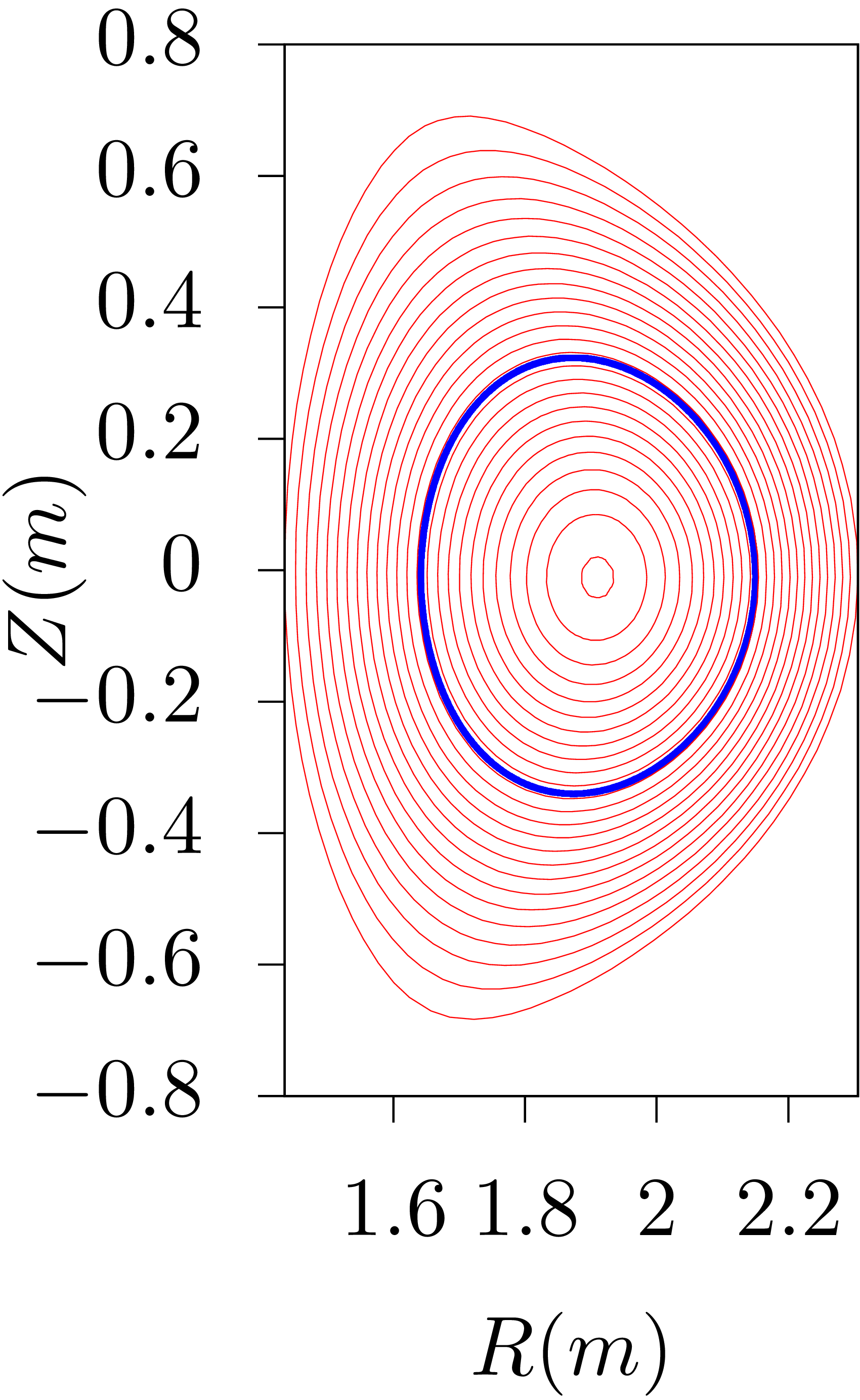 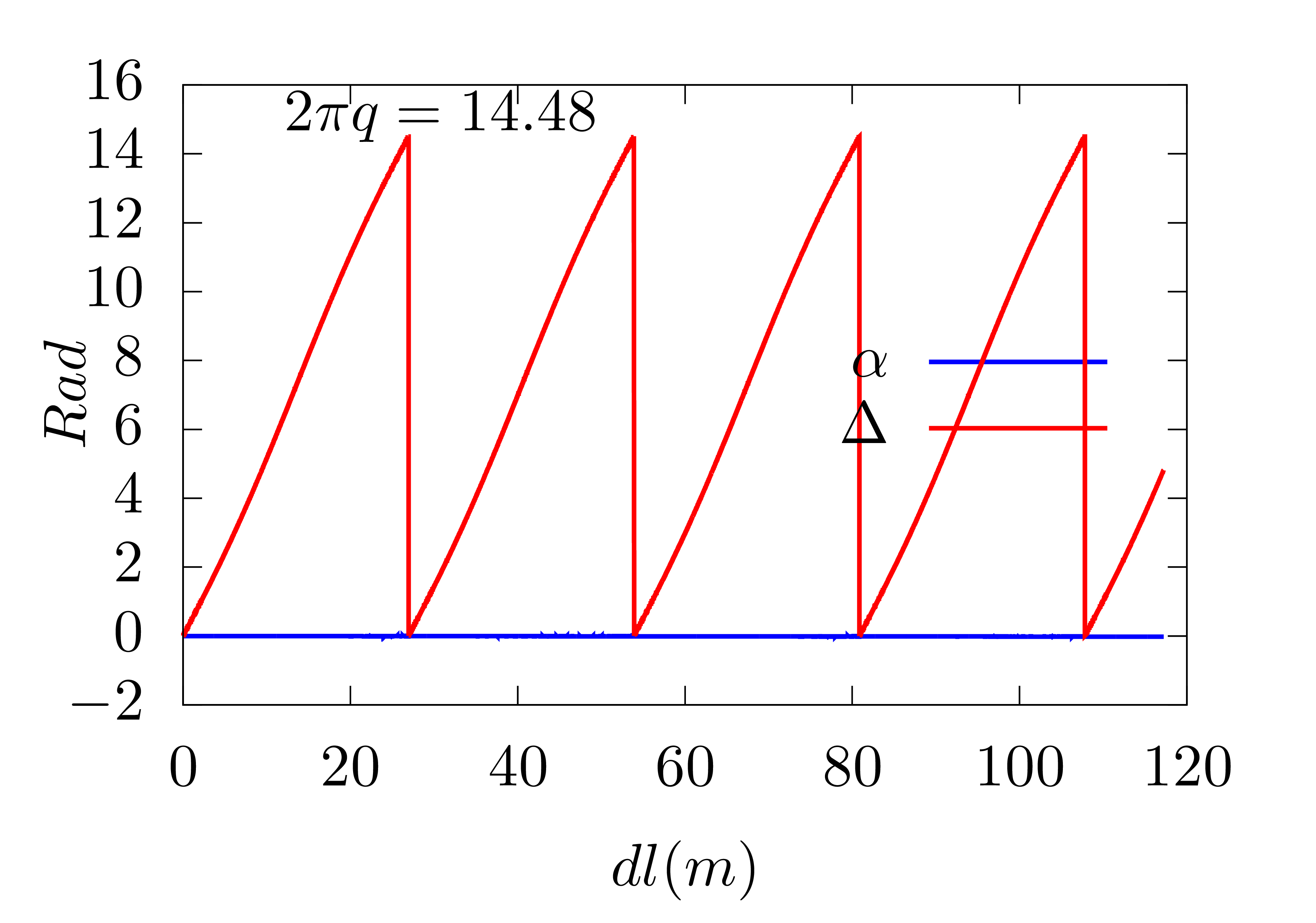 |
Let us introduce the binormal wavenumber, which is frequently used in
presenting turbulence simulation results. Define the binormal direction
 by
by

which is a unit vector lying on a magnetic surface and perpendicular to
 . The binormal wavenumber of
a mode is defined by
. The binormal wavenumber of
a mode is defined by
 |
(15.48) |
where  is the phase of the mode. Consider a mode
given by
is the phase of the mode. Consider a mode
given by  , then the phase
, then the phase
 . Then
. Then  is written as
is written as
 |
 |
 |
|
 |
 |
where the radial phase  does not appear since
does not appear since
 . The above expression can be
further written as
. The above expression can be
further written as
Equation (15.50) is the general expression of the binormal
wavenumber. On the resonant surface of the mode, i.e.,  , then the above expression is written as
, then the above expression is written as
 |
(15.51) |
Using Eq. (14.12), i.e.,  ,
the above expression is written as
,
the above expression is written as

Using  , the above equation is
written
, the above equation is
written
 |
(15.52) |
which indicates the binormal wavenumber generally depends on the
poloidal angle. For large aspect-ratio tokamak, we have  ,
,  .
Then Eq. (15.52) is written
.
Then Eq. (15.52) is written
 |
(15.53) |
which indicates the binormal wavenumber are approximately independent of
the poloidal angle. Since  on a resonant surface,
the above equation is written
on a resonant surface,
the above equation is written  ,
which is the usual poloidal wave number. Due to this relation, the
binormal wavenumber
,
which is the usual poloidal wave number. Due to this relation, the
binormal wavenumber  is often called the poloidal
wavenumber and denoted by
is often called the poloidal
wavenumber and denoted by  in papers on tokamak
turbulence. In the GENE code,
in papers on tokamak
turbulence. In the GENE code,  coordinate is
defined by
coordinate is
defined by  . Then the
. Then the  of a mode of toroidal mode number
of a mode of toroidal mode number  is given by
is given by  where
where  and
and
 . Then
. Then  is written as
is written as  , which is
similar to the binormal defined above. For this reason,
, which is
similar to the binormal defined above. For this reason,  of GENE code is also called binormal wave-vector, which is in fact not
reasonable because neither
of GENE code is also called binormal wave-vector, which is in fact not
reasonable because neither  or
or  is along the binormal direction.
is along the binormal direction.
Assume magnetic surfaces of a magnetic configuration are known and given by
 |
(16.1) |
 |
(16.2) |
where  are two parameters and
are two parameters and  is magnetic surface label (i.e.,
is magnetic surface label (i.e.,  ).
The above parametric equations specify a series of concentric-circular
magnetic surfaces.
).
The above parametric equations specify a series of concentric-circular
magnetic surfaces.
Assume the toroidal field function  is given.
Then the toroidal magnetic field is determined by
is given.
Then the toroidal magnetic field is determined by  . Further assume the safety factor profile
. Further assume the safety factor profile  is given, then the magnetic field is fully determined.
Next, let us derive the explicit form of the poloidal magnetic field
is given, then the magnetic field is fully determined.
Next, let us derive the explicit form of the poloidal magnetic field
 , which is given by
, which is given by
 |
(16.3) |
which involves the poloidal magnetic flux  .
Therefore our task is to express
.
Therefore our task is to express  in terms of
in terms of
 and
and  .
Using
.
Using  , we obtain
, we obtain

Integrate the above equation over  ,
we obtain
,
we obtain
 |
(16.4) |
which an be written as
 |
(16.5) |
where use has been made of  .
Using
.
Using  and
and  ,
the above equation is written
,
the above equation is written
 |
(16.6) |
Using maxima (an open-source computer algebra system), the
above integration over  can be performed
analytically, giving
can be performed
analytically, giving
 |
(16.7) |
Using this, equation (16.6) is written as
 |
(16.8) |
which can be simplified as
 |
(16.9) |
This is what we want—the expression of the poloidal magnetic flux
in terms of  and
and  .
[Another way of obtaining Eq. (16.9) is to use Eq. (8.86), i.e.,
.
[Another way of obtaining Eq. (16.9) is to use Eq. (8.86), i.e.,
 |
(16.10) |
where  is the Jacobian of the
is the Jacobian of the  coordinates and is given by
coordinates and is given by  .
Then Eq. (16.10) is simplified as
.
Then Eq. (16.10) is simplified as
 |
(16.11) |
which, after being integrated over  ,
gives Eq. (16.9).]
,
gives Eq. (16.9).]
Using Eq. (16.9), the poloidal magnetic field in Eq. (16.3) is written as
[Using the formulas  and
and  , where
, where  is the Jacobian of
the
is the Jacobian of
the  coordinates, we obtain
coordinates, we obtain  and
and  ,
,  . Then Eq. (16.12) is written as
. Then Eq. (16.12) is written as
 |
(16.13) |
This is the explicit form of the poloidal magnetic field in terms of
 and
and  .
The magnitude of
.
The magnitude of  is written as
is written as
 |
(16.14) |
Note that both  and
and  depend on the poloidal angle
depend on the poloidal angle  .]
.]
I use Eq. (16.9) to compute the 2D data of  (
( ) on the poloidal plane when
creating a numerical G-eqdsk file for the above magnetic configuration
(Fortran code is at
) on the poloidal plane when
creating a numerical G-eqdsk file for the above magnetic configuration
(Fortran code is at
/home/yj/project_new/circular_configuration_with_q_given).
Assume that the poloidal plasma current is zero, then  is a constant independent of
is a constant independent of  .
This is always assumed by the authors who use concentric-circular
configuration but is seldom explicitly mentioned.
.
This is always assumed by the authors who use concentric-circular
configuration but is seldom explicitly mentioned.
In analytical work,  dependence on
dependence on  is often approximated as
is often approximated as

where  is the local inverse aspect ratio.
is the local inverse aspect ratio.
 divergence-free?
divergence-free?
Since the above field is derived from the general form given by Eq. (1.10), it is guaranteed that the field is divergence-free. In
case of any doubt, let us directly verify this. Write  as
as
 |
(16.15) |
where  is the Jacobian of
is the Jacobian of  coordinates;
coordinates;  ,
,  , and
, and  are given by
are given by
 |
(16.16) |
 |
(16.17) |
 |
(16.18) |
Use  given by (16.12), then
given by (16.12), then  ,
,  ,
and
,
and  are written as
are written as
 |
(16.19) |
 |
(16.20) |
and
 |
(16.21) |
respectively. Then, by using the divergence formula in  coordinates,
coordinates,  is written as
is written as
 |
 |
 |
|
 |
 |
||
 |
 |
||
 |
 |
i.e.,  in this case is indeed divergence-free.
in this case is indeed divergence-free.
 a
solution to the GS equation?
a
solution to the GS equation?
The answer is no. It is ready to verify that the poloidal magnetic flux
function  given by Eq. (16.9) is not
a solution to the GS equation (A.119) even if the plasma
pressure in the GS equation is set to zero. The above expression is a
solution to the GS equation in the limit of infinite aspect ratio and
zero plasma pressure. The finite aspect ratio and plasma pressure
requires the magnetic surfaces to have the Shafranov shift in order to
satisfy the GS equation (see Sec. A.27).
given by Eq. (16.9) is not
a solution to the GS equation (A.119) even if the plasma
pressure in the GS equation is set to zero. The above expression is a
solution to the GS equation in the limit of infinite aspect ratio and
zero plasma pressure. The finite aspect ratio and plasma pressure
requires the magnetic surfaces to have the Shafranov shift in order to
satisfy the GS equation (see Sec. A.27).
For the above magnetic field, the toroidal shift involved in the definition of the generalized toroidal angle can be expressed in simple analytical form. The toroidal shift is given by
 |
(16.23) |
where the local safety factor  can be written as
can be written as
 |
(16.24) |
Using  and
and
 |
(16.25) |
The local safety factor  in Eq. (16.24)
is written as
in Eq. (16.24)
is written as
 |
(16.26) |
Using this, expression (16.23) is written
 |
(16.27) |
Assume  , then the integration
, then the integration
 can be analytically performed (using maxima),
yielding
can be analytically performed (using maxima),
yielding
 |
(16.28) |
Then expression (16.27) is written
 |
(16.29) |
where use has been made of  .
Using this, the generalized toroidal angle can be written as
.
Using this, the generalized toroidal angle can be written as
The results given by the formula (16.29) are compared with the results from my code that assumes a general numerical configuration. The results from the two methods agree with each other, as is shown in Fig. 16.1, which provides confidence in both the analytical formula and the numerical code.
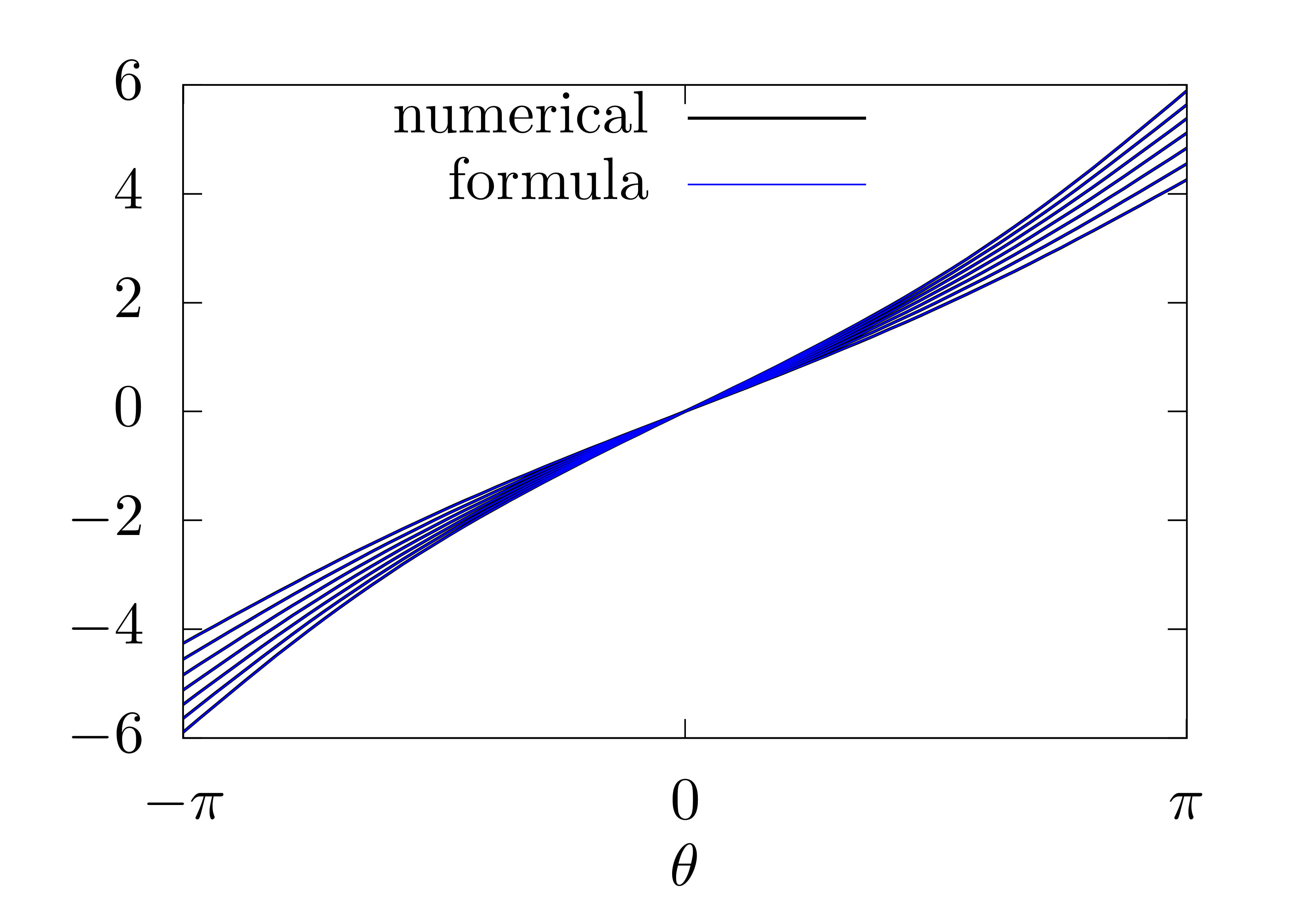 |
Figure 16.1. The results of |
In passing, we note that the straight-field-line poloidal angle  can also be considered to be defined by
can also be considered to be defined by
 |
(16.31) |
i.,e,
 |
(16.32) |
Then using Eq. (16.30),  is written
as
is written
as
 |
(16.33) |
which agrees with Eq. (A2) in Gorler's paper[12].
Let  and define
and define  ,
,
 , etc. Explicit expressions
for these elements can be written as
, etc. Explicit expressions
for these elements can be written as
 |
 |
 |
|
 |
 |
||
 |
 |
||
 |
 |
||
 |
 |







 |
(16.35) |
Using expression (16.29),  can be
evaluated analytically, yielding
can be
evaluated analytically, yielding

where use has been made of

(I did not remember this formula and I use SymPy to obtain this.) These expressions are used to benchmark the numerical code that assume general flux surface shapes. The results show that the code gives correct result when concentric circular flux surfaces are used.
Taking the  derivative of
derivative of  , equation (16.29) is written as (using
Sympy)
, equation (16.29) is written as (using
Sympy)
 |
(16.36) |
where
 |
(16.37) |
Equation (16.26) should be equal to  given by Eq. (16.26). This was verified numerically.
given by Eq. (16.26). This was verified numerically.
Taking the  derivative of Eq. (16.9),
we obtain
derivative of Eq. (16.9),
we obtain
 |
(16.38) |
i.e.,
 |
(16.39) |
 |
(16.40) |
|
The magnetic shear for a concentric-circular configuration is defined by
 |
(16.41) |
where  is the minor radius of a magnetic surface.
The above expression can be re-arranged as
is the minor radius of a magnetic surface.
The above expression can be re-arranged as
 |
(16.42) |
Integrating the above equation over  and assuming
and assuming
 is a constant, we obtain
is a constant, we obtain
 |
(16.43) |
Performing the integration, the above equation is written as
 |
(16.44) |
where  . Equation (16.44)
can be finally written as
. Equation (16.44)
can be finally written as
 |
(16.45) |
This is a profile with a constant magnetic shear  . In Ben's toroidal ITG simulation, the following
. In Ben's toroidal ITG simulation, the following
 profile is used:
profile is used:
 |
(16.46) |
with  . This is a linear
profile over
. This is a linear
profile over  , with the
values of
, with the
values of  and the shear at
and the shear at  being
being  and
and  ,
respectively.
,
respectively.

Prove that
 |
(A.1) |
where  is an arbitary axisymmetric vector.
is an arbitary axisymmetric vector.
Proof: Using the divergence formula in  coordinates, i.e.,
coordinates, i.e.,

where  ,
,  ,
,  .
Then
.
Then  is written as
is written as

where use has been made of that  is a periodic
function of
is a periodic
function of  with period
with period  . Then
. Then  is further written as
is further written as
 |
 |
 |
|
 |
 |
||
 |
 |
||
 |
 |
which proves relation (A.1).
The GS equation is given by Eq. (4.13), i.e.,
 |
(A.3) |
If a solution to the GS equation is obtained, the solution can be scaled
to obtain a family of solutions. Given an equilibrium with  ,
,  ,
,
 , then it is ready to prove
that
, then it is ready to prove
that  ,
,  , and
, and  is also a solution to
the GS equation, where
is also a solution to
the GS equation, where  is a constant. In this
case, both the poloidal and toroidal magnetic fields are increased by a
factor of
is a constant. In this
case, both the poloidal and toroidal magnetic fields are increased by a
factor of  , and thus the
safety factor remains unchanged. Also note that the pressure is
increased by
, and thus the
safety factor remains unchanged. Also note that the pressure is
increased by  factor and thus the value of
factor and thus the value of  (the ratio of the therm pressure to magnetic
pressure) remains unchanged. Note that
(the ratio of the therm pressure to magnetic
pressure) remains unchanged. Note that  ,
which indicates that the direction of the toroidal magnetic field can be
reversed without breaking the force balance. Also note that
,
which indicates that the direction of the toroidal magnetic field can be
reversed without breaking the force balance. Also note that  and
and  can be negative, which
indicates that the direction of the toroidal current can also be
reversed without breaking the force balance.
can be negative, which
indicates that the direction of the toroidal current can also be
reversed without breaking the force balance.
The second kind of scaling is to set  ,
,
 , and
, and  . It is ready to prove that the scaled expression is
still a solution to the GS equation because
. It is ready to prove that the scaled expression is
still a solution to the GS equation because  . This scaling keep the pressure and the poloidal
field unchanged and thus the poloidal beta
. This scaling keep the pressure and the poloidal
field unchanged and thus the poloidal beta  remains unchanged. This scaling scales the toroidal field and thus can
be used to generate a family of equilibria with different profiles of
safety factor.
remains unchanged. This scaling scales the toroidal field and thus can
be used to generate a family of equilibria with different profiles of
safety factor.
Another scaling, which is trivial, is to set  ,
,  , and
, and
 . This scaling can be used to
test the effects of the pressure (not the pressure gradient) on various
physical processes.
. This scaling can be used to
test the effects of the pressure (not the pressure gradient) on various
physical processes.
When a numerical equilibrium is obtained, one can use these scaling methods together to generate new equilibria that satisfy particular global conditions. Note that the shape of magnetic surfaces of the scaled equilibrium remains the same as the original one.
The above scaling is made under the constraint that the the GS equation
(A.3), is satisfied. In practice, we may scale  by a factor while fixing
by a factor while fixing  and
and  . This does not satisfy the GS
equation, but allows more flexibility in changing the the safety factor
profile. Scaling
. This does not satisfy the GS
equation, but allows more flexibility in changing the the safety factor
profile. Scaling  by a factor corresponds to
scaling the plasma current and the poloidal magnetic field.
by a factor corresponds to
scaling the plasma current and the poloidal magnetic field.
For a large aspect-ratio, circular cross section tokamak, the  on a magnetic surface is nearly constant,
on a magnetic surface is nearly constant,  . The poloidal angle dependence of the magnetic
field can be neglected, i.e.,
. The poloidal angle dependence of the magnetic
field can be neglected, i.e.,  ,
and
,
and  , where
, where  is the minor radius of the relavent magnetic surface. Using these, the
safety factor in Eq. (1.34) is approximated to
is the minor radius of the relavent magnetic surface. Using these, the
safety factor in Eq. (1.34) is approximated to
 |
(A.4) |
EAST has 14 superconducting poloidal field (PF) coils and 2 in-vessel copper coils. The layout is shown in Fig. A.1.
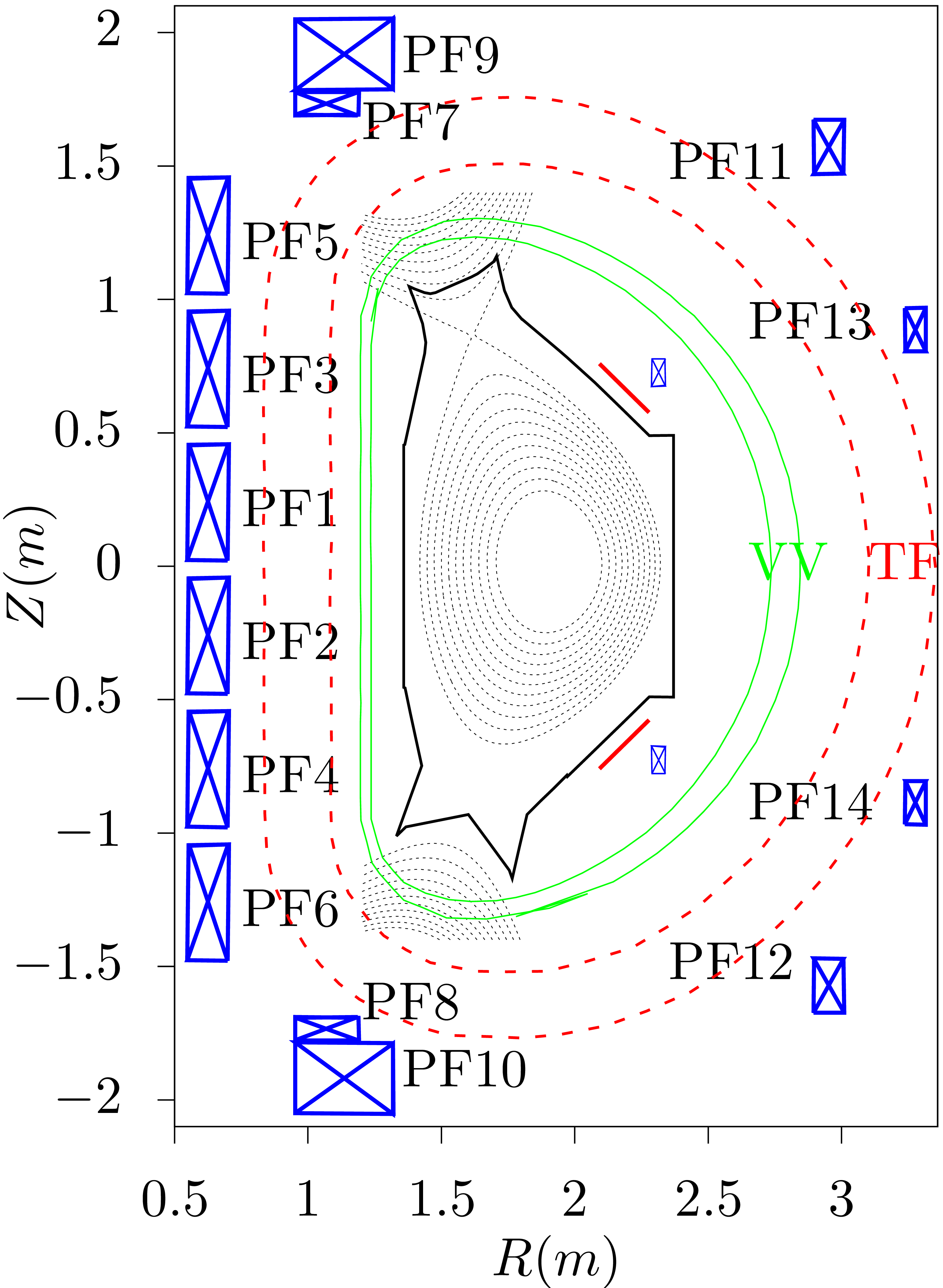 |
Figure A.1. Coils system of EAST tokamak. Coils PF1 to PF6 have 140 turns/coil. Both PF11 and PF12 have 64 turns, Both PF13 and PF14 have 32 turns. PF7 and PF9 are adjacent to each other and are connected in series, and share one power supply. Therefore they are considered as one independent coil, with total turns being 248. The same situation applies for PF8 and PF10. Locations of PF coils are from Refs. [26, 8]. Maximum current per turn in PF coils is 14.5kA. The inner green double D-shaped structures correspond to the vaccum vessel wall, and the outer red dashed D-shape corresponds to the TF-coils. Note that PF1-14 coils are all located outside of the TF-coils. Red coils are RMP copper coils, which generate 3D magnetic perturbations. |
All the PF coils can be considered as shaping coils since they all have effects in shaping the plasmas. In practice, they are further classified according to their main roles. PF1 to PF6 form a solenoid in the center of the torus and thus called Central Solenoide (CS) coils. Their main role is to induce electric field to drive current in the plasma and heat the plasma. As a result, they are often called “Ohm heating coils”.
PF13 and PF14 are mainly used to control (slow) vertical plasma displacement and thus are often called “position control coils”. PF11 and PF12 are used to triangularize the plasma and thus is called “shaping coils”. In order to squeeze the plasma to form desied triangularity, their currents need to be in the opposite direction of plamsa current (since two opposite currents repel each other). PF7+PF9 and PF8+PF10 are often called (by EAST operators) as “big coils” or “divertor coils” since they have the largest number of turns and current and are used to elongate the plasma to diverter configurations.
Besides the 14 superconducting PF coils outside the vaccum vessel, EAST has two small copper coils (2 turn/coil) within the vessel, which share a power supply and are connected in anti-series, and thus have opposite currents. They are closer to the plasma (than other PF coils) and are used to control fast plasma displacements, specifically VDEs (vertical displacement events). They are often called “fast control coils”.
Using Ampere's circuital law
 |
(A.5) |
along the toroidal direction and assuming perfect toroidal symmetry, we obtain
 |
(A.6) |
i.e.,
 |
(A.7) |
Neglecting the poloidal current contributed by the plasma, the poloidal
current is determined solely by the current in the TF coils. The EAST
tokamak has 16 groups of TF coils with 132turns/coil (I got to know the
number of turns from ZhaoLiang Wang:  ).
Denote the current in a single turn by
).
Denote the current in a single turn by  ,
then Eq. (A.7) is written
,
then Eq. (A.7) is written
 |
(A.8) |
Using this formula, the strength of the toroidal magnetic field at  for
for  is calculated to be
is calculated to be  . This was one of the two scenarios
often used in EAST experiments (another scenario is
. This was one of the two scenarios
often used in EAST experiments (another scenario is  ). (The limit of the current in a single turn
of the TF coils is
). (The limit of the current in a single turn
of the TF coils is  (from B. J. Xiao's paper [31]).
(from B. J. Xiao's paper [31]).
Note that the exact equilibrium toroidal magnetic field  is given by
is given by  . Compare this
with Eq. (A.7), we know that the approximation made to
obtain Eq. (A.8) is equivalent to
. Compare this
with Eq. (A.7), we know that the approximation made to
obtain Eq. (A.8) is equivalent to  , i.e. assuming
, i.e. assuming  is a
constant. The poloidal plasma current density
is a
constant. The poloidal plasma current density  is
related to
is
related to  by
by  .
The constant
.
The constant  corresponds to zero plasma poloidal
current, which is consistent to the assumption used to obtain Eq. (A.8).
corresponds to zero plasma poloidal
current, which is consistent to the assumption used to obtain Eq. (A.8).
Let us estimate the safety factor value near the plasma edge using the
total plasma current and the current in a single turn of TF coils  . For divertor magnetic
configuration, the plasma edge is at the saperatrix, where
. For divertor magnetic
configuration, the plasma edge is at the saperatrix, where  . To get a characteristic safety factor value
that is finite, one often chooses the edge to be the magnetic surface
that encloses
. To get a characteristic safety factor value
that is finite, one often chooses the edge to be the magnetic surface
that encloses  of the poloidal magnetic flux.
Denote this surface by
of the poloidal magnetic flux.
Denote this surface by  and the value of
and the value of  at this surface by
at this surface by  ,
which is given by
,
which is given by
 |
(A.9) |
where  is the minor radius of the surface
is the minor radius of the surface  , and
, and  the
major radius of the magnetic axis,
the
major radius of the magnetic axis,  is the the
magnitude of toroidal magnetic field at the magnetic axis, and
is the the
magnitude of toroidal magnetic field at the magnetic axis, and  is the average poloidal magnetic field on the surface,
is the average poloidal magnetic field on the surface,
 . Using Eq. (A.8),
Eq. (A.9) is written as
. Using Eq. (A.8),
Eq. (A.9) is written as
 |
(A.10) |
For EAST, tipically  and
and  . Using this, we obtain
. Using this, we obtain
 |
(A.11) |
The so-called resonant magnetic perturbation (RMP) coils are 3D coils that are used to suppress or mitigate edge localized modes. The shape and location of RMP coils of EAST tokamak are plotted in Fig. A.2.
The size of EAST is similar to that of DIII-D tokamak. The main parameters are summarized in Table. A.1. A significant difference between EAST and DIII-D is that DIII-D has a larger minor radius, which makes DIII-D able to operate with a larger toroidal current than that EAST can do for the same current density. Another significant difference between EAST and DIII-D is that the coils of EAST are supper-conducting while the coils of DIII-D are not. The supper-conducting coils enable EAST to operate at longer pulse.
|
|||||||||||||||||||||||||||||||||||||||||||||||||||||||||||||||||||||||||||||||||||||||||||
Table A.1. Comparison of main
parameters of EAST, DIII-D, JET, and ITER tokamaks. The |
|
||||||||||||||||||||||||||||||||||||||||||||||||||||||||||||
Table A.2. Continued from Table A.1. |
|
||||||||||||||||||||||||||||||||||||||||||||||||||||||||||||
Table A.3. Continued from Table A.2. |
DIII-D has 24 groups of TF coils with 6turns/coil, i.e., total turns are
 , with a maximum current of
, with a maximum current of
 in a single turn[20]. Using formula
(A.7), the toroidal filed at
in a single turn[20]. Using formula
(A.7), the toroidal filed at  can be
calculated, giving
can be
calculated, giving  .
.
DIII-D is special in that its poloidal field (PF) coils are located inside of the TF-coils, which makes the PF-coils more close to the plasma and thus more efficient in shaping the plasma. However, this nested structure is difficult to assemble. In superconducting tokamaks (e.g., EAST, KSTAR, ITER), PF coils are all placed outside of the TF-coils.
I noticed that HL-2M also has the PF coils located within the TF-coils, similar to DIII-D. This remind me that this layout may apply to all non-superconducting tokamaks (to be confirmed, No, non-superconducting tokamak ASDEX-U has PF coils outside of TF coils).
KSTAR has 16 TF coils and 14 PF coils. Both of the TF and PF coil system
use internally cooled superconductors. The nominal current in TF coils
is  with
with  and all coils
connected in series[25]. Using these information and
formula (A.7), the toroidal filed at
and all coils
connected in series[25]. Using these information and
formula (A.7), the toroidal filed at  can be calculated, giving
can be calculated, giving  .
The PF coil system consists of 8 Central Solenoide (CS) coils and 6
outer PF coils and can provide 17 V-sec.
.
The PF coil system consists of 8 Central Solenoide (CS) coils and 6
outer PF coils and can provide 17 V-sec.
ITER has 18 TF coils with number of turns in one coil being 134 and
current per turn  [4].
Using these information and formula (A.7), the toroidal
filed at
[4].
Using these information and formula (A.7), the toroidal
filed at  can be calculated, giving
can be calculated, giving 
According to Refs. [7, 21], Miller's formula for a series of shaped flux surfaces is given by
 |
(A.12) |
 |
(A.13) |
where  and
and  are elongation
and triangularity profile,
are elongation
and triangularity profile,  is the Shafranov
shift profile, which is given by
is the Shafranov
shift profile, which is given by
 |
(A.14) |
where  is a constant,
is a constant,  is
the major radius of the center of the boundary flux surface. The
triangularity profile is
is
the major radius of the center of the boundary flux surface. The
triangularity profile is
 |
(A.15) |
and the elongation profile is
 |
(A.16) |
The nominal ITER parameters are  ,
,
 and
and  .
I wrote a code to plot the shapes of the flux surface
(/home/yj/project/miller_flux_surface). An example of the results is
given in Fig. A.3.
.
I wrote a code to plot the shapes of the flux surface
(/home/yj/project/miller_flux_surface). An example of the results is
given in Fig. A.3.
| <image|/home/yj/project/miller_flux_surface/plt.eps||||> |
An analytic expression for the pressure profile of double (inner and external) transport barriers is given by
 |
(A.17) |
where  is the normalized poloidal flux,
is the normalized poloidal flux,  and
and  are the width of the inner and
external barriers,
are the width of the inner and
external barriers,  and
and  are the locations of the barriers,
are the locations of the barriers,  and
and  is the height of the barriers,
is the height of the barriers,  is
a constant to ensure
is
a constant to ensure  at
at  .
.
 |
Figure A.4. Pressure profile of double (inner
and external) transport barriers given by Eq. (A.17)
with |
 |
To construct a periodic function about  ,
we introduces a function
,
we introduces a function  which is defined over
which is defined over
 and vanishes sufficiently fast as
and vanishes sufficiently fast as  so that the following infinite summation converge:
so that the following infinite summation converge:
 |
(A.18) |
If we use the above sum to define a function
 |
(A.19) |
then it is obvious that
 |
(A.20) |
i.e.,  is a periodic function about
is a periodic function about  with period of
with period of  .
.
If we use the right-hand-side of Eq. (A.19) to represent
 , then we do not need to
worry about the periodic property of
, then we do not need to
worry about the periodic property of  (the
periodic property is guaranteed by the representation)
(the
periodic property is guaranteed by the representation)
Let us introduce parameters characterizing the shape of a magnetic
surface in the poloidal plane. The “midplane” is defined as
the plane that passes through the magnetic axis and is perpendicular to
the symmetric axis ( axis). For a up-down
symmetric (about the midplane) magnetic surface, its shape can be
roughly characterized by four parameters, namely, the
axis). For a up-down
symmetric (about the midplane) magnetic surface, its shape can be
roughly characterized by four parameters, namely, the  coordinate of the innermost and outermost points in the midplane,
coordinate of the innermost and outermost points in the midplane,  and
and  ; the
; the
 coordinators of the highest point of the
magnetic surface,
coordinators of the highest point of the
magnetic surface,  . These
four parameters are indicated in Fig. A.6.
. These
four parameters are indicated in Fig. A.6.
 |
In terms of these four parameters, we can define the major radius of a magnetic surface
 |
(A.21) |
(which is the  coordinate of the geometric center
of the magnetic surface), the minor radius of a magnetic surface
coordinate of the geometric center
of the magnetic surface), the minor radius of a magnetic surface
 |
(A.22) |
the triangularity of a magnetic surface
 |
(A.23) |
and, the ellipticity (elongation) of a magnetic surface
 |
(A.24) |
Usually, we specify the value of  ,
,
 ,
,  , and
, and  ,
instead of
,
instead of  , to characterize
the shape of a magnetic surface. The value of the triangularity
, to characterize
the shape of a magnetic surface. The value of the triangularity  is usually positive in traditional tokamak
operations, but negative triangularity is achievable and potentially
useful, which is under active investigation.
is usually positive in traditional tokamak
operations, but negative triangularity is achievable and potentially
useful, which is under active investigation.
Besides, using  and
and  ,
we can define another useful parameter
,
we can define another useful parameter  ,
which is called the inverse aspect ratio. Note that the major radius
,
which is called the inverse aspect ratio. Note that the major radius
 of the LCFS is usually different from
of the LCFS is usually different from  (the
(the  coordinate of the magnetic
axis). Usually we have
coordinate of the magnetic
axis). Usually we have  due to the so-called
Shafranov shift.
due to the so-called
Shafranov shift.
 is a covariant
component of
is a covariant
component of  in cylindrical coordinates
in cylindrical coordinates
We note that  is the covariant toroidal component
of
is the covariant toroidal component
of  in cylindrical coordinates
in cylindrical coordinates  . The proof is as follows. Note that the
covariant form of
. The proof is as follows. Note that the
covariant form of  should be expressed in terms
of the contravariant basis vector (
should be expressed in terms
of the contravariant basis vector ( ,
,
 , and
, and  ), i.e.,
), i.e.,
 |
(A.25) |
where  is the covariant toroidal component of
is the covariant toroidal component of
 . To obtain
. To obtain  , we take scalar product of Eq. (A.25)
with
, we take scalar product of Eq. (A.25)
with  and use the orthogonality relation (8.7), which gives
and use the orthogonality relation (8.7), which gives
 |
(A.26) |
In cylindrical coordinates  ,
the position vector is written as
,
the position vector is written as
 |
(A.27) |
where  ,
,  , and
, and  are unit vectors
along
are unit vectors
along  ,
,  , and
, and  ,
respectively, i.e.
,
respectively, i.e.
 |
(A.28) |
Using this, we obtain
 |
(A.29) |
Use Eq. (A.29) in Eq. (A.26) giving
 |
(A.30) |
with  defined by
defined by  .
Equation (A.30) indicates that
.
Equation (A.30) indicates that  is
the covariant toroidal component of the vector potential.
is
the covariant toroidal component of the vector potential.
As is discussed in Sec. (), to satisfy the force balance,  must be a magnetic surface function, i.e.,
must be a magnetic surface function, i.e.,  . Using this, expression (3.2) and
(3.3) are written
. Using this, expression (3.2) and
(3.3) are written
 |
(A.31) |
and
 |
(A.32) |
respectively. The above two equations imply that
 |
(A.33) |
which implies that the projections of  lines and
lines and
 lines in the poloidal plane are identical to
each other. This indicates that the
lines in the poloidal plane are identical to
each other. This indicates that the  surfaces
coincide with the magnetic surfaces.
surfaces
coincide with the magnetic surfaces.
The poloidal plasma current density is usually small (compared with the
toroidal plasma current density) but can be important for some cases of
interest and thus could not be safely neglected. Many model equilibria
(e.g., Solovev equilibria, DIII-D cyclone base cases) frequently used in
simulations assume that  is a spatial constant,
i.e., neglecting the poloidal plasmas current. The conclusions drawn
from these simulations could be misleading.
is a spatial constant,
i.e., neglecting the poloidal plasmas current. The conclusions drawn
from these simulations could be misleading.
Using this and  , and
following the same steps in Sec. 1.7, we obtain
, and
following the same steps in Sec. 1.7, we obtain
 |
(A.34) |
where  is the poloidal current enclosed by the
two magnetic surfaces, the positive direction of
is the poloidal current enclosed by the
two magnetic surfaces, the positive direction of  is chosen to be in the clockwise direction when observers look along
is chosen to be in the clockwise direction when observers look along
 . Equation (A.34)
indicates that the difference of
. Equation (A.34)
indicates that the difference of  between two
magnetic surface is proportional to the poloidal current. For this
reason,
between two
magnetic surface is proportional to the poloidal current. For this
reason,  is usually call the “poloidal
current function”.
is usually call the “poloidal
current function”.
In the above, we see that the relation of  with
the poloidal electric current is similar to that of
with
the poloidal electric current is similar to that of  with the poloidal magnetic flux. This similarity is due to that
with the poloidal magnetic flux. This similarity is due to that

is isomorphic to

The poloidal plasma current density  can be
further written as
can be
further written as
Using  , Eq. (A.35)
can also be written as
, Eq. (A.35)
can also be written as
 |
 |
 |
|
 |
 |
For most choices of  and
and  , the GS equation (4.13) has to be
solved numerically. For the specific choice of
, the GS equation (4.13) has to be
solved numerically. For the specific choice of  and
and  profiles given by
profiles given by
 |
(A.37) |
 |
(A.38) |
where  ,
,  , and
, and  are constants,
there is an analytical solution, which is given by[15]
are constants,
there is an analytical solution, which is given by[15]
 |
(A.39) |
where  is an constant. [Proof: By direct
substitution, we can verify
is an constant. [Proof: By direct
substitution, we can verify  of this form is
indeed a solution to the GS equation (4.13).] A useful
choice for tokamak application is to set
of this form is
indeed a solution to the GS equation (4.13).] A useful
choice for tokamak application is to set  ,
,
 , and
, and  . Then Eq. (A.39) is written
. Then Eq. (A.39) is written
 |
(A.40) |
For this case, the toroidal field function  is a
constant. (For the Solovev equilibrium (A.40), I found
numerically that the value of the safety factor at the magnetic axis
(
is a
constant. (For the Solovev equilibrium (A.40), I found
numerically that the value of the safety factor at the magnetic axis
( ) is equal to
) is equal to  . This result should be able to be proved
analytically. I will do this later. In calculating the safety factor, we
also need the expression of
. This result should be able to be proved
analytically. I will do this later. In calculating the safety factor, we
also need the expression of  ,
which is given analytically by
,
which is given analytically by
 |
 |
 |
|
 |
 |
)
Define  , and
, and  , then Eq. (A.40) is written as
, then Eq. (A.40) is written as
where  ,
,  . From Eq. (A.42), we obtain
. From Eq. (A.42), we obtain
 |
(A.43) |
Given the value of  ,
,  , for each value of
, for each value of  , we can plot a magnetic surface on
, we can plot a magnetic surface on  plane. An example of the nested magnetic surfaces is shown
in Fig. A.7.
plane. An example of the nested magnetic surfaces is shown
in Fig. A.7.
 |
Figure A.7. Flux surfaces of
Solovév equilibrium for |
Equation (A.40) can be solved to give explicit form of the
contour of  in
in  plane:
plane:
 |
(A.44) |
The minor radius of a magnetic surface of the Solovev equilibrium can be calculated by using Eq. (A.44), which gives
 |
(A.45) |
 |
(A.46) |
and thus
 |
(A.47) |
where  . In my code of
constructing Solovev magnetic surface, the value of
. In my code of
constructing Solovev magnetic surface, the value of  is specified by users, and then Eq. (A.47) is solved
numerically to obtain the value of
is specified by users, and then Eq. (A.47) is solved
numerically to obtain the value of  of the flux
surface. Note that the case
of the flux
surface. Note that the case  corresponds to
corresponds to  , i.e., the magnetic axis, while
the case
, i.e., the magnetic axis, while
the case  corresponds to
corresponds to  . Therefore, the reasonable value of
. Therefore, the reasonable value of  of a magnetic surface should be in the range
of a magnetic surface should be in the range  . This range is used as the interval bracketing
a root in the bisection root finder.
. This range is used as the interval bracketing
a root in the bisection root finder.
Using Eq. (A.47), the inverse aspect ratio of a magnetic
surface labeled by  can be approximated as[15]
can be approximated as[15]
 |
(A.48) |
Therefore, the value of  of a magnetic surface
with the inverse aspect ratio
of a magnetic surface
with the inverse aspect ratio  is approximately
given by
is approximately
given by
 |
(A.49) |
In deriving the Grad-Shafranov equation, we have assumed that there is no plasma flow. Next, let us examine whether this assumption is justified for plasmas in EAST tokamak.
The complete momentum equation is given by
 |
(A.50) |
where  term can be usually neglected due to
either
term can be usually neglected due to
either  or
or  ,
,
 is a pressure tensor, which is different from
the scalar pressure considered in this note. The equilibrium with
pressure tensor can be important for neutral beam heating plasma, where
pressure contributed by NBI fast ions can be a tensor. With plasma flow
and scalar pressure and neglecting electric force term, the steady state
momentum equation is written
is a pressure tensor, which is different from
the scalar pressure considered in this note. The equilibrium with
pressure tensor can be important for neutral beam heating plasma, where
pressure contributed by NBI fast ions can be a tensor. With plasma flow
and scalar pressure and neglecting electric force term, the steady state
momentum equation is written
 |
(A.51) |
where the term on the left-hand side is the contribution of plasma flow to the force balance. Let us estimate the magnitude of this term. Macroscopic flows in tokamak are usually along the toroidal direction (the poloidal flow is usually heavily damped). The toroidal flow usually has the same toroidal angular frequency on a magnetic surface, i.e., the flow can be written as
 |
(A.52) |
where  is the toroidal angular frequency of the
flow, which can have radial variation. Using this expression, the
left-hand side of Eq. (A.51) is written as
is the toroidal angular frequency of the
flow, which can have radial variation. Using this expression, the
left-hand side of Eq. (A.51) is written as
 |
 |
 |
|
 |
 |
||
 |
 |
which is just the centripetal force. For typical EAST plasma, the
rotation frequency  is less than
is less than  . For
. For  ,
,
 and
and  [Mass density of
EAST#38300@3.9s,
[Mass density of
EAST#38300@3.9s,  ], the above
fore is about
], the above
fore is about  newton. On the other hand, the
pressure gradient force in Eq. (A.51) is about
newton. On the other hand, the
pressure gradient force in Eq. (A.51) is about  newton, which is one order larger than the force
contributed by the rotation. [Pressure gradient force is estimated by
using
newton, which is one order larger than the force
contributed by the rotation. [Pressure gradient force is estimated by
using  , where
, where  is the thermal pressure at the magnetic axis and
is the thermal pressure at the magnetic axis and  is the minor radius of plasma. For typical EAST plasmas
(EAST#38300@3.9s),
is the minor radius of plasma. For typical EAST plasmas
(EAST#38300@3.9s),  ,
,  . Then
. Then  .] This indicates the rotation has little influence
on the force balance. In other words, the EAST tokamak equilibrium can
be well described by the static equilibrium without rotation.
.] This indicates the rotation has little influence
on the force balance. In other words, the EAST tokamak equilibrium can
be well described by the static equilibrium without rotation.
Plasma  is is the ratio of thermal pressure to
magnetic pressure, i.e.,
is is the ratio of thermal pressure to
magnetic pressure, i.e.,
 |
(A.54) |
Since pressure in tokamak plasmas is not uniform, volume averaged
pressure is used to define the beta. The toroidal beta  and the poloidal beta
and the poloidal beta  are defined, respectively,
by
are defined, respectively,
by
 |
(A.55) |
 |
(A.56) |
where  is the volume average,
is the volume average,  is the vacuum toroidal magnetic field at the magnetic axis (or
geometrical center of the plasma),
is the vacuum toroidal magnetic field at the magnetic axis (or
geometrical center of the plasma),  is the flux
surface averaged poloidal magnetic fied,
is the flux
surface averaged poloidal magnetic fied,  is the
length of the poloidal perimeter of the boundary flux surface. Then
is the
length of the poloidal perimeter of the boundary flux surface. Then  can be written as
can be written as
 |
(A.57) |
An alternative defintion of  use the LCFS
cross-sectional average of
use the LCFS
cross-sectional average of  rather than the
volume average
rather than the
volume average  (Wesson tokamaks). This
definition is adopted in many codes, including HEQ code I developed
(Wesson tokamaks). This
definition is adopted in many codes, including HEQ code I developed
Beta can be considered as a quantity characterizing the efficiency of the magnetic field of tokamaks in confining plasmas.
In tokamaks, the toroidal magnetic field is dominant and thus the the
toroidal beta  (not
(not  )
is the usual way to characterize the the efficiency of the magnetic
field in confining plasmas. (Why do we need
)
is the usual way to characterize the the efficiency of the magnetic
field in confining plasmas. (Why do we need  ? The short answer is that
? The short answer is that  is proportional to an important current, the bootstrap current, which is
important for tokamak steady state operation.)
is proportional to an important current, the bootstrap current, which is
important for tokamak steady state operation.)
Tokamak experiments have found that it is easier to achieve higher  in low
in low  plasmas than in higher
plasmas than in higher
 plasmas, which indicates that the efficiency of
the magnetic field in confining plasma is a decreasing function of the
magnitude of the magnetic field.
plasmas, which indicates that the efficiency of
the magnetic field in confining plasma is a decreasing function of the
magnitude of the magnetic field.
Beta limit means there is a limit for the value of beta beyond which the
plasma will encounter a serious disruption. Early calculation of the
beta limit on JET shows that the maximal  obtained is proportional to
obtained is proportional to  ,
where all quantities are in SI units. This scaling relation
,
where all quantities are in SI units. This scaling relation  is often called Troyon scaling, where the coefficient
is often called Troyon scaling, where the coefficient  was determined numerically by Troyon to 0.028. Often
was determined numerically by Troyon to 0.028. Often
 is expressed in percent, in which case
is expressed in percent, in which case  . This motivates us to define
. This motivates us to define
 |
(A.58) |
which is called “normalized beta”. The normalized beta  is an operational parameter indicating how close the
plasma is to reach destabilizing major MHD activities. Its typical value
is of order unit. As mentioned above,
is an operational parameter indicating how close the
plasma is to reach destabilizing major MHD activities. Its typical value
is of order unit. As mentioned above,  calculated
by Troyon is
calculated
by Troyon is  . Empirical
evaluation from the data of different tokamaks raises this value
slightly to 3.5, although significantly higher values, e.g.,
. Empirical
evaluation from the data of different tokamaks raises this value
slightly to 3.5, although significantly higher values, e.g.,  , have been achieved in the low
aspect ratio tokamak NSTX[24].
, have been achieved in the low
aspect ratio tokamak NSTX[24].
The value of  indicates how close one is to the
onset of deleterious instability . The ability to increase the value of
indicates how close one is to the
onset of deleterious instability . The ability to increase the value of
 can be considered as the ability of controlling
the major MHD instabilities, and thus can be used to characterize how
well a tokamak device is operated. One goal of EAST tokamak during
2015-2016 is to sustain a plasma with
can be considered as the ability of controlling
the major MHD instabilities, and thus can be used to characterize how
well a tokamak device is operated. One goal of EAST tokamak during
2015-2016 is to sustain a plasma with  for at
least 10 seconds.
for at
least 10 seconds.
(check** The tearing mode, specifically the neoclassical tearing mode (NTM) is expected to set the beta limit in a reactor.)
(**check: Tokamak experiments have found that it is easier to achieve
high  in large
in large  plasmas
than in small
plasmas
than in small  plasmas. However, experiments
found it is easier to achieve high
plasmas. However, experiments
found it is easier to achieve high  in small
in small  plasmas than in large
plasmas than in large  plasmas. Examining the expression of
plasmas. Examining the expression of  and
and  given by Eqs. (A.57) and Eq. (),
respectively, we recognize that pressure limit should have a scaling of
given by Eqs. (A.57) and Eq. (),
respectively, we recognize that pressure limit should have a scaling of
 with
with  .
)
.
)
 is the ratio of the pressure to the squre of
plasma current, and thus characterizes the efficiency of the plasma
current in confining the plasma. Is there a limit for
is the ratio of the pressure to the squre of
plasma current, and thus characterizes the efficiency of the plasma
current in confining the plasma. Is there a limit for  ?
?
As is mentioned in Sec. A.14, the beta limit study on JET
tokamak shows that the maximal  obtained is
proportional to
obtained is
proportional to  . This means
the maximal plasmas pressure obtained is proportional to
. This means
the maximal plasmas pressure obtained is proportional to  , i.e.,
, i.e.,
 |
(A.59) |
The total plasma energy is given by  ,
where
,
where  is the major radius of the device. Using
Eq. (A.59), we obtain
is the major radius of the device. Using
Eq. (A.59), we obtain
 |
(A.60) |
Since fusion power is proportional to the plasma energy, the above relation indicates, to obtain larger fusion power, we need bigger tokamaks with larger plasma current.
The reason why larger plasma current is desired can also be appreciated
by examining an empirical scaling of the the energy confinement time
 given by
given by
 |
(A.61) |
which is proportional to  .
.
Another fundamental reason for building larger tokamaks is that the
energy confinement time  increases with the
machine size, where
increases with the
machine size, where  is the heat diffusitivity.
In addition, the heat diffusitivity
is the heat diffusitivity.
In addition, the heat diffusitivity  decreases
with increasing machine size if the diffusitivity satisfies the
gyro-Bohm scaling, which is given by
decreases
with increasing machine size if the diffusitivity satisfies the
gyro-Bohm scaling, which is given by
 |
(A.62) |
which is inverse proportional to the machine size  . However, if the diffusitivity satisfies the Bohm
scaling, which is given by
. However, if the diffusitivity satisfies the Bohm
scaling, which is given by
 |
(A.63) |
then, the diffusitivity is independent of the machine size. The Bohm
diffusitivity  is
is  times
larger than the gyro-Bohm diffusitivity
times
larger than the gyro-Bohm diffusitivity  ,
where
,
where  is the gyro-radius. Heat diffusitivity
scaling in the low confinement operation (
is the gyro-radius. Heat diffusitivity
scaling in the low confinement operation ( mode)
in present-day tokamaks is observed to be Bohm or worse than Bohm.
mode)
in present-day tokamaks is observed to be Bohm or worse than Bohm.
The maximum density that can be obtained in stable plasma operations (without disruption) is empirically given by
 |
(A.64) |
where  is the Greenwalt density, which is given
by
is the Greenwalt density, which is given
by
 |
(A.65) |
where  is the plasma current,
is the plasma current,  is the minor radius, all physical quantities are in SI units. The
is the minor radius, all physical quantities are in SI units. The  gives the density limit that can be achieved for a
tokamak operation scenario with plasma current
gives the density limit that can be achieved for a
tokamak operation scenario with plasma current  and plasma minor radius
and plasma minor radius  . The
Greenwalt density limit is an empirical one, which, like other empirical
limits, can be exceeded in practice. Equation (A.65)
indicates that the Greenwalt density is proportional to the current
density. Therefore the ability to operate in large plasma current
density means the ability to operate with high plasma density.
. The
Greenwalt density limit is an empirical one, which, like other empirical
limits, can be exceeded in practice. Equation (A.65)
indicates that the Greenwalt density is proportional to the current
density. Therefore the ability to operate in large plasma current
density means the ability to operate with high plasma density.
Note that neither the pressure limit nor the density limit is determined by the force-balance constraints. They are determined by the stability of the equilibrium. On the other hand, since the stability of the equilibrium is determined by the equilibrium itself, the pressure and density limit is determined by the equilibrium.
The self-inductance of a current loop is defined as the ratio of the
magnetic flux  traversing the loop and its
current
traversing the loop and its
current  :
:
 |
(A.66) |
where
 |
(A.67) |
and  is generated by the current
is generated by the current  . It can be proved that
. It can be proved that  is independent of the current
is independent of the current  in the loop, i.e.,
in the loop, i.e.,
 is fully determined by the shape of the loop.
is fully determined by the shape of the loop.
On the other hand, the energy contained in the magnetic field produced by the loop current is given by
 |
(A.68) |
where the volume includes all space where  is not
negligible. It can be proved that
is not
negligible. It can be proved that  ,
,
 , and
, and  are related to each other by:
are related to each other by:
 |
(A.69) |
i.e.,
 |
(A.70) |
which can be considered an equivalent definition of the self-inductance.
The internal inductance  of tokamak plasma is
defined in such a way that
of tokamak plasma is
defined in such a way that  only includes the
poloidal magnetic energy within the plasma. Specifically,
only includes the
poloidal magnetic energy within the plasma. Specifically,  is defined by
is defined by
 |
(A.71) |
where only energy of the poloidal magnetic field in included, and the
integration over the plasma volume  .
Its complement is the external inductance (
.
Its complement is the external inductance ( ).
).
The normalized internal inductance  is defined as
is defined as
 |
(A.72) |
where  is the surface averaged major radius.
Using Eq. (A.71), expression (A.72) is written
as
is the surface averaged major radius.
Using Eq. (A.71), expression (A.72) is written
as
 |
(A.73) |
which is the definition of  used in the ITER
design. Using the defintion of
used in the ITER
design. Using the defintion of  ,
i.e.,
,
i.e.,
 |
(A.74) |
where  is the cross section of boundary flux
surface, expression (A.73) is written as
is the cross section of boundary flux
surface, expression (A.73) is written as
 |
(A.75) |
Another definition of  is
is
 |
(A.76) |
where  is the surface average over the plasma
boundary. Using Ampere's law, we obtain
is the surface average over the plasma
boundary. Using Ampere's law, we obtain
 |
(A.77) |
Using this Eq. (A.76) is written as
 |
(A.78) |
For circular cross section,  .
Then the above expression is written as
.
Then the above expression is written as

which agrees with Eq. (A.75).
The normalized internal inductance reflects the peakness of the current
density profile (I have not verified this): smaller value of  corresponds to broader current profile.
corresponds to broader current profile.
Since  , the current density
, the current density
 can be inferred from a given magnetic field. The
components of
can be inferred from a given magnetic field. The
components of  (expressed in terms of
(expressed in terms of  and
and  ) are given
by Eqs. (3.2), (3.3) and (3.6).
These expressions can be further simplified by using the equilibrium
constraints, such as
) are given
by Eqs. (3.2), (3.3) and (3.6).
These expressions can be further simplified by using the equilibrium
constraints, such as  and
and  . The simplified
. The simplified  expressions
are given in A.20.
expressions
are given in A.20.
On the other hand, in the kinetic equilibrium reconstruction[19], it is the current that is first (partially) specified (e.g., by summing sources of current drive and bootstrap current) and then the current is used as constraints for the GS equation, i.e, constraints for the magnetic field.
Due to the force balance condition, the plasma current is related to the plasma pressure gradient:
The parallel (to the magnetic field) current density is written as
 |
 |
 |
|
 |
 |
||
 |
 |
||
 |
 |
||
 |
 |
||
 |
 |
For later use, define
Equation (A.81) is used in GTAW code to calculate  (actually calculated is
(actually calculated is  )[14]. Note that the expression for
)[14]. Note that the expression for  in
Eq. (A.81) is not a magnetic surface function. Define
in
Eq. (A.81) is not a magnetic surface function. Define  as
as
 |
 |
 |
|
 |
 |
||
 |
 |
where  is called Pfirsch-Schluter (PS) current.
In cylindrical geometry, due to the poloidal symmetry, the
Pfiersch-Schluter current is zero. In toroidal geometry, due to the
poloidal asymmetry, the PS current is generally nonzero. Thus, this
quantity characterizes a toroidal effect.
is called Pfirsch-Schluter (PS) current.
In cylindrical geometry, due to the poloidal symmetry, the
Pfiersch-Schluter current is zero. In toroidal geometry, due to the
poloidal asymmetry, the PS current is generally nonzero. Thus, this
quantity characterizes a toroidal effect.
Another useful quantity is  ,
which is written as
,
which is written as
 |
where  is flux surface averaging operator.
is flux surface averaging operator.
In the vacuum region that is between the plasma and the first wall, there is no current, i.e.,
 |
(A.85) |
Next, let us examine what constraint this condition imposes on the magnetic field. Using expression (1.10), the above equation is written as
 |
(A.86) |
It is not obvious how to draw useful information from the above equation.
In the above, we use the vector potential approach. Next, let us try the scalar potential approach:
 |
(A.87) |
then the constraint  is written as
is written as
 |
(A.88) |
[check***As discussed in Sec. (), the force balance equation of
axisymmetric plasma requires that  .
From this and the fact
.
From this and the fact  , we
conclude that
, we
conclude that  is a function of
is a function of  , i.e.,
, i.e.,  .
However, this reasoning is not rigorous. Note the concept of a function
requires that a function can not be a one-to-more map. This means that
.
However, this reasoning is not rigorous. Note the concept of a function
requires that a function can not be a one-to-more map. This means that
 indicates that the values of
indicates that the values of  must be equal on two different magnetic field lines that have the same
value of
must be equal on two different magnetic field lines that have the same
value of  . However, the two
equations
. However, the two
equations  and
and  do not
require this constraint. To examine whether this constraint removes some
equilibria from all the possible ones, we consider a system with an
do not
require this constraint. To examine whether this constraint removes some
equilibria from all the possible ones, we consider a system with an  point. Inside one of the magnetic islands, we use
point. Inside one of the magnetic islands, we use
 |
(A.89) |
and inside the another, we use
 |
(A.90) |
Then solve the two GS equations respectively within the boundary of the
two islands. It is easy to obtain two magnetic surfaces that have the
same value of  respectively inside the two
islands. Equations (A.89) and (A.90) indicate
that the values of
respectively inside the two
islands. Equations (A.89) and (A.90) indicate
that the values of  on the two magnetic surfaces
are different from each other. It is obvious the resulting equilibrium
that contain the two islands can not be recovered by directly solving a
single GS equation with a given function
on the two magnetic surfaces
are different from each other. It is obvious the resulting equilibrium
that contain the two islands can not be recovered by directly solving a
single GS equation with a given function  .**check]
.**check]
On both an irrational surface and a rational surface, there are infinite number of magnetic field lines that are not connected with each other. It is wrong to say there is only one magnetic field line on a irrational surface.
Consider a perturbation  that satisfies
that satisfies  , i.e., the value
, i.e., the value  is a constant along any one of the magnetic field lines (field-aligned
structure). Now comes the question: whether the values of
is a constant along any one of the magnetic field lines (field-aligned
structure). Now comes the question: whether the values of  on different field lines are equal to each other?
on different field lines are equal to each other?
To answer this question, we choose a direction that is different from
 on the magnetic surface and examine whether
on the magnetic surface and examine whether  is constant along this direction, i.e, whether
is constant along this direction, i.e, whether  equals zero, where
equals zero, where  is the
chosen direction. For axsiymmetric magnetic surfaces, then
is the
chosen direction. For axsiymmetric magnetic surfaces, then  is a direction in the magnetic surface and it is usually
not identical with
is a direction in the magnetic surface and it is usually
not identical with  . Then we
obtain
. Then we
obtain
 |
(A.91) |
If  is non-axisymmetric, then Eq. (A.91)
indicates that
is non-axisymmetric, then Eq. (A.91)
indicates that  , i.e., the
values of
, i.e., the
values of  on different magnetic field lines on
the same magnetic surface are not equal to each other. This is the case
for the
on different magnetic field lines on
the same magnetic surface are not equal to each other. This is the case
for the  coordinates discussed in Sec. 15.1.
coordinates discussed in Sec. 15.1.
Realistic perturbations in tokamak plasmas only have approximate
field-aligned structure, i.e.,  .
Put it in other words,
.
Put it in other words,  .
.
This reasoning is for the case of axsiymmetric magnetic surfaces. It is
ready to do the same reasoning for non-axisymmetrica magnetic surface
after we find a convenient direction  on the
magnetic surface.
on the
magnetic surface.
(In practice, I choose the positive direction of  and
and  along the direction of toroidal and poloidal
magnetic field (i.e.,
along the direction of toroidal and poloidal
magnetic field (i.e.,  and
and  are always positive in
are always positive in  coordinates system).
Then, the
coordinates system).
Then, the  defined by Eq. (8.81) is
always positive. It follows that
defined by Eq. (8.81) is
always positive. It follows that  should be also
positive. Next, let us examine whether this property is correctly
preserved by Eq. (8.87). Case 1: The radial coordinate
should be also
positive. Next, let us examine whether this property is correctly
preserved by Eq. (8.87). Case 1: The radial coordinate  is chosen as
is chosen as  .
Then the factor before the integration in Eq. (8.87) is
negative. We can further verify that
.
Then the factor before the integration in Eq. (8.87) is
negative. We can further verify that  is always
negative for either the case that
is always
negative for either the case that  is pointing
inward or outward. Therefore the .r.h.s. of Eq. (8.87) is
always positive for this case. Case 2: The radial coordinate
is pointing
inward or outward. Therefore the .r.h.s. of Eq. (8.87) is
always positive for this case. Case 2: The radial coordinate  is chosen as
is chosen as  .
Then the factor before the integration in Eq. (8.87) is
positive. We can further verify that
.
Then the factor before the integration in Eq. (8.87) is
positive. We can further verify that  is always
positive for either the case that
is always
positive for either the case that  is pointing
inward or outward. The above two cases include all possibilities.
Therefore, the positivity of
is pointing
inward or outward. The above two cases include all possibilities.
Therefore, the positivity of  is always
guaranteed)
is always
guaranteed)
We know that the toroidal flux  ,
safety factor
,
safety factor  , and the
, and the  in the GS equation are related by the following
equations:
in the GS equation are related by the following
equations:
 |
(A.92) |
 |
(A.93) |
Define:
 |
(A.94) |
(In the Toray_ga code, the radial coordinate  is
defined as
is
defined as
 |
(A.95) |
where  is a constant factor.
is a constant factor. defined this way is of length dimension, which is an effective geometry
radius obtained by approximating the flux surface as circular.)
defined this way is of length dimension, which is an effective geometry
radius obtained by approximating the flux surface as circular.)
I use Eq. (A.94) to define  .
Then we have
.
Then we have
 |
(A.96) |
 |
(A.97) |
 |
(A.98) |
 |
(A.99) |
 |
(A.100) |
Eq. (A.100) is used to transform between  and
and  .
.


If  are magnetic surface coordinates, i.e.,
are magnetic surface coordinates, i.e.,  , then the toroidal elliptic
operator in Eq. (13.3) is reduced to
, then the toroidal elliptic
operator in Eq. (13.3) is reduced to
 |
(A.101) |
and the GS equation, Eq. (13.5), is reduced to
 |
(A.102) |
 coordinates
coordinates coordinates
coordinates
Define  coordinates by
coordinates by
 |
(A.103) |
 |
(A.104) |
where  are the cylindrical coordinates and
are the cylindrical coordinates and  is a constant. The above transformation is shown
graphically in Fig. A.9.
is a constant. The above transformation is shown
graphically in Fig. A.9.
The Jacobian of  coordinates can be calculated
using the definition. Using
coordinates can be calculated
using the definition. Using  ,
,
 , and
, and  , the Jacobian (with respect to the Cartesian
coordinates
, the Jacobian (with respect to the Cartesian
coordinates  ) is written as
) is written as
 |
 |
 |
|
 |
 |
||
 |
 |
||
 |
 |
||
 |
 |
||
 |
 |
 in
in  coordinate system
coordinate system
Next, we transform the GS equation from  coordinates to
coordinates to  coordinates. Using the relations
coordinates. Using the relations
 and
and  ,
we have
,
we have
 |
(A.106) |
 |
(A.107) |
 |
(A.108) |
 |
(A.109) |
The GS equation in  coordinates is given by
coordinates is given by
 |
(A.110) |
The term  is written as
is written as
Using Eq. (A.111),  is written as
is written as
 |
(A.113) |


 |
(A.114) |

 |
(A.115) |
Summing the the right-hand-side of Eq. (A.112) and the expression on line (A.116) yields
 |
(A.118) |
Using these, the GS equation is written as

which can be arranged in the form
 |
(A.119) |
which agrees with Eq. (3.6.2) in Wessson's book[29], where
 is defined by
is defined by  ,
which is different from
,
which is different from  by a
by a  factor.
factor.
Consider the case that the boundary flux surface is circular with radius
 and the center of the cirle at
and the center of the cirle at  . Consider the case
. Consider the case  . Expanding
. Expanding  in the small
parameter
in the small
parameter  ,
,
 |
(A.120) |
where  ,
,  . Substituting Eq. (A.120) into
Eq. (A.119), we obtain
. Substituting Eq. (A.120) into
Eq. (A.119), we obtain

Multiplying the above equation by  ,
we obtain
,
we obtain
 |
(A.121) |
Further assume the following orderings (why?)
 |
(A.122) |
and
 |
(A.123) |
Using these orderings, the order of the terms in Eq. (A.121) can be estimated as
 |
(A.124) |
 |
(A.125) |
 |
(A.126) |
 |
(A.127) |
 |
(A.128) |
 |
(A.129) |
 |
(A.130) |
 |
(A.131) |
 |
(A.132) |
The leading order ( order) balance is given by
the following equation:
order) balance is given by
the following equation:
 |
(A.133) |
It is reasonable to assume that  is independent
of
is independent
of  since
since  corresponds to
the limit
corresponds to
the limit  . (The limit
. (The limit  can have two cases, one is
can have two cases, one is  , another is
, another is  .
In the former case,
.
In the former case,  must be independent of
must be independent of  since
since  should be
single-valued. The latter case corresponds to a cylinder, for which it
is reasonable (really?) to assume that
should be
single-valued. The latter case corresponds to a cylinder, for which it
is reasonable (really?) to assume that  is
independent of
is
independent of  .) Then Eq.
(A.133) is written
.) Then Eq.
(A.133) is written
 |
(A.134) |
(My remarks: The leading order equation (A.134) does not
corresponds strictly to a cylinder equilibrium because the magnetic
field  depends on
depends on  .)
The next order (
.)
The next order ( order) equation is
order) equation is

 |
(A.135) |
 |
(A.136) |
It is obvious that the simple poloidal dependence of  will satisfy the above equation. Therefore, we consider
will satisfy the above equation. Therefore, we consider  of the form
of the form
 |
(A.137) |
where  is a new function to be determined.
Substitute this into the Eq. (), we obtain an equation for
is a new function to be determined.
Substitute this into the Eq. (), we obtain an equation for  ,
,
 |
(A.138) |
 |
(A.139) |
 |
(A.140) |
 |
(A.141) |
Using the identity

equation () is written as
 |
(A.142) |
Using the leading order equation (), we know that the second and fourth term on the l.h.s of the above equation cancel each other, giving
 |
(A.143) |
 |
(A.144) |
Using the identity
 |
(A.145) |
equation (A.144) is written
 |
(A.146) |
 |
(A.147) |
Using
 |
(A.148) |
equation (A.147) is written
 |
(A.149) |
 |
(A.150) |
which agrees with equation (3.6.7) in Wessson's book[29].
 parameters
parameters
The normalized pressure gradient,  ,
which appears frequently in tokamak literature, is defined by[3]
,
which appears frequently in tokamak literature, is defined by[3]
 |
(A.151) |
which can be further written
 |
(A.152) |
where  . Equation (A.152)
can be further written as
. Equation (A.152)
can be further written as
 |
(A.153) |
where  ,
,  , and
, and  is the minor
radius of the boundary flux surface. (Why is there a
is the minor
radius of the boundary flux surface. (Why is there a  factor in the definition of
factor in the definition of  ?)
?)
The global magnetic shear  is defined by
is defined by
 |
(A.154) |
which can be written
 |
(A.155) |
In the case of large aspect ratio and circular flux surface, the leading
order equation of the Grad-Shafranov equation in  coordinates is written
coordinates is written
 |
(A.156) |
which gives concentric circular flux surfaces centered at  . Assume that
. Assume that  is
uniform distributed, i.e.,
is
uniform distributed, i.e.,  ,
where
,
where  is the total current within the flux
surface
is the total current within the flux
surface  . Further assume the
current is in the opposite direction of
. Further assume the
current is in the opposite direction of  ,
then
,
then  . Using this, Eq. (A.156) can be solved to give
. Using this, Eq. (A.156) can be solved to give
 |
(A.157) |
Then it follows that the normalized radial coordinate  relates to
relates to  by
by  (I check
this numerically for the case of EAST discharge #38300). Sine in my
code, the radial coordinate is
(I check
this numerically for the case of EAST discharge #38300). Sine in my
code, the radial coordinate is  ,
I need to transform the derivative with respect to
,
I need to transform the derivative with respect to  to one with respect to
to one with respect to  ,
which gives
,
which gives
 |
(A.158) |
 |
(A.159) |
The necessary condition for the existence of TAEs with frequency near the upper tip of the gap is given by[3]
 |
(A.160) |
which is used in my paper on Alfvén eigenmodes on EAST tokamak[14]. Equations (A.158) and (A.159)
are used in the GTAW code to calculate  and
and  .
.
Magnetic field (e.g., equilibrium poloidal field, RMP field, ripple field) and vector potential generated by coils can be calculated in the following way.
The Biot-Savart law for a zero-thinkness wire is given by
 |
where  is a line element along the wire (the
freedom of choosing which one of the two possible directions along the
wire is up to users),
is a line element along the wire (the
freedom of choosing which one of the two possible directions along the
wire is up to users),  is the current in the wire
(
is the current in the wire
( is positive if the current in the same
direction of
is positive if the current in the same
direction of  , otherwise,
negative).
, otherwise,
negative).
Given a current source  , the
vector potential can be calculated using
, the
vector potential can be calculated using
 |
(B.2) |
where
 |
(B.3) |
is called the retarded time. For a steady-state source,  . Then Eq. (B.2) is simplified as
. Then Eq. (B.2) is simplified as
 |
(B.4) |
For a current flowing in a thin wire, the above equation is written as
 |
(B.5) |
where  is a surface element perpendicular to the
wire and
is a surface element perpendicular to the
wire and  is a line element along the wire. Using
is a line element along the wire. Using
 , the above eqaution is
written as
, the above eqaution is
written as
 |
 |
 |
|
 |
 |
In cylindrical coordinates, the toroidal component of  ,
,  ,
is written as
,
is written as
 |
(B.7) |
( is needed in several applications. In solving
the free-boundy equilibrium problem, we need to calculate
is needed in several applications. In solving
the free-boundy equilibrium problem, we need to calculate  generated by the PF coils. In studying the effects of RMP
on particles, we need to calculate
generated by the PF coils. In studying the effects of RMP
on particles, we need to calculate  ,
the canonical toroidal angular momentum, whose defintion involves
,
the canonical toroidal angular momentum, whose defintion involves  . So we need to calculate
. So we need to calculate  generated by the RMP coils.)
generated by the RMP coils.)
In terms of the cylindrical basis, the line element  of a toroidal curve is given by
of a toroidal curve is given by  .
Using Cartesian coordinate basis vectors,
.
Using Cartesian coordinate basis vectors,  is
written as
is
written as
 |
(B.8) |
and the position vector  is written as
is written as
 |
(B.9) |
where a global Cartesian coordinates with  axis
in
axis
in  plane is assumed.
plane is assumed.
Let us consider a full toroidal coil at  with
current
with
current  (a filamentary current loop). Since the
problem is axisymmetric, the magnetic field/potential is independent of
(a filamentary current loop). Since the
problem is axisymmetric, the magnetic field/potential is independent of
 . For calculation ease, we
select
. For calculation ease, we
select  plane and calculate
plane and calculate  and
and  values in this plane. Then
values in this plane. Then
 |
(B.10) |
 |
(B.11) |
Using these, we obtain
 |
(B.12) |
and Eq. (B.7) is written as
 |
(B.13) |
Because  is axsymmetric, the above formula
applies to all values of
is axsymmetric, the above formula
applies to all values of  .
Multiply
.
Multiply  by
by  and set
and set
 , we get Green's function for
, we get Green's function for
 :
:
This expression can be directly used in numerical codes to compute the
Green function table. From this formula, we can see that the source
location and observation location are symmetric, i.e.,  .
.
One can also write the above integration to the elipitic integrals and
use library to compute these inegreals. Let us write the above expresion
in this form. Define  , then
, then
 . Using this Eq. (B.14)
is written as
. Using this Eq. (B.14)
is written as
 |
|||
 |
 |
||
 |
 |
||
 |
 |
Define
 |
(B.16) |
Then
 |
|||
 |
 |
||
 |
 |
||
 |
 |
||
 |
 |
||
 |
 |
where


are the eliptic integrals of the first and second kind.
Similarly, we can calculate the magnetic field:
where the cross product is written as

The  and
and  components of
the above result are written as
components of
the above result are written as


Using these in Eq. (B.18),  and
and  are written as
are written as


Dropping  in the above expressions gives the
corresponding Green's function:
in the above expressions gives the
corresponding Green's function:
 |
 |
One can also try to write the above formula to eliplicity integral form.
The ressult is not compact as the formula for  . So I directly use Eqs. (B.18) and (B.19) in HEQ code. Alternatively, one can directly take the
finite difference of
. So I directly use Eqs. (B.18) and (B.19) in HEQ code. Alternatively, one can directly take the
finite difference of  to get
to get  and
and  in a numerical code.
in a numerical code.
For a curve in the poloidal plane, the line element  in terms of the cylindrical basis is written as
in terms of the cylindrical basis is written as  . Using Cartesian coordinate basis vectors,
. Using Cartesian coordinate basis vectors,  is written as
is written as
 |
(B.21) |
Using Eq. (B.21) and (), we obtain
 |
(B.22) |
This document initially contains notes I took when learning tokamak equilibrium theory. As a result of the on-going learning, the document is evolving. I enjoy seeing the continuous improvement of this document over a long time scale (10 years). Most of the content is elementary but I still found I got something totally wrong in the first version. Let me know if you spot something specious.
This document was written by using TeXmacs[27], a
structured wysiwyw (what you see is what you want) editor for
scientists. The HTML version is generated by first converting the
TeXmacs file to TeX format and then using htlatex to
convert the TeX to HTML.
R Aymar, P Barabaschi, and Y Shimomura. The ITER design. Plasma Physics and Controlled Fusion, 44(5):519–565, apr 2002.
M. A. Beer, S. C. Cowley, and G. W. Hammett. Field-aligned coordinates for nonlinear simulations of tokamak turbulence. Phys. Plasmas (1994-present), 2(7):2687–2700, 1995.
H. L. Berk, J. W. Van Dam, D. Borba, J. Candy, G. T. A. Huysmans, and S. Sharapov. More on core localized toroidal alfvén eigenmodes. Phys. Plasmas, 2(9):3401–3406, 1995.
R. Gallix, C. Jong, J. Knaster, N. Mitchell C. Sborchia, Y. Fu. Design and specifications of the iter tf coils. IEEE TRANSACTIONS ON APPLIED SUPERCONDUCTIVITY,, 18(2):463, 2008.
Yang Chen and Scott E. Parker. A delta-f particle method for gyrokinetic simulations with kinetic electrons and electromagnetic perturbations. Journal of Computational Physics, 189(2):463–475, 2003.
Yang Chen and Scott E. Parker. Electromagnetic
gyrokinetic  f
particle-in-cell turbulence simulation with realistic
equilibrium profiles and geometry. Journal of Computational
Physics, 220(2):839–855, 2007.
f
particle-in-cell turbulence simulation with realistic
equilibrium profiles and geometry. Journal of Computational
Physics, 220(2):839–855, 2007.
Yang Chen, Scott E. Parker, J. Lang, and G.-Y. Fu. Linear gyrokinetic simulation of high-n toroidal alfvén eigenmodes in a burning plasma. Phys. Plasmas, 17(10):102504, 2010.
Fu Peng, Gao Ge Chen Yuan-Yang, Bao Xiao-Hua. Plasma shape optimization for east tokamak using orthogonal method. Chinese Physics B, 28(1):15201, 2019.
C.Z Cheng and M.S Chance. Nova: a nonvariational code for solving the mhd stability of axisymmetric toroidal plasmas. J. of Comput. Phys., 71(1):124–146, 1987.
J DeLucia, S.C Jardin, and A.M.M Todd. An iterative metric method for solving the inverse tokamak equilibrium problem. Journal of Computational Physics, 37(2):183–204, 1980.
A. M. Dimits. Fluid simulations of tokamak turbulence in quasiballooning coordinates. Phys. Rev. E, 48:4070–4079, Nov 1993.
T. Görler, N. Tronko, W. A. Hornsby, A. Bottino, R. Kleiber, C. Norscini, V. Grandgirard, F. Jenko, and E. Sonnendrücker. Intercode comparison of gyrokinetic global electromagnetic modes. Physics of Plasmas, 23(7):72503, 2016.
J. van der Hoeven et al. GNU TeXmacs. https://www.texmacs.org, 1998.
Youjun Hu, Guoqiang Li, N. N. Gorelenkov, Huishan Cai, Wenjun Yang, Deng Zhou, and Qilong Ren. Numerical study of alfvén eigenmodes in the experimental advanced superconducting tokamak. Phys. Plasmas, 21(5):0, 2014.
Stephen C. Jardin. Computational methods in plasma physics. CRC Press, 2010.
Young Mu Jeon. Development of a Free-boundary Tokamak Equilibrium Solver for Advanced Study of Tokamak Equilibria. Journal of the Korean Physical Society, 67(5):843–853, 09 2015.
L.L. Lao, H. St. John, R.D. Stambaugh, A.G. Kellman, and W. Pfeiffer. Reconstruction of current profile parameters and plasma shapes in tokamaks. Nucl. Fusion, 25(11):1611, 1985.
G.S. Lee, M. Kwon, C.J. Doh, B.G. Hong, K. Kim, M.H. Cho, W. Namkung, C.S. Chang, Y.C. Kim, J.Y. Kim, H.G. Jhang, D.K. Lee, K.I. You, J.H. Han, M.C. Kyum, J.W. Choi, J. Hong, W.C. Kim, B.C. Kim, J.H. Choi, S.H. Seo, H.K. Na, H.G. Lee, S.G. Lee, S.J. Yoo, B.J. Lee, Y.S. Jung, J.G. Bak, H.L. Yang, S.Y. Cho, K.H. Im, N.I. Hur, I.K. Yoo, J.W. Sa, K.H. Hong, G.H. Kim, B.J. Yoo, H.C. Ri, Y.K. Oh, Y.S. Kim, C.H. Choi, D.L. Kim, Y.M. Park, K.W. Cho, T.H. Ha, S.M. Hwang, Y.J. Kim, S. Baang, S.I. Lee, H.Y. Chang, W. Choe, S.G. Jeong, S.S. Oh, H.J. Lee, B.H. Oh, B.H. Choi, C.K. Hwang, S.R. In, S.H. Jeong, I.S. Ko, Y.S. Bae, H.S. Kang, J.B. Kim, H.J. Ahn, D.S. Kim, C.H. Choi, J.H. Lee, Y.W. Lee, Y.S. Hwang, S.H. Hong, K.-H. Chung, D.-I. Choi, and KSTAR Team. Design and construction of the KSTAR tokamak. Nuclear Fusion, 41(10):1515–1523, oct 2001.
G Q Li, Q L Ren, J P Qian, L L Lao, S Y Ding, Y J Chen, Z X Liu, B Lu, and Q Zang. Kinetic equilibrium reconstruction on east tokamak. Plasma Phys. Controlled Fusion, 55(12):125008, 2013.
J.L. Luxon. A design retrospective of the DIII-D tokamak. Nuclear Fusion, 42(5):614–633, may 2002.
R. L. Miller, M. S. Chu, J. M. Greene, Y. R. Lin-Liu, and R. E. Waltz. Noncircular, finite aspect ratio, local equilibrium model. Phys. Plasmas, 5(4):973–978, 1998.
M. Ottaviani. An alternative approach to field-aligned coordinates for plasma turbulence simulations. Physics Letters A, 375(15):1677–1685, 2011.
Y. Ou, T.C. Luce, E. Schuster, J.R. Ferron, M.L. Walker, C. Xu, and D.A. Humphreys. Towards model-based current profile control at diii-d. Fusion Engineering and Design, 82(5):1153–1160, 2007. Proceedings of the 24th Symposium on Fusion Technology.
S.A. Sabbagh, A.C. Sontag, J.M. Bialek, D.A. Gates, A.H. Glasser, J.E. Menard, W. Zhu, M.G. Bell, R.E. Bell, A. Bondeson, C.E. Bush, J.D. Callen, M.S. Chu, C.C. Hegna, S.M. Kaye, L.L. Lao, B.P. LeBlanc, Y.Q. Liu, R. Maingi, D. Mueller, K.C. Shaing, D. Stutman, K. Tritz, and C. Zhang. Resistive wall stabilized operation in rotating high beta nstx plasmas. Nucl. Fusion, 46(5):635, 2006.
I. Song, C. Choi, and M. Cho. Quench protection system for the superconducting coil of the kstar tokamak. IEEE Transactions on Applied Superconductivity, 17(1):1–6, March 2007.
Youwen Sun. Tokamak geometry and equilibrium. http://theory.ipp.ac.cn/~yj/other/TOKAMAK_geometry_and_equilibrium_Youwen_Sun_201208.pdf, 2012. [Online; Institute of Plasma Physics, Chinese Academy of Sciences].
Joris van der Hoeven. Gnu texmacs, a structured wysiwyw (what you see is what you want) editor for scientists. http://www.texmacs.org/, 2007. [Online].
W. X. Wang, Z. Lin, W. M. Tang, W. W. Lee, S. Ethier, J. L. V. Lewandowski, G. Rewoldt, T. S. Hahm, and J. Manickam. Gyro-kinetic simulation of global turbulent transport properties in tokamak experiments. Physics of Plasmas, 13(9):92505, 2006.
R. B. White and M. S. Chance. Hamiltonian guiding center drift orbit calculation for plasmas of arbitrary cross section. The Physics of Fluids, 27(10):2455–2467, 1984.
B J Xiao, D A Humphreys, and M L Walker. East plasma control system. Fusion Engineering and Design, 83:181, 2008.
B. J. Xiao. The first diverted plasma on east tokamak. 34th EPS Conference on Plasma Phys, 2007.